

FlightCm Afr ican Commercial Aviation Edition 331 October 2023 Cover: Garth Calitz By DC-3 to dirty movies CEOs who fly are better CEOs! FLIGHT TEST: WONDERBOOM AIRPORT – AVIATION COMPANIES GUIDE THE GLORIOUS BEECH 18! Airshow season round-up Kalahari –Bundu Bash fly-in John Bassi –takes on taildraggers Jim – Dangerous hammerhead turns
FAST TO YOUR DESTINATION – SLOW TO DEPRECIATION
With more than 2,000 aircraft in the global fleet, the PC-12 has solidified its reputation as one of the best investments in business aviation. And for good reason. Its unique combination of versatility, efficiency, reliability and high residual value make it the star in any flight department. With this kind of momentum, its value is in no hurry to slow down.


pilatus-aircraft.com
Contact Pilatus PC-12 Centre Southern Africa, your nearest Authorised Pilatus PC-12 NGX Sales Centre for further information on Tel: +27 11 383 0800, Cell +27 82 511 7312 or Email: aircraftsales@pilatuscentre.co.za
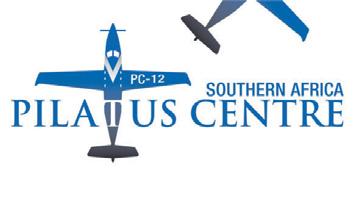
p

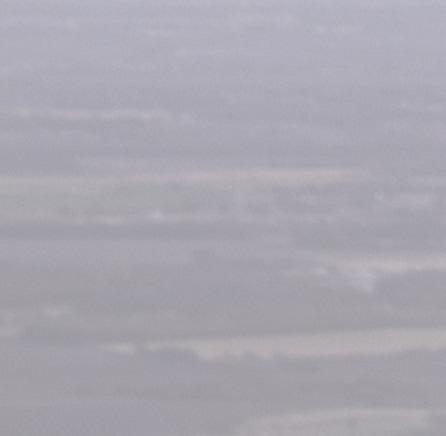
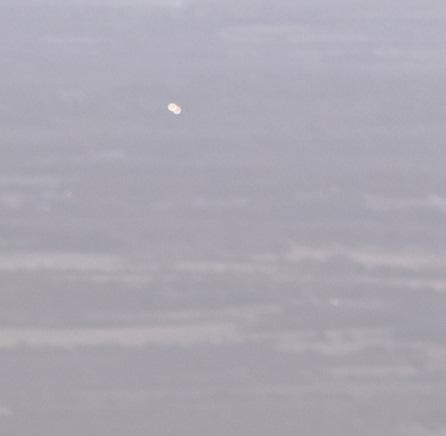












UNLEASH THE FULL POWER OF YOUR CARAVAN 208/208B DON’T SETTLE FOR LESS THAN THE BEST BLACKHAWK.AERO Transform your flights with a brand new PT6A-140 engine and take your revenue to new heights. Designed by pilots for pilots, this upgrade offers enhanced performance and power, so you can take advantage of 867 SHP in takeoff, climb, and cruise like never before.
POSITION REPORT
THIS SEEMINGLY MINOR JUDGEMENT
sheds light on several issues that reach far beyond the fate of yet another failed stateowned airline.
The judge went so far as to accuse Gordhan of acting irrationally. I reckon Gordhan is only acting irrationally if you take his words at face value.
Thabo Mbeki was accused of “Talking left, walking right”. With Gordhan the opposite is true. He claims to be in favour of the privatisation of select state owned assets, specifically the sale of a majority shareholding in SAA to Takatso - a private sector consortium. Yet all his actions – or lack thereof – suggest that he is doing his utmost to avoid privatising these assets.
differentiator – yet have paper thin margins that leave no room for the luxury of a ‘development mandate’.
And so we come to the ongoing saga of the sale of SAA to the Takatso Consortium. Despite claims and promises, Gordhan is blocking the deal, which has been in the making for over two years.
kick the whole thing down the road
Government promised that the deal would be concluded by end March this year, yet there are still large obstacles to be surmounted. These include: Changing the SAA Act of Parliament to allow ownership other that the state and the requirement to amend SAA’s AOC and IAS licences. Very little if anything has been done, despite a September comment saying that the SAA Act was to be repealed –which may be a somewhat heavy-handed start.
This judgement adds to the mounting evidence that Gordhan (presumably following the ANC party-line) has never had any intention to sell the remains of Mango – or SAA.
This defies the compelling arguments that, based on its track record, the current SA government could never successfully operate a low cost carrier airline. Of all the stateowned enterprises, airlines are the most difficult to operate successfully. They are skills and capital intensive and are intensely competitive with customer service being a key market
A further intriguing question raised by the Mango judgement is who on earth would want to buy the airline? It has no aircraft, as they have all been returned to the lessors. All the viable routes have been taken over by competitors. There are very few staff left. Yet a buyer is reportedly prepared to pay R326 million, and there is still the open question as to who will pay the balance of Mango’s debt.
The tangle of government, private sector interests, ideology and obscene profits makes the whole Mango/Takatso imbroglio a Gordian knot. My best guess is that Gordhan cannot begin to unravel it and is hoping to kick the whole thing down the road until after the 2024 election – or at least until April next year when he turns 75 and can gracefully retire.
j
Guy Leitch

In mid-September the High Court handed down a judgement compelling Minister Pravin Gorhan to decide whether to sell the remains of Mango airline - or not.


Asset Finance | Treasury | Working Capital | Investments | Private Wealth www.merchantwest.co.za Companies in the Group are licensed and authorized FSPs Specialised Finance. By Design. Fast. See the bigger picture.
THE MACAN S.
Five doors, five seats, yet incomparable and unmistakably Macan. With significant enhancements from the previous generation, the Macan S is contemporary, dynamic, urban and built for adventure and endorphin rushes on every drive. Experience the ultimate sports car SUV.

Macan S: Combined fuel consumption: 9.8 l/100 km; Power: 280 kW (380 PS); Torque: 520Nm; 0-100 km/h: 4.6 sec (with Sport Chrono); Top speed: 259 km/h. Priced from R1 555 000 including a 3 year/100,000 km Driveplan. Prices are subject to change without prior notice. E&OE. Porsche Centre Johannesburg Corner Witkoppen and Wroxham Road, Paulshof Telephone 011 540 5000 www.porschejohannesburg.com Porsche Centre Cape Town Cnr Century Avenue and Summer Greens Drive, Century City Telephone 021 555 6800 www.porschecapetown.com Porsche Centre Umhlanga 49 Meridian Drive, Umhlanga Ridge Town Centre, Umhlanga Ridge Telephone 031 514 3000 www.porscheumhlanga.com Porsche Centre Pretoria 452 Botterklapper Street, Off Lynnwood Road, The Willows Telephone 012 816 7600 www.porschepretoria.com Dare forward.

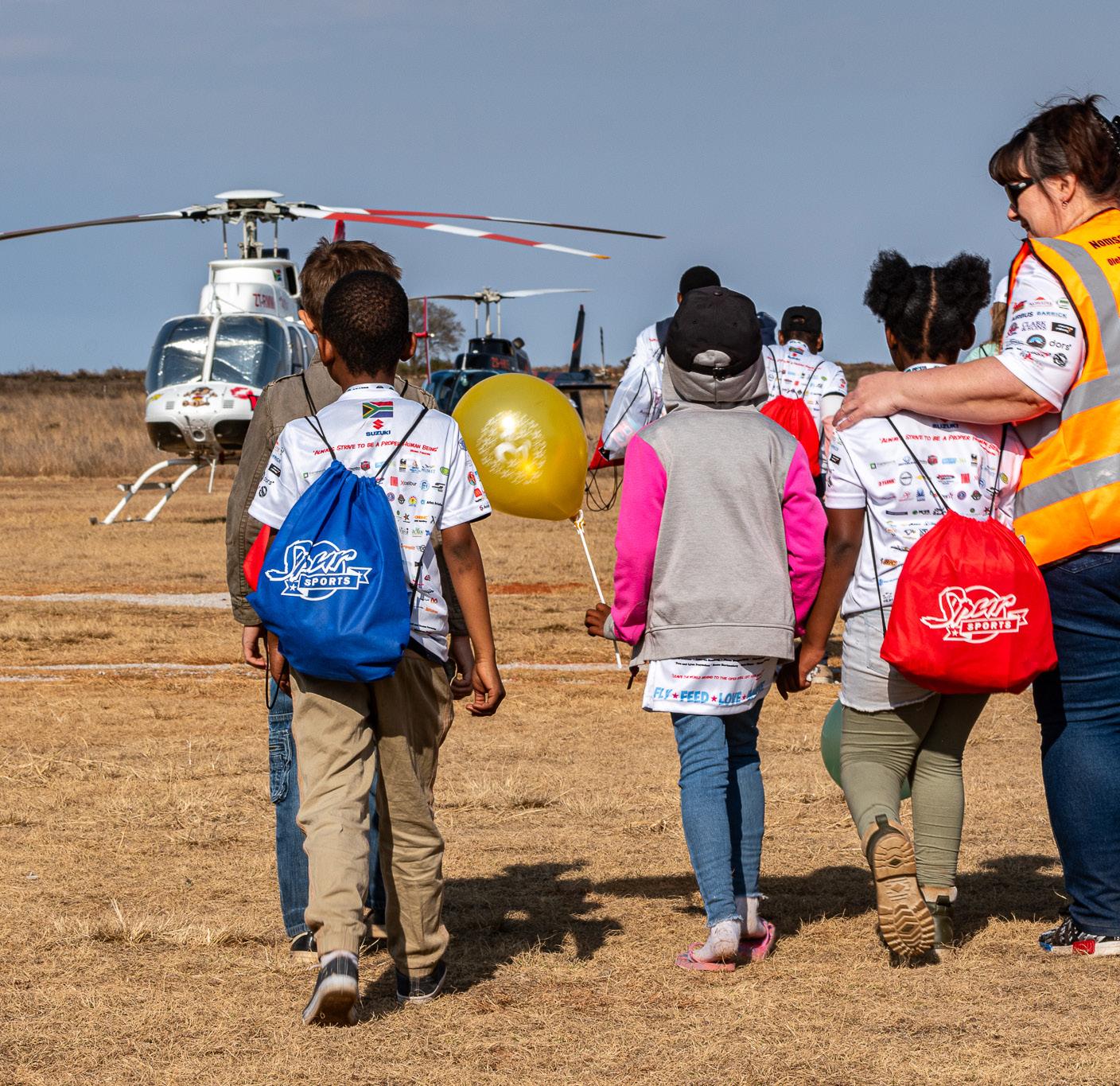

COLUMNISTS FLIGHTCOM 04 Bush Pilot - HUGH PRYOR 10 Pilots - LAURA MCDERMID Edition 331 FLIGHT TEST: SAF 66 CONTENTS SAF 36 THE GLORIOUS SA FLYER 16 Guy Leitch - ATTITUDE FOR ALTITUDE 20 Peter Garrison - KEEPING TIME 26 Jim Davis - RIGHT SEAT RULES 48 Jim Davis - ACCIDENT REPORT 52 Ray Watts - REGISTER REVIEW
PT6A FLAT RATE OVERHAUL (FRO)
tailBeaconX REDEFINING THE ADSB TRANSPONDER
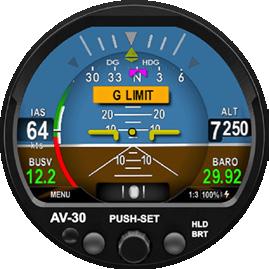
tailBeaconX combined with the AV-30 or supported third-party EFIS elevates your cockpit functionality while future-proofing your ADS-B transponder to meet South Africa, US, Canadian, and future ADS-B requirements. tailBeaconX replaces your existing transponder while upgrading your rear position light.
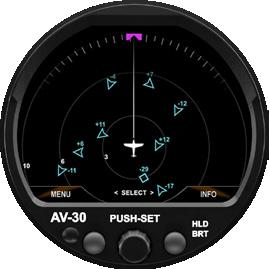

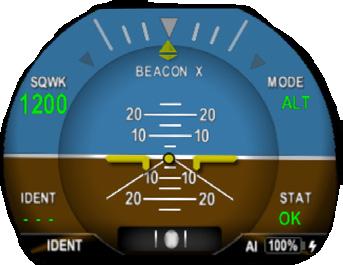


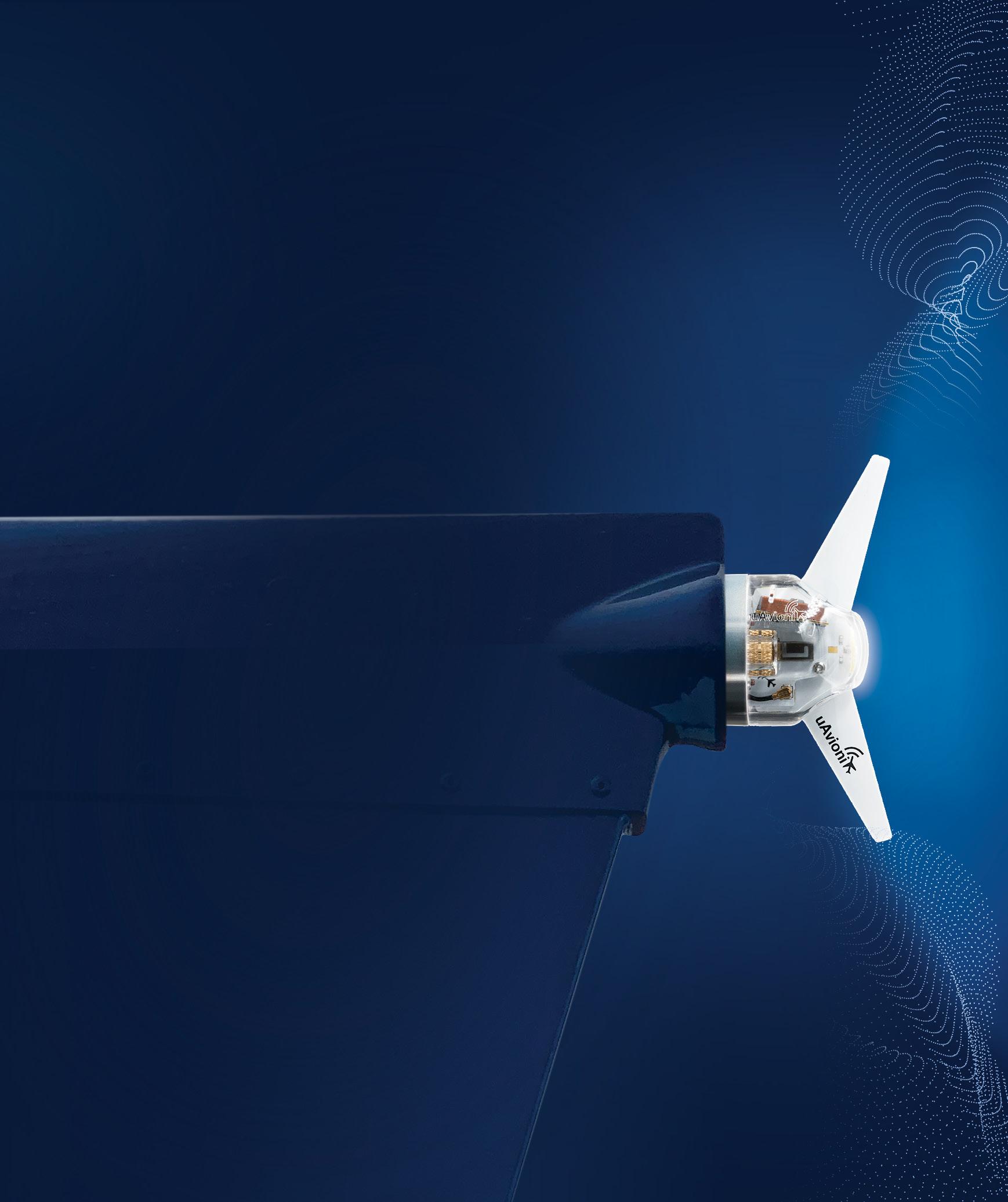
EASA Approved and Now Shipping
No surprise pricing
No compromise on quality No sweeping exclusions
No wonder it’s so popular!
StandardAero Lanseria, a Pratt & Whitney PT6A designated overhaul facility (DOF) and the sole independent DOF approved for the PT6A-140, is pleased to support operators across Africa with P&W’s flat rate overhaul (FRO) program, which combines OEM-level quality with guaranteed “not to exceed” capped pricing. Meaning that you can plan your maintenance expenses with confidence, and without any compromises.
StandardAero Lanseria, a Pratt & Whitney PT6A designated overhaul facility (DOF) and the sole independent DOF approved for the PT6A-140, is pleased to support operators across Africa with P&W’s flat rate overhaul (FRO) program, which combines OEM-level quality with guaranteed “not to exceed” capped pricing. Meaning that you can plan your maintenance expenses with confidence, and without any compromises.
The FRO program does not incur extra charges for typical corrosion, sulphidation or repairable foreign object damage (FOD), and PMA parts are accepted.
The FRO program does not incur extra charges for typical corrosion, sulphidation or repairable foreign object damage (FOD), and PMA parts are accepted.
As the industry’s leading independent aeroengine MRO provider, StandardAero is trusted by airline, governmental and business aviation operators worldwide for responsive, tailored support solutions. Contact us today to learn more.
As the industry’s leading independent aeroengine MRO provider, StandardAero is trusted by airline, governmental and business aviation operators worldwide for responsive, tailored support solutions. Contact us today to learn more.
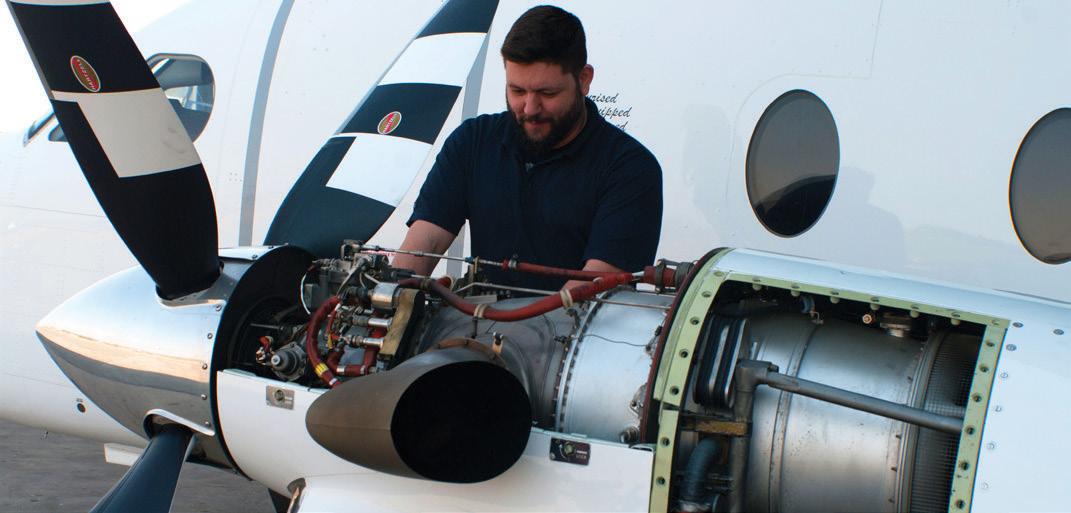

AV30 HIGHLIGHT S:
• PRIMARY AI
• PRIMARY DG
• PRIMARY SLIP
• GMETER
• PROBELESS AOA
• LIVE ADSB TRAFFIC
AV30 ADDONS:

tailBeaconX CONTROLLED WITH AV30
AV MAG STC
• EXT MAGNETOMETER
AV LINK
• WIFI/TRAFFIC
uAvionix.com/tbx


October 2023
BIGGER. BETTER. BOLDER. www.standardaero.com
No wonder it’s so popular! No surprise pricing No compromise on quality No sweeping exclusions www.standardaero.com


October 2023 10 12-14 Opening Shot 56 M & N Acoustic Register Review 64 Aero Engineering and Powerplant Aviation Fuel Table 104 Executive Aircraft Refurbishment Events Calender FLIGHTCOM 17 AME Directory 28 ALPI / BILL Flight School Listing 29 Merchant West Charter Directory 30 Skysource AMO Listing 32 Aviation Directory CONTENTS Edition 331 REGULARS FEATURES SA FLYER 32 FLIGHT TEST: THE GLORIOUS BEECH 18 60 LEADERS: CEOS REACHING FOR THE SKY 66 EVENTS: CHILDREN’S FLIGHT 2023 74 EVENTS: VIRGINIA AIRSHOW 2023 82 AVIONICS: FUNKE AVIONICS 84 EVENTS: KALAHARI BUNDU BASH PT2 94 BOOK REVIEW: POOLEYS #1 FLYING TRAINING 98 EVENTS: GRAND RAND AIRSHOW 2023 105 WONDERBOOM AIRPORT: AVIATION GUIDE 128 NEWS: H2FLY FIRST PILOTED FLIGHT FLIGHTCOM 08 News - Aeroflot instructs pilots - turn brakes off 14 John Bassi - Taming Taildraggers 18 Jeffrey Kempson - Dakota Gamblers Weekend 23 News - The Ural A320 forced landing 24 Jacqueline Mwende - Mission Flying 27 News - P&W’s GTF – a U$3 billion recall
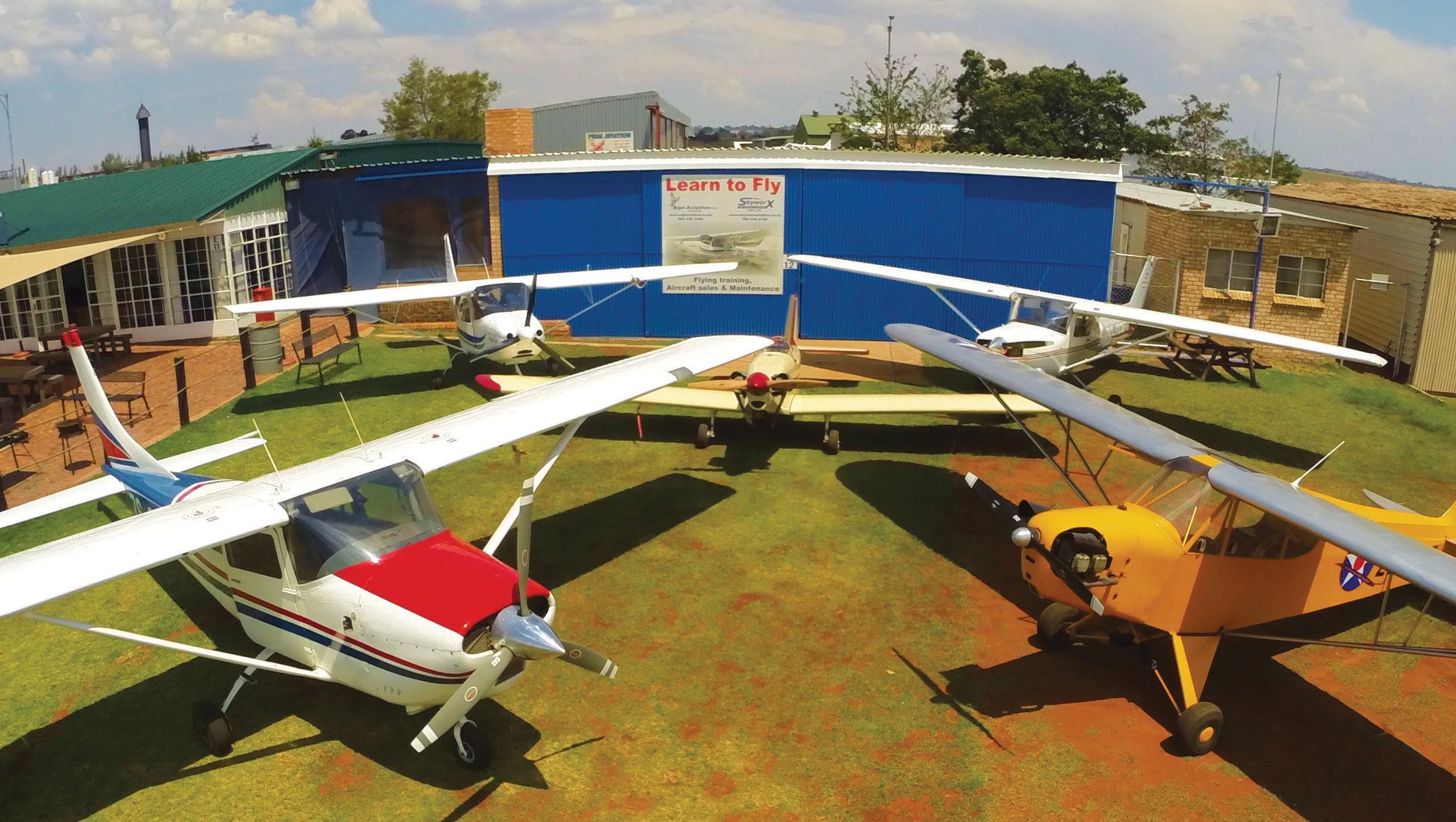







October 2023 11 WE NOW OFFER TAILWHEEL TRAINING www.alpiaviation.co.za Dale de Klerk Cell: +27825563592 Fax: 0866058948 Skype: dale_de_klerk Email: dale@alpiaviation.co.za FROM NPL THROUGH TO CPL LEARN TO FLY WITH US Bill Harrop’s ‘Original’ Balloon Safaris +27 83 457 3402 or +27 83 443 2661 / 2 • email: website@balloon.co.za • www.balloon.co.za Learn to Fly with Us • Magalies River Valley Scenic Balloon Safaris • Game viewing Balloon Safaris at Mabula Private Game Reserve • Private Balloons and Groups Rates • Team Building and Product Launches • We fly from the beautiful Magalies River Valley just west of Hartbeespoort Do it in style!

October 2023 12
THIS AMAZING OPENING SHOT IS GENUINE. There are no superimposed composite images – just dedicated and dogged camerawork – and coordination with the pilot and ground crew who made it happen.
The picture was captured by Martin Ashworth using a mirrorless Canon R3. He used a 400mm lens with an extender to give 560mm focal length. Exposure was f10 at an 800th second at an ISO of 2000.
This extraordinary image deserves a proper description of how it was created – please see the next page.

October 2023 13 Send your submissions to guy@saflyermag.co.za
MARTIN ASHWORTH TOOK THIS extraordinary photo of Jeff Richmond's Tiger Moth ZS-DHE on 30 August 2023, which was the evening of the Super Blue Moon.
Martin writes:
“Established in the mid-1960s, the Ladysmith Flying Club has been a stalwart of aviation in Northern KwaZulu Natal. Together with the Rainbow Flying School, owned and operated by Larry van der Merwe, which acts as a feeder school into the aviation industry, the club promotes flying at all levels. It has produced many competent pilots over the decades.
The club usually holds a braai on Wednesday evenings and on 30 August, the stars, moon, and Saturn lined up for a full moon party. Jeff Richmond, a long-time member of the club, and owner of the Tiger Moth, the Lady Dhee, has long wanted a photograph of the Tiger Moth with a full moon as her backdrop. This August, with its supermoon, was a good time to try!
Members met in the late afternoon and a briefing was held between the pilot, the co-pilot, Jeremy Robertson, the photographer, Martin Ashworth and the ground control operator Bertus Wheeler, who also happens to be the current President of the Ladysmith Flying Club and Flight School Instructor.
They selected an open spot on the field and after taking off, Jeff then started making passes over the photographer to compose the shot.
This shot was technically difficult for both the pilot and the photographer. The pilot had to imagine a flight path from the moon at altitude and the cameraman at ground level, and approach his position as if on a glide path but without the benefit of any runway lights or other technical wizardry. Lining up with the moon precisely behind the aircraft and the camera position in front required precision flying and the guidance of the ground crew. The moon in this scenario is such a small target to maintain in position.
The photographer had to position his camera on a tripod for stability and wait for the aircraft to cross the field of view with the moon as backdrop, a fraction of a second timing at best. He also had to continually compensate for the changing light as the sun faded and the moon rose, altering the contrast of a brighter moon against a dimming sky. Add to this the length of the lens being 400mm with an extender giving approximately 560mm focal length meant that the ISO setting eventually reached 2000.
Jeff flew out on an outbound leg, over the camera and directly towards the moon to establish the moon-to-camera angles. When the photographer was happy with the flight path, and seeing the angles worked, Jeff then did a 180 turn and tried to reconstruct the same flight in reverse. Directed by the photographer, ground control issued instructions to make corrections to the flightpath to put the Lady Dhee directly in front of the moon.
October 2023 14
fraction of a second timing at best
Losing light, and not having landing lights on the runway, doubt started to set in as to whether this was possible. On the fifth and last attempt, instructed to lose height, Jeff decreased altitude and the Lady Dhee crossed the moon at a perfect angle in a side-slip. Martin reacted instantly and the photograph was burned onto the camera's memory.

As most photographers know, a near-perfect photograph is almost impossible to capture, but the Ladysmith Flying Club crew succeeded above expectations. By the time Jeff and Jeremy were back on the ground and taxiing to the hangar, Mac and Eric had lit the fire, beers were opened and much celebration ensued.”
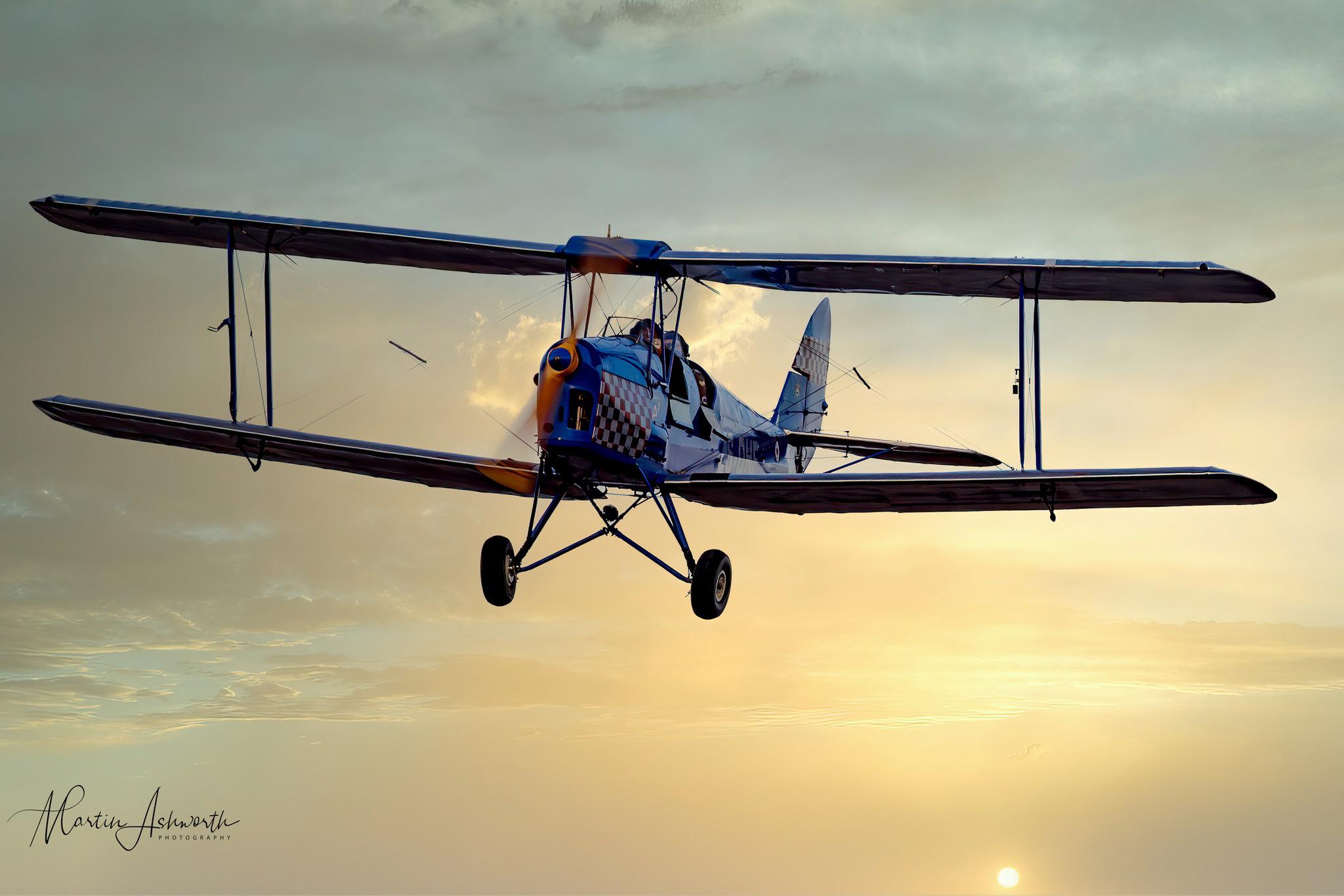
October 2023 15 Send your submissions to guy@saflyermag.co.za
Martin Ashworth is a passionate photographer.
Another striking image of Jeff Richmond's Tiger Moth by Martin Ashworth.
j
Martin Ashworth is a passionate photographer.
Step-Change Engine The
OUR CURRENT CROP OF super-efficient engines is the product of steady evolutionary development. The most recent happened around 2010 with the advent of the extra-large diameter high-bypass Pratt & Whitney geared turbo fan (GTF).
Five years later the GTF’s current competitor, the CFM LEAP engine first flew. It uses both hotter hot sections and bigger fans to achieve a 15 – 17% fuel burn improvement. These ‘next generation engines’ gave rise to the Airbus A320 NEO (for new engine option) and the Boeing Max.
With these ultra-high bypass jet engines there’s little room left for further development. Thus there is a widespread belief that any step changes will struggle to produce even a 10% fuel efficiency increase. This is due not only to the physical restrictions on the size of the turbofan but also to the cost and unavailability of the complex compound ceramic heat resistant materials (‘unobtanium’) required to achieve further efficiencies in the core of the engine.
And the fans have got as big as they can get for underwing installations on the Boeing 737.
Given the enormous cost, and the 10 - 20 years of development required to certify and deliver a step-change in engine technology, the next generation engine is already overdue. What makes the need for a revolutionary engine all the more compelling is environmental demands such as the CORSIA Programme and IATA’s net zero emissions by 2050 promise.

The delay is because the next step change is going to be, not just a big step, but in many ways a step backwards. The front runner for the new technology is the CFM open fan RISE engine. The CFM RISE (derived from the clunky acronym; Revolutionary Innovation for Sustainable Engines) goals include reducing fuel consumption and CO2 emissions by more than 20% compared to current generation engines and ensuring compatibility with sustainable aviation fuels (SAF) and hydrogen.
CFM has signed a deal with Airbus, which will lead to a demonstrator that’s expected to fly on an Airbus A380 ‘in the mid-2020s.’
October 2023 16
ATTITUDE FOR ALTITUDE: GUY LEITCH
a hitherto unheard of bypass ratio
About every seventeen years the airline industry is expected to produce a 17% saving in fuel burn from step-change improvements in engine and, to a lesser extent, airframe technology.
The RISE engines will look completely different. They feature huge unducted fan blades that look more like a ship’s propellor than a jet engine. Having unguarded blades slashing about like a kung-fu fighting movie means that the engines must be far from the vulnerable parts of the aircraft like wing fuel tanks or the passenger cabin. And they have to be mounted high enough for people not to walk into. This will require all-new airframes to accommodate these engines. The most likely solution is to mount the RISE high up on the tails, like the old DC-9, or bizjets.

The surprising thing is that the RISE is an old idea reheated. In the quest for efficiency there is little that has not already been tried. And so it is with the RISE engine.
The GE36 first flew on a Boeing 727 and on both a DC-9 and an MD-80, with the latter aircraft flying at the 1988 Farnborough Airshow.
unguarded blades slashing about
Around the same time Pratt & WhitneyAllison also tested their open rotor propfan concept. Initial results were not promising. It was considered too large, too heavy and too expensive. And, thanks to supersonic fan blades, it howled like a Stuka dive bomber. The big challenge was to keep the fan blade tips below supersonic speeds. This was largely achieved in 2007, when the Progress D-27 propfan engine developed by Ivchenko in Ukraine met FAA / ICAO Chapter 4 noise standards.
GE Aviation began working with NASA on the unducted fan in the early 1970s. They called it the not very catchy name of ‘Quiet Clean Short-Haul Experimental Engine (QCSEE)’ demonstrator, and it was the first high-bypass geared turbofan engine. In the mid-1980s, it had evolved into the GE36 or Unducted Fan (UDF). French engine builder Safran, (then Snecma), was part of the development and testing.
This achievement re-invigorated the unducted fan and in 2012 a study projected that noise would be 10–13 decibels quieter than allowed by the Stage 4 regulations. The study also projected that open rotors would be nine percent more fuel-efficient but remain 10–12 decibels louder than turbofans. Undaunted, Snecma claimed that its propfan engines would have about the same noise levels as its CFM LEAP turbofan engine.
October 2023 17
Airbus proposes testing the latest generation unducted fan on an A380 within the next 2 years.
It was not just noise levels, but blade failures which were another huge concern, especially due to that old bugbear flutter, induced by the complex airflow patterns to and through the fans and the broad airspeed and tip speed range the fans would have to cope with.
But still the big issue was the bottom line. After the oil crisis of the seventies, fuel prices dropped dramatically in the eighties. What with the huge engineering challenges, an unholy howl, and low fuel prices, the unducted fan was quietly shelved. But now – under sustained pressure from climate-change activists, the need for reduced carbon emissions is just as compelling, if not more so, than just plain old fuel efficiencies.
levels even relative to today’s state-of-the-art engines. We have also been able to reduce both the complexity and weight of the engine while maintaining significant performance benefits.”
The current RISE design is for 30,000 lb thrust which aims it squarely at the competitive singleaisle market dominated by the A320 and Boeing 737 families. However, CFM points out that there is plenty of scope for up-scaling both the fan blades and power core.
RISE is an old idea reheated
So why now, 40 years later, is the unducted fan making a comeback? The big idea is that the unducted fan combines the fuel efficiency of a turboprop with the speed and performance of a turbofan. CFM says; “the RISE is nothing like a turboprop engine. It will be able to fly at up to Mach 0.8, with a noise signature that will meet anticipated future regulations. An open fan configuration can achieve improved noise

The new engine will use a compact high-pressure core and a recuperating system to preheat combustion air with exhaust heat along with ceramic matrix composites in the hot section. Lightweight resin-transfer-moulded composite fan blades are the big innovation. The design includes a nonrotating set of variable-pitch stator blades that act as flow recovery vanes. The design increases the fan-pressure ratio and reduces rotor loading, increasing airspeed.
To keep tip speeds down, the fan is driven by a high-speed compressor mated to a lowpressure-shaft-driven front gearbox. The whole power unit will be certified as an “integrated
October 2023 18
The GE36 on a McDonnell Douglas MD-80 demonstrator at the 1988 Farnborough Air Show.
engine” instead of the traditional propeller and engine because of its airframe integration complexity.
Thanks to the smaller engine core, the CFM RISE should have a bypass ratio of a hitherto unheard of 75. CFM claims that open fan architecture enables a much higher bypass ratio and, as a result, delivers much higher propulsive efficiency. The engine maker hopes that “achieving 20% better fuel efficiency has the potential to be the single greatest generational improvement in fuel efficiency that we’ve ever achieved.”
Unlike the complex contra-rotating fans of the earlier GE36 UDF, the RISE features a single rotating fan, with variable pitch carbon fibre blades. Ahead of the fan (in a pusher configuration) is a row of static guide vanes.
Since the 1980’s the development in engine technologies, particularly in the power core, has carried through to the unducted fans. CFM says this enables open fans, “but at very low noise levels and smaller dimensions to make it easier to integrate with the airframe.”
The investment in the RISE engine is big, even by aerospace standards. CFM’s parent companies, GE Aerospace and Safran Aircraft Engines, have more than 1,000 engineers globally supporting the development of RISE technologies.
Conclusion
About a year ago I wrote about the massive efforts being put into hydrogen powered airliners. Given this huge re-emergence of interest in unducted fan technology, and the thousand engineers working on it, there will be a race between hydrogen power and unducted fans to power the next generation of airliners.

Who will win is an open question. What we do know is that the next generation will be a step change almost as large as the switch from propellors to jet powered airliners. j
guy@saflyermag.co.za

October 2023 19
The shape of planes to come - this is the 'Clean-Sky IRON project'.
SCENES FROM THE “LOVELY WAR”
THUS ALVIN KERNAN, a Grumman TBF Avenger gunner in the Pacific during World War II (and later provost of Yale University and dean of Princeton’s graduate school), described what historian John Keegan called “the characteristic physiognomy” of fighter pilots.

Keegan quotes the passage in a book about the First World War. Kernan hadn’t seen those pilots; but it is likely that they looked much the same in both world wars. Perhaps Spartan hoplites looked this way at Thermopylae. At any rate, I happened upon the description shortly after seeing a screening of a film, Flyboys, about American pilots in that war.
The characters in the film, not surprisingly, do not have that chronically tormented look, and with a single exception they fly and fight with the jolly nonchalance that stories of white scarves and sportsmanlike conduct have led us to associate with the pilots of World War I.
Flyboys concerns the so-called Lafayette Escadrille, originally known, until Germany
protested the interference by a supposedly neutral nation, as the Escadrille Américaine. The French word escadrille, which is related to the English squadron, means “flight” in the sense of a group of aeroplanes. Lafayette was the French marquis who fought on the American side during the Revolutionary War, and the American pilots who joined the Escadrille, long before the United States entered the war in its final stages, saw themselves as returning the favour.
Most wars have a cause that can be expressed in 25 words or fewer, but the cause of World War I is mysterious. Perhaps merely to demonstrate the obsolescence of horses and the superiority of tanks and aeroplanes, men crouched for years in muddy trenches, emerging from time to time to slaughter one another in the tens of thousands.
This was the war in which all the future military applications of aircraft made their debuts. First airborne scouts reconnoitred the movements of enemy troops, a role that had previously belonged to tethered balloons. Armies that did
October 2023 20
“... skeletal hands, sharpened noses, tight-drawn cheek bones, the bared teeth of a rictus smile and the fixed, narrowed gaze of men in a state of controlled fear ...”
PETER GARRISON
make a flywheel unnecessary
not want their movements observed sent up aeroplanes to discourage the spies, and opponents then sent up escort aeroplanes to destroy the interceptors. A new battleground, the air, unused since the fall of Lucifer, came into being. What the duels of little aeroplanes lacked in fundamental military impact – scholarly surveys of the war make scant mention of its aerial component – they supplied in drama, adding a touch of glory, like the pink glow of sinking sunlight on clouds above an already darkened landscape, to the dismal slaughter below.

Taken on its own terms, however, the pace of aeronautical progress during the war was astonishing. Almost immediately, rickety openwork stick-and-wire sporting and exhibition aircraft began to evolve into compact, streamlined, manoeuvrable and robust biplanes powered by efficient, light, powerful and sophisticated engines whose power-to-weight ratios were comparable to those of modern recips. By the end of the war, builders had already arrived at the highly streamlined airframes of Pfalz and Albatros, the woodsurfaced cantilever monoplane wing of the Fokker D.VIII, and the liquid-cooled vee engines that, along with the later introduction of the aluminium monocoque airframe, would pretty much define military aviation until the arrival of the jet engine.
The dominant engine type of World War I was the rotary. Its story is a curious one. A fivecylinder rotary built into the rear wheel of a motorcycle had been exhibited in Paris in 1889, but the engine was developed for aeronautical applications by three brothers named Seguin, whose grandfather had constructed the first French locomotive in 1829. They called their company the Société des Moteurs Gnôme
– “Gnome Motor Company” – apparently alluding to the legendary race of hardworking subterranean dwarfs who also lent their name to the “gnomes of Zurich” beloved of the financial pages.
The Seguins had experimented in 1906 with a five-cylinder fixed radial of 34 hp before switching, in 1907, to the rotary configuration, presumably to provide air cooling in stationary use and make a flywheel unnecessary. What set the rotary apart from other engines of the time was its combination of effective cooling with light weight. Fifty-horsepower Gnôme engines, meticulously made and very expensive, were phenomenally successful, 4,000 being sold even before the outbreak of the war. By 1914, the engines were being manufactured under license in several European countries, and a 100-hp version with a two-stroke-like breathing
October 2023 21
The Flyboys movie was made by a pilot who tried hard to make the flying scenes realistic.
arrangement, the so-called Monosoupape (“single-valve”), had been added to the Gnôme product line.
Eventually other manufacturers, notably Le Rhône and Clerget, developed their own designs. Gnôme and Le Rhône would merge in 1915, but continue to produce both engine types.
The idea of the rotary was to fix the crankshaft to the airframe and the propeller to the crankcase, allowing the latter to rotate, along with cylinders, pistons, manifolds, and valve train. In some ways this arrangement was inconvenient. Lubricating oil, pumped centrifugally to the cylinder heads, could not return to the crankcase, and instead simply blew overboard. Rotary-equipped aeroplanes had large oil tanks and filled them before each flight. Castor oil, beloved of regularity-obsessed English nannies, was used, being the best lubricant available. Supposedly – this may be a canard – the laxative effect of the cloud of vapor
in which pilots flew sometimes brought about some early landings, on which side of the lines I do not know.

Gnôme cylinders, machined from solid bars of nickel steel, had a wall thickness of about a sixteenth of an inch and were prone to thermal distortion because the leading sides of the cylinders cooled better than the trailing ones. The engines had to be overhauled – a simple job, fortunately – every ten or fifteen hours. When W. O. Bentley of auto racing fame designed a new rotary for the British Admiralty, it had aluminium pistons running in cast-iron liners shrunk into aluminium cylinders, an arrangement that improved both cooling and rigidity and eventually permitted an output of 230 hp, about the maximum developed by any rotary.
By the end of the war, France had produced 40,000 rotary engines, with comparable numbers being manufactured in England and Germany. The United States lagged behind, producing only 28,000, perhaps because the
October 2023 22
Pilots were given guns to shoot themselves if their planes caught fire.
land of Henry Ford lacked the conservative culture of artisan manufacture that still existed in Europe, and particularly in France, and that was critical for the production of engines that were, in important respects, hand-built. Something similar happened in World War II, when Packard, after trying in vain to make sense of British blueprints for the Merlin, eventually redesigned the engine from scratch for mass production.
Among many curious aspects of the rotary engine is its utter disappearance after the war. Half the aero engines manufactured during the war were rotaries; after it, none. Historian Andrew Nahum argues that the Achilles heel of the rotary was its inability, for various reasons including its system of air induction through the crankshaft, to be scaled up beyond a certain point. In his view, rapid improvements in the power-to-weight ratio of fixed engines eventually doomed the quirky and cantankerous rotary –but not before the rotary had powered most of the small fighters and scouts of the war.

The film Flyboys was directed by Tony Bill, himself a pilot and formerly owner of a SiaiMarchetti 260. Bill seems to have been at pains to ensure the realism of aerial sequences. Inevitably, these passages involve a good deal of computer enhancement; most of the aeroplanes you see don’t actually exist. Sometimes the computer people go overboard, crowding the sky with improbable numbers of aeroplanes in impossible proximity to one another and dreaming up tactics, like headon encounters of tight formations that skim through one another with the precision of the Thunderbirds, that I doubt could have been of much use in actual warfare.
The speed and vertical capability of the aeroplanes is exaggerated – forgivably, considering the expectations of an audience conditioned by video games. But a number of the duels of single aircraft convey a plausible picture of fighter tactics that satisfy contemporary pilots’ sense of the dynamics and behaviour of real aeroplanes.
October 2023 23
The Gnome rotary engine was a masterpiece of engineering.
The script kills off its characters with a regularity appropriate to a conflict in which the life expectancy of fighter pilots was measured in weeks.
In one scene, new recruits are issued pistols with the advice that a bullet to the head might be preferable to riding a burning aeroplane to the ground. I don’t know whether there is a historical basis for this detail. In another, a pilot falls (or jumps) – they didn’t have parachutes – from his stricken aeroplane; this was, in fact, the fate of Raoul Lufbery, one of the first aces of the Lafayette Escadrille.

There are several instances of the gallantry toward a defeated or disabled enemy that is often presented as a hallmark of that war, though it actually shines here and there all
through military history, alternating with the rather more prevalent pattern of compulsive butchery.
Most of the characters in Flyboys don’t seem to mind dying. Indeed, a nearly psychopathic indifference to death, or confidence in one’s own good luck, would be required for someone to leave the peaceful confines of the distant USA to get shot at in a Nieuport 17 over France. That a few pilots survived long enough to record great numbers of victories while others died almost as soon as they began fighting suggests that this was an activity for which some people had far more talent than others. To be one of the less talented ones, and realise that you have stumbled into combat with one of the more, must have given a sinking feeling.
October 2023 24
overhauled every ten or fifteen hours
j

THE SOMETIMES SURPRISING EFFECTS OF THE CONTROLS.
I WORM MY WAY UP TO THE FRONT – it’s sort of allowed because I know the driver. I’ll call him Fanie because if I tell you his real name he will have me cost-rated – I think that’s what he said.
The cockpit is scary. It’s as if you are about to swing a leg over your Harley when you spring back in horror. Some nut has replaced the round clocks with TV screens, turned all the switches upside-down and, worst of all, stolen the handlebars. There’s nothing to hang on to.
We are climbing out at an impressive angle into a crystal blue sky. I am much puzzled by many things in the cockpit, but the ones that have really grabbed my attention are the thrust levers, or throttles, or whatever you call them.
I ask Fanie about them and he tells me that I must rid myself of foolish old-fashioned thinking like that. They are not thrust levers at all – they are actually three-position switches. He explains that for instance nothing will happen if he pulls them back – like this…
He is quite wrong. Lots of things happen simultaneously and alarmingly. The aeroplane’s nose sags below the horizon as if we have gone over the crest of a wave on a fishing boat. We are light in our seats. The whole thing goes all soggy like a hot-air balloon that has been shredded by a thousand drones.
At the same time the first officer, an earnest youth with glasses who had been fiddling with the typewriter, looks up in horror.
“No, no, NOOOO, Captain, we are in Alternate Law Five with the push/pull interconnect setting programmed through the FMC to maintain airspeed, when the CADC overrides the aft toilet smoke detector.”
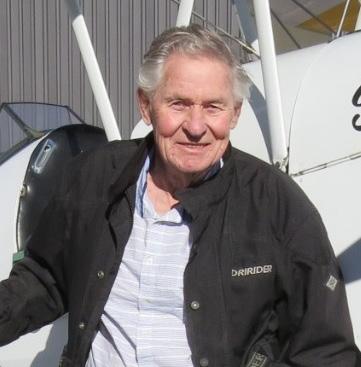
I told you this story for three reasons really:
1. It’s critically important that when you are around aeroplanes never do anything in a hurry.
2. The controls don’t always do what you expect.
October 2023 26 PLANE TALK - JIM DAVIS
“Of course. Silly me!”
So it’s the mid 1990s, I think – I’m not good with dates and times. I am flying from Jan Smuts to Port Elizabeth in one of SAA’s new Airbus A320s. Tupperware aeroplanes I’m told. Those were the days when SAA was still ranked amongst the world’s top airlines.
RIGHT SEAT RULES NO. 10
examples of aeroplanes behaving badly
3. I thought Airbusses were meant to make things easier for pilots. I’m sure they do if the pilot remembers all the rules – which is not easy.

I have a few more examples of aeroplanes behaving badly, and not doing what you expect. Like when you are on the edge of a stall and she drops a wing, and you try to pick it up with opposite aileron. And the stupid wing drops further and will probably drag you into a spin..
next couple of minutes you realise that you are in for a forced landing – the power just keeps fading. You lob down in a field, or on a farm road and congratulate yourself on doing a good job.
the guts of the pre-flight briefing
Or when you are flying a C150 or a 172, and you have to keep adding power to maintain altitude. Suddenly your pilot brain springs into action. Of course – you need carb-heat. You yank out the knob expecting an increase in power, but what happens? You lose 600 revs and the whole bloody aircraft starts shaking. Of course, quick-as-a-flash you whack in the carbheat and regain most of the power. But over the
Actually not. You were wrong to expect carb-heat to give you more power. It will eventually, but first you must expect a drop in power for two reasons:
• The hot air going into the carb is much less dense than the normal air – so it’s like flying on a hot day, or at high altitude. You get less power.
• The ice in the venturi has been allowing less air through so the mixture is too rich. Suddenly you feed less-dense hot air into the system and the mixture becomes much too rich – so the engine wants to die,
October 2023 27
Obviously the longer you let the ice accumulate the worse it becomes and the more severe the reaction when you do eventually use carb-heat.
Gee – that was a long story about controls not doing what you expect. And here’s another common one.
If you think you are Bob Hoover doing a wing over after a beat-up (see the accident report on page…) and you add rudder to get yourself round more positively, the secondary effect will invert you.
This is not wishy-washy theory – it’s pure aerodynamics and physics. In three consecutive annual airshows, in the late ’60s three pilots died in front of massive crowds while doing wingovers. One was Henry Hunt with three pax in a 200HP Beech Musketeer, another was also a Musketeer – a 150HP Sport, and the last one was at Parys – I think in a Bonanza.
There are two reasons why a beat-up and wingover is such a common way of plummeting to an early grave.
• It looks so easy that everyone and his butler can do it.
• The controls behave normally relative to the aircraft, but the aircraft is steeply banked and you have not thought it through.

Here’s what happens. You stuff the nose down, zoom along the runway, past your worshipers, looking back over your left shoulder to see their waves and happy smiling faces. Then you pull up sharply into a steep climbing left turn.
Okay let’s freeze-frame there for a moment. You are a couple of hundred feet up, almost at right angles to the runway with 70° of bank, but this turn is going to take you over the heads of your devotees instead of in front of them, so you need to tighten it up quite a lot.
You use left rudder and it does what it always does – it moves the nose towards the left wingtip. That means down. And the further effect of the left rudder as I will explain shortly is to bank (or roll) the aircraft to the left. This steepens the already steep bank – often to the extent of inverting you.
October 2023 28
It's only when the aircraft is straight and level that pulling the yoke back makes the nose go up.
Of course you don’t like this, so you use right aileron to prevent the bank from increasing
You are looking over your shoulder again to see how you are doing with lining up in front of your admirers.
Now you are low, the nose is dropping and you are banked far more steeply than you have ever been before. Your airspeed has died away, the stall warning is shouting and you have lost half of your 200’.
Whether the aircraft flicks into a spin or not – the result is the same – you are going to smack into the countryside.
As my Nav instructor in the RAF used to say, “A dead pilot is a burden upon the Treasury and an eyesore upon the landscape.”
I did tell you that you will probably never need to think about the effects of the controls again unless you go in for aerobatics or instructing. So, as you are planning to instruct, follow me closely as we look at the “further” effects of the three main flying controls.
I’ll give you the guts of the pre-flight briefing and the patter (in blue again).
we are doing 105 knots and the rev-counter shows 2300 RPM. If I ease the stick forward, like this, the airspeed increases, (point at the ASI) because we are going downhill. You can also hear an increase in the revs, and in the slipstream noise. (point at the rev-counter). And if I ease the stick back, like this, the airspeed decreases (point at the ASI again) because we are going up hill. You can also hear a decrease in the revs and the slipstream noise (point at the rev-counter).
This is very important because, in light aircraft, we use the elevator to control the airspeed. This applies not only to straight and level but also to climbing and gliding. If you are going too slowly you ease the stick forward to increase airspeed, and if you are going too fast you ease the stick back and the airspeed will decrease.
This may seem counterintuitive – you probably expect to use the throttle to control airspeed, but we actually use the throttle to climb or descend. We will come back to this during your lessons on climbing and descending.
Notice that the airspeed does not respond immediately – it takes a little while to overcome the aircraft’s inertia.
The Further effect of the Elevator
Remember I told you that if you ease the stick back like this (demo with your model in the briefing) the nose moves in the direction of the cabin roof, and if I ease it forward the nose moves in the direction of the undercarriage.
This always applies regardless of the aircraft’s attitude. But the elevator has a further (indirect) effect that applies if you start from straight and level – which is the majority of your flying. Here’s how it works.
Notice that we are now straight and level – and
In the light of the accident report on page 52 I would like to tell you more about the further effects of the ailerons and rudder that we started looking at last time.
Further effect of the Ailerons
Remember I told you that if you ease the stick to the right, like this (demo with your model in the briefing) the right aileron moves up, reducing the lift and drag, while the left one moves down, increasing the lift and drag. This causes the aircraft to roll to the right (as we saw previously). But the difference in drag actually pulls the nose in the direction of the left wingtip.
October 2023 29
he can hardly deal with spiral dive recoveries.
This undesirable yaw, in the opposite direction to the movement of the stick, is called “adverse aileron drag”. You will learn how to counteract this when we do the coordination exercise.
So, to summarise, when you move the stick to the right, the aircraft rolls to the right and yaws to the left.
Now the aircraft sideslips to the right, and this causes it to weathercock and yaw to the right. This means the nose moves in the direction of the lowered right wing. So we start losing height in a right turn. In other words, using right aileron eventually results in a spiral dive to the right.
(Note: keep this demo gentle otherwise you will (a) frighten the pupe, and (b) run out of time to talk your way through it.)
Now the idiotic AIC tells you that you must talk the pupe through the spiral dive recovery. Forget it – he hasn’t even learned to fly straight and
level yet, so he can hardly deal with spiral dive recoveries.
So that’s the further effects of the aileron.
Now let’s think about the rudder.
The further effects of rudder
Remember that the right rudder moves the nose in the direction of the right wingtip – so the nose yaws to the right. This means the right wing slows down and the left wing, on the outside of the turn, speeds up and gets more lift. The result is that as the aircraft yaws to the right, it also immediately banks to the right.

If you maintain right rudder the nose will continue moving in the direction of the right wing – in other words down, and to the right.
The result is a spiral dive to the right – the same as the secondary effect of aileron – but for a totally different reason.
October 2023 30
You use aileron to turn - not rudder.
Again demonstrate this very gently to avoid alarming the pupe and to allow yourself time to talk your way through it as it happens.
Here’s a quick summary of the further effects of the controls if you start from straight and level.
CONTROL EFFECT FURTHER EFFECT
ELEVATOR PITCH AIRSPEED ALTITUDE AILERON ROLL SPIRAL DIVE RUDDER YAW SPIRAL DIVE
Now we come to the interesting bit – how we use the controls for normal flight on a day-to-day basis.
The elevator
We use the elevator to control the airspeed whether you are flying straight and level or climbing or descending. Don’t expect an instant response – the rate at which the speed changes depends on the inertia (basically the mass, or weight, of the aircraft).
Heavy aircraft and big jets are so slow to respond that the pilots have to use thrust to change the airspeed – but that’s not for us in our puddle-jumpers.
We also use the elevator to prevent the aircraft from losing height when turning.
The ailerons
We use the ailerons to either deliberately bank the aircraft, usually for entering a turn, or to keep the wings level in turbulent conditions.
The rudder
This is the interesting one. Ask a dozen pilots why aeroplanes have rudders, and you will get a dozen blank looks, followed by vague mutters about you need a rudder to turn the aircraft, duh.
But actually you don’t. The aircraft will turn very happily without rudder. In fact next time you are in a turn, even a steep turn, take your feet
off the rudder pedals and see what happens. Absolutely nothing. The ball will stay in the middle and she will keep turning happily.
In fact, the rudder is not there to turn the aircraft – it has three main purposes:
1. To deliberately sideslip. We’ll deal with sideslips later.
2. To counteract ‘P’ effect which is yawing caused mainly by the propeller’s slipstream.
3. To counteract adverse aileron drag. As you move the stick to the right to start a right turn, remember that the right aileron moves up and the left one moves down –causing drag like a flap. So the nose yaws to the left. So the rudder is there to counteract that undesirable yaw in the wrong direction. When you are established in a turn the ailerons are pretty well neutral – so you don’t need rudder. But you do need it again as you use aileron to roll out of the turn.
So the rudder is there to counteract two design problems that affect us every time we fly – ‘P’ effect from the propeller slipstream, and adverse aileron drag
We will talk more about the ‘P’ effect during the climbing and descending exercises. And more about aileron drag during a coordination exercise which we will look at next time. Strangely this is not in the syllabus, but good instructors, like us, teach our pupes how to use the rudder properly.
October 2023 31
good instructors, like us
j
THE GLORIOUS

October 2023 32 FLIGHT TEST: THE BEECH 18
Guy Leitch with Flippie Vermeulen • Images Garth Calitz and Tim Homan.

October 2023 33
The Beech-18 is indeed a grand old classic - but that long nose is really useful. Image Tim Homan.
The Birth of a Classic
In the early 1930s the Bureau of Air Commerce (the progenitor to the FAA) challenged plane makers to build a twin-engine small transport plane for general commercial use. There was also a need for a fast, company executive plane.

Walter Beech rose to the challenge and his Beech 18 design neatly filled the gap between the 3- to 5-passenger single engine high performance singles such as the Beech 17 Staggerwing and Spartan Executive, and larger twins such as the Douglas DC-2/3’s, which carried up to 21 passengers.
The prototype Beech 18 made its first flight on January 15, 1937. It followed the then dominant design philosophy of having twin vertical tails – one behind each engine. This had been
popularised by the Lockheed Model 12 Electra Junior, which is a scaled-down version of the Lockheed Model 10 Electra, the plane in which Amelia Earhart disappeared in 1937.
The first Beech 18s sold for $30,000, which was just more than twice the price of the Beech 17 Staggerwing. The first Beech 18s were powered by either two 330 hp Jacobs L-6s or 350 hp Wright R-760Es. The 450 hp Pratt & Whitney R-985 became the definitive engine from the pre-war Beech C18S onwards.
The Beech 18 (which is also often just called the ‘Twin Beech’) turned out to be a huge success, with over 9,000 produced between 1937 and 1969. The 32-year production run was a world record at the time, making it one of the most widely used light aircraft. In comparison, Beech only built 745 Staggerwings.
October 2023 34
The Beech 18 as the AT-10 - a plywood covered trainer in WW2.
Ask any Harvard owner - there is nothing as cool as owning a radial taildragger – other than owning a twin radial taildragger.
The Beech 18 soon proved its versatility as a civilian passenger and cargo aircraft, on tailwheels, nosewheels, skis or floats. During World War II, the Beech 18 was modified with glass noses into the military AT–7 Navigator and the AT–11 Kansas. These were trainers in which most American navigators and bombardiers learned their skills. Some AT–11s even got a top gun turret with a .30-calibre machine gun for training gunners.
An unusual variation was the AT–10 Wichita, which was a two-place, plywood-skin version of the Beech 18 in which more than half of the Army’s multiengine pilots received transitional training. Also, as the C–45 Expeditor, the aircraft was used to transport high-ranking officers and other personnel.

After the war, civilian production resumed in late 1945 with the highly evolved Model D18S, the first aircraft to be certified post-war.
A significant and easily seen improvement was the result of a complaint from Walter Beech. During an in-flight visit to the toilet of a D18S, Walter didn’t have the headroom needed to pee standing up. So, the cabin height on subsequent models was increased by six inches, creating the larger E18S. This and subsequent models were called Super 18s. The final version was the G18S with a MTOW of 9,700 lb, although later individual examples such as ZS-OIJ, which is an E18S, were approved for a take-off weight of 10,100 lbs, which made it an even more versatile aircraft. A total of 155 of this model were built until construction ended in 1970 with a last Model H18 going to Japan Airlines.
What is noteworthy is that the Beech 18 continued in production for five years after the King Air 90 had been on the market. So even though the small King Air pressurised turboprop had been designed as a replacement, the venerable pre-war Beech 18 soldiered on.
October 2023 35
Almost all Beech-18s have ultra-reliable Pratt & Whitney R985 450 hp engines.
the venerable pre-war Beech 18 soldiered on
On the Ground
For pilots transitioning from singles, the Beech 18 appears big – with its reach-for the sky tailwheel stance and big round engines. Our test flight example is one of the later Super 18s, ZS-OIJ, which is owned by Flippie Vermeulen of Springbok Classic Air at Rand Airport. With a maximum all-up weight of four and half tons, a wingspan of 14.5m and its two round engines, the Beech 18 is a mini airliner.
Like most Beech-18s, ZS-OIJ’s engines are the very reliable Pratt & Whitney R-985-AN14B supercharged nine-cylinder air-cooled Wasp Juniors. They each produce 450hp at 36 Hg manifold pressure and 2,300 rpm. They drive two-bladed Hamilton-Standard Hydromatic metal constant-speed props.
Each engine has its own independent fuel system consisting of three tanks in each wing, totalling 318 gallons, effectively giving it an endurance of nearly eight hours or a range of 1,100 nautical mile with one hour reserve.
If the plane has been standing for a while, the first task is to ensure that there’s no hydraulic lock in the engines from oil having run down into the lower cylinders. The recommended procedure is to pull each engine through nine prop blades. A sturdy back and shoulders helps.
Unusually for a radial of that vintage, on most of the early B18 aircraft the carburettor air intakes are mounted inside the cowls, in between the cylinders while the intakes for the oil coolers are in the wing’s leading edge, inboard of the engines. To improve engine performance on the higher gross weight E18S, ZS OIJ’s air intake is underneath the engine cowl. These intakes need to be thoroughly checked for birds’ nests during the pre-flight. A notable absence in the Beech-18 is that it does not have oil and air filters (although it does have an oil screen). This makes it unsuitable for operation of dusty dirt strips, especially ZS OIJ with the carb air intakes close to the ground underneath the engine cowl.
The wings are built in three sections: the centre section is integral with the fuselage and carries the engines and main undercarriage. It features

October 2023 36
The panel of ZS-OIJ has been much rearranged to improve the ergonomics. Image Tim Homan
a single steel tube monospar which is joined at mid-span to duralumin girders. After some spar failures, Beechcraft called for an AD mandating a cross section metal strap, which is easily visible underneath and across the wing of ZS-OIJ. This makes the wing immensely strong.
Each wing has large metal flaps which are actuated electrically. In contrast, the cowl flaps use cables. Showing its vintage, with the exception of the flaps, all the flying control surfaces and their associated trim tabs are fabric-covered. In an enhancement, the later Super models and upgraded early Supers, such as ZS-OIJ, have no cowl flaps.
The horizontal tail is large – which helps give a wide C of G range. With a maximum allowable gross weight of 10,100 pounds and a dry operating weight of just 6,604 pounds, ZS-OIJ has a useful load for fuel, passengers and bags of 3,287 pounds, which makes it a really versatile aircraft.
The main wheels are fitted with big hydraulic disc brakes and use an electric motor to retract backwards into the engine nacelles. When retracted, like the DC-3, the lower half of each wheel still protrudes, which helps reduce damage in a wheels-up landing. At the back is a sturdy retractable castoring tailwheel which must be locked for takeoff.
In the Cockpit
Access to the cockpit is through the cabin door behind the left wing. You then walk up the sloping floor between the seat backs. It’s an easy step over the main spar and engine controls console into either of the two front seats.
For a first timer it’s a wonderful experience to just sit in the cockpit and absorb the vintage atmosphere and ergonomics. There’s nothing like the smell of an old twin radial – a heady perfume of leather, oil and that priceless secret
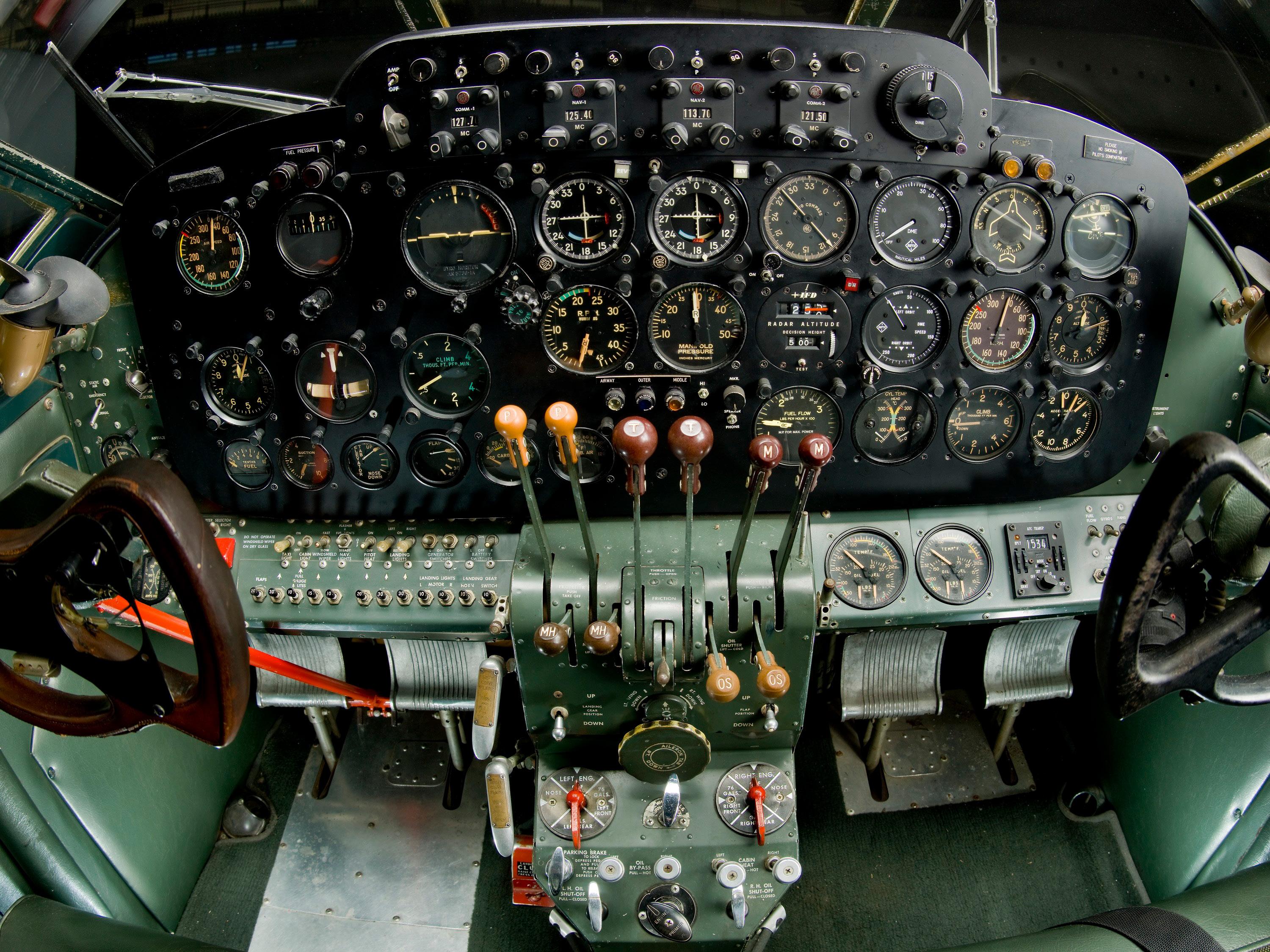
October 2023 37
A typical well preserved original Beech-18 cockpit.
There is only one fuel gauge so you have to select the tank you want to check.


October 2023 38
The standard utilitarian Beech-18 cabin - with the step over the spar into the cockpit. Image Tim Homnan.
ingredient that makes an unforgettable olfactory experience.
All aircraft of this vintage are normally an ergonomic nightmare. There are buttons, knobs, levers, handles and switches everywhere. ZS-OIJ however has had a proper panel makeover with a smart plain white enamel finish, and the layout is now far more standard than most original Beech 18s.
The standard six-pack of flight instruments is duplicated left and right with the avionics stack in the middle, to the right of the engine gauges. Each round gauge has dual pointers to show rpm, manifold pressure, oil and fuel pressure, and oil, carburettor and cylinder head temperatures. The ammeter, voltmeter and fuel gauge are half-hidden behind the pilot’s control wheel. The control wheels are mounted on substantial control columns on either side of the cockpit.
Partially hidden behind the left control column is the only fuel gauge. It has a selector switch so it only indicates one tank at a time. There
is potential for real confusion, as the quantity remaining in the selected tank only is shown on the gauge in ten percent increments. As the size of the three tanks in each wing is different, it can easily lead to a mistake. This confusing system has led to numerous B18s suffering dual engine failures, despite having fuel remaining in some of the tanks. This was the fate of ZS-OEP which had a forced landing under the Lanseria circuit some years ago.
In a traditional Beech Baron idiosyncrasy, the power quadrant is a non-standard floral bouquet of both long and short stemmed coloured knobs. The prop pitch levers are on the left, throttles in the centre, and mixtures on the right. The stubby levers that control the manifold heaters and oil shutters are between the main power levers.
A sub-panel below the console carries the fuel selectors, T-handles for the tailwheel lock and park brake, plungers for oil bypass and oil shutoff. The undercarriage selector is to the left of the sub-panel and the flaps to the right, ahead of two large fuel selectors.

October 2023 39
The power quadrant sub-panel gives some insight into the complexity of this twin.
A wheel on the right side of the pilot’s seat operates the elevator trim; there’s a small wheel for aileron trim and, like an early Cherokee, a handle in the roof (which resembles a car’s window winder) but unlike the Cherokee it’s for rudder and not elevator trim. Elevator, rudder and flap position indicators are at the bottom of the righthand instrument panel.
Seemingly added as an afterthought to the top of the left side instrument panel are two large buttons. These are pushed to electrically feather the Hamilton Standard hydromatic propellers in two seconds. The button then pops out. Pushing it in again unfeathers the blades and causes the prop to windmill.

This is a Beechcraft and so everything is built to last. The yoke is mounted on an arm that looks like it’s been borrowed from a bridge, while the rudder pedals are for pilots who wear boots. Flippie Vermeulen says, “Rightly so as the pilot has to have his feet high up on the rudder pedal, within immediate reach of the brakes at all times during take-off and landing."
Flying the Beech 18
The start requires a ritual with the many buttons, switches, knobs and levers to be pushed, pulled, twisted, turned and set. Items that pilots of modern planes will be unfamiliar with include the oil shut-off plungers, closing the oil shutters and selecting the fire extinguisher to the appropriate nacelle.
Crack the throttle open, shout “clear prop!” out the window and energise the starter. The big two-blade propeller begins to revolve and after six blades scythe past the window you turn on both mags. From within the bowels of the cowl comes a cough and a grunt as a couple of cylinders fire somewhat hesitantly then backfire. Hopefully before it dies a few more cylinders fire and smoke from burned oil and over-primed cylinders streams back from the exhaust. Suddenly the remaining cylinders burst into life, turning the two propeller blades into a shimmering blur. The engine soon settles into a contented chuntering.
Taxiing the 18 is typical taildragger, so S-turns are required, especially so with the long nose on ZS-OIJ.
October 2023 40
The long nose option helps use the useful load by giving a better CofG range.
The pre-takeoff checks are lengthy but conventional. They include cycling the props and testing the feathering system, ensuring that the oil shutters are set and the oil bypass is in, fuel selectors to front mains and cross feed off. All the trimmers are set for takeoff. Flaps are only utilised for short field takeoffs. Last, but by no means least, the tailwheel must be locked once the aircraft is perfectly lined up with the runway.
The before-takeoff pilot briefing includes the procedures to be adopted in the event of an engine failure both before and after ‘red line’ speed (velocity of minimum control, (Vmc) is 82 knots) has been attained. Review the other critical air speeds, such as the limiting speeds for the undercarriage and flaps, and confirm that climb-out speed will be around 100-110kt.
Once lined up, gradually stabilise the power at 20 inches HG boost with the brakes applied to ensure symmetrical power, then increase the power to 36.5 inches and 2,300 rpm for takeoff. Even though the twin rudders are in the propwash, they do not produce significant steering until reaching 30 to 40 knots.
The engines’ rumble swells to a growl, and the needle of the ASI starts to move. With radial engines swinging big props there’s a lot of metal
whirling around on each wing, and gyroscopic precession is a force to be reckoned with. If you pick the tail up too quickly to see over the nose, a swing is almost inevitable. Flippie Vermeulen says that it helps to lead with the right rudder and initially tap the right-hand brake pedal now and again to keep the big twin on track until its going fast enough for the rudders to be effective.
With 900 supercharged horsepower the Beech 18 accelerates fast. At 80 knots ease the yoke back. As the wheels leave the ground check forward on the yoke to let the speed build to blue line speed.
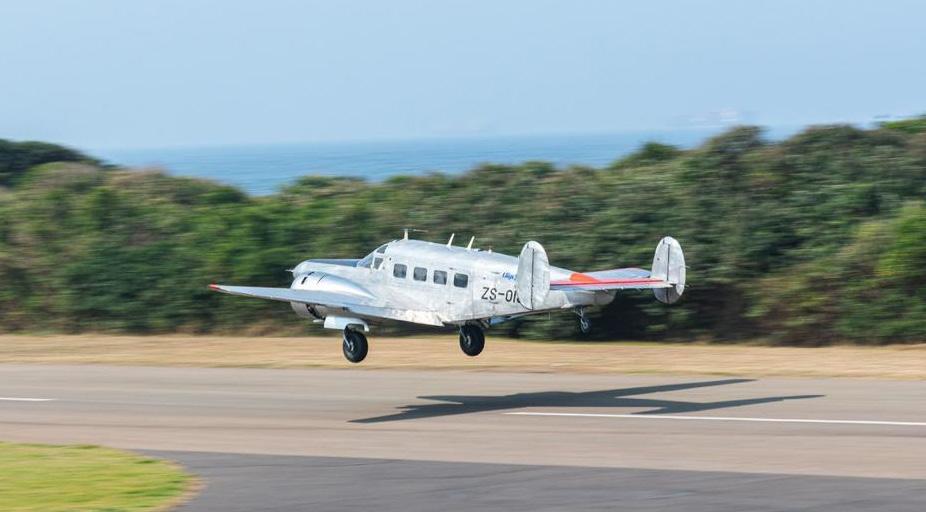
With the flaps and undercarriage up, and the speed at blue line, at 300 ft pull the throttles and props back to climb power of 31” and 2,100 RPM.
Both the undercarriage and flaps are electric, a Beech trademark used on all its subsequent complex planes. For a normal takeoff the gear comes up commendably quickly. In case of electrical failure, the wheels and flaps can be hand cranked up and down.
Although the controls forces are delightfully light and super effective for its age, the pitch trim changes constantly with speed changes and so
October 2023 41
The undercarriage is electrically operated and retracts quickly. Image Timothy Homan.
needs continuous attention. The controls are nicely harmonised and the authority good which makes the aircraft really manoeuvrable, as can be seen by the displays at airshows by Flippie Vermeulen. The aircraft has positive stability around all three axes, and it is not difficult to fly on instruments, as long as it is trimmed properly.
You enter a steep turn and make bank and pitch changes with your fingertips—almost as if the controls were boosted – which they are not. While most 18s have electric elevator trim, many pilots prefer using manual trim. Your right hand falls naturally to the trim wheel, which moves easily and effectively.
The visibility is pretty much what you would expect of a WWII transport with round engines outside the smallish flat-pane cockpit windows. It’s not bad, but not great.
Slow flight is surprisingly benign, and with the
flaps down and a bit of power you can see 68 KIAS, while Vne is 220kt, an impressive 3 times ratio.
One-G stall speeds at maximum weight are 81 KIAS (flaps up) and 73 knots KIAS (flaps down). Mild buffeting and mushy controls warn of an impending power-off stall, but there’s little warning of a power-on stall. Instead, a stickshaker on the left control column lets you know.
In the cruise at less than gross weight, with an engine at zero-thrust to replicate a dead engine with the prop feathered, the performance is acceptable. But losing an engine just after takeoff on a hot day with a full load would be a white-knuckle moment.
On downwind you get busy with the flaps, and undercarriage. Flippie Vermeulen points out that normally the undercarriage is not lowered until the final approach decent is commenced.

October 2023 42
The substantial castering tailwheel keeps the twin tails high off the ground.
With its slab sides and small tail, the 18 can be a handful in a crosswind. The demonstrated 90° crosswind component is just 11 knots, but this is the demonstrated figure in the POH. Flippie says that he has had to do landings in up to 20 knot crosswinds.
There’s a slight nose-down change in trim as the wheels lock down. Reduce speed to 100 kt and turn base. On final, lower the rest of the flap and pull the throttles back a bit more while lowering the nose and pushing the props to full fine.
Aim to cross the fence at a Vref of 80 knots. Squeeze the throttles closed, check the sink and then let the grand old dame settle gently on to her main wheels. The bigger tailwheel types need wheel and not 3-pointer landings. The actual touchdown should be gratifyingly soft. Check forward on the yoke to hold the main wheels on the runway.
Although it is delightful to handle in flight, it can be a handful on the ground, especially during the rollout after landing. Come to a full stop, then unlock the tailwheel and taxi clear of the runway. Flaps up and cowl flaps open for the taxi back. Slide the window open to cool down.
Conclusion
The Beech-18 is indeed a true classic. Its inherent qualities have earned the respect of many pilots and operators. It has been successfully operated as a crop sprayer, it has done fish seeding, dry ice cloud seeding, firefighting, delivered air mail and served as an air ambulance. It has starred in numerous movie productions, dropped countless skydivers, and been the plane of choice for weapons and drugsmuggling. It has served as an engine test bed, towed banners and done skywriting.
In South Africa Flippie has used ZS OIJ successfully on luxury flying Safaris for the past 10 years. The reliability of its Pratt and Whitney R985 engines has allowed Springbok Classic Air to operated ZS-OIJ as far afield as Seronera in the Northern Serengeti in Tanzania.
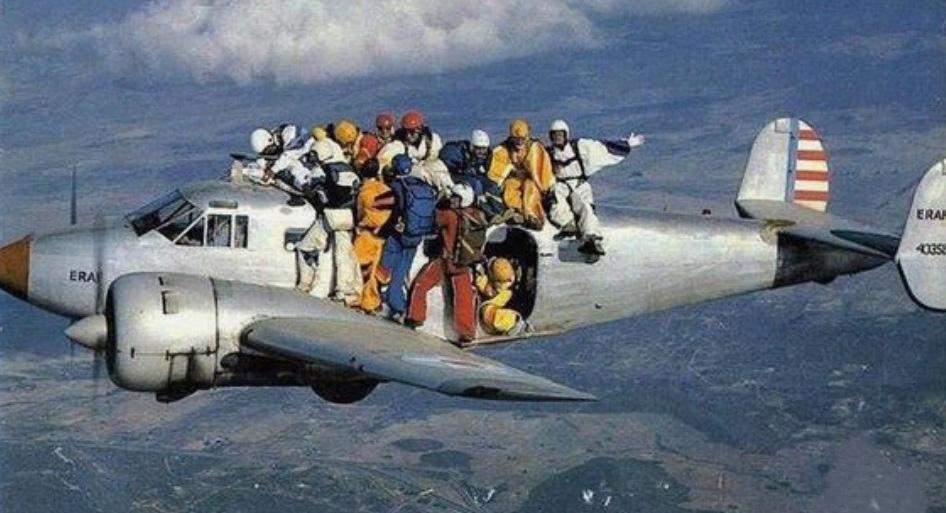
As with the other big piston-powered planes, it’s a lot more than the sum of its parts, which are really simply a disparate collection of metal, rubber, leather and plastic.
Perhaps the best comment comes from longtime owner and fan, Enrico Bottieri, who said, “There are many Beech twins, but only one Twin Beech.”
October 2023 43
j
Thanks to their versatility, many Beech-18s became skydiving jumpships.
THE BEECH 18 IN SOUTH AFRICA


AS FAR AS CAN BE ESTABLISHED 2 Beech 18s survive in South Africa, ZS-OIJ, the subject of this report, and ZS-OEP. They are maintenance hungry airframes, and so only one, ZS-OIJ, is airworthy, while ZS-OEP is awaiting restoration in Flippie Vermeulen’s hangar at Rand Airport.
ZS-OIJ was built in 1959 and flew as a freighter for Millard Air in Canada. It was acquired by Ron Wayner and with tail number N7058U was ferried to SA in 1994 to serve with Mercy Air, flying missions out of White River.
Under the loving care of John Herbert, who joined Mercy Air in 1995, she was refurbished and polished to bare aluminium, with the unusual all white aluminium instrument panel. To take advantage of the ever-growing maximum takeoff weight of the B-18, (from 8,000 lbs in 1937 to 10,100 lbs) it eventually become difficult to fully utilise the higher gross weight as the higher load would exceed the aft envelope of the aircraft’s centre of gravity. Ron Wayner already had the STC approved long nose modification for the Beech 18 and it was installed to increase its utility to the mission organisation. The key advantage of the long nose is that it allows the loading of 800 lbs of baggage in the nose and this moves the centre of gravity back into the approved CofG range. This enabled more baggage to be stowed in the rear of the cabin.
In 2000 she was fitted with the long nose extension, but in 2008 the extension was temporarily removed and the paint scheme changed for her role as the Amelia Earhart L-10E Electra in the Hollywood production
“Amelia” a docu-drama about Amelia Earhart’s attempt at circumnavigating the globe.
She served with Mercy Air until 2010 supporting missionary work in Southern Africa before being sold to Namibia. In 2012 she was left stranded in Sossusvlei when the dust from desert operations destroyed her main crankshaft bearings. She sat on the ground at Sossus for 18 months, until, in 2013 Flippie Vermeulen of Springbok Classic Air purchased her and she joined his DC-3, ZS-NTE, flying tourist in the southern African region.
October 2023 44
ZS-OEP after being force- landed due to fuel mismanagement. Image Andew de Kock.
j
As there are no air or oil filters the Beech 18 does not like dirt runways. Image Kenya777.
SPRINGBOK CLASSIC AIR
FLIPPIE VERMEULEN HAS A PASSION for classic aircraft – especially airliners. He lovingly maintains Beech-18 ZS-OIJ and a DC-3 ZS-NTE (a 1943 Douglas C-47A Skytrain) as part of their family businesses at Rand Airport. The collection includes:

Springbok Classic Air (Vintage Flying Safaris). Under Captain Flippie Vermeulen they have managed the SAA Historic Flight, including an epic DC-4 trip to Oshkosh.
Springbok Aviation Services (Restoration and maintenance.) Notable restorations include a PBY Catalina which was sold and flown to the United States and a Douglas DC-3 Dakota which was exported to Holland.

Springbok Air Academy, flight training from ab-initio all the way to Airbus A320/330/340 and Boeing B737-800 type ratings).
Springbok Air Academy: A flight School, which has now also opened up a satellite flight school at Orania.
October 2023 45
The Dakota Lodge: a popular aviation themed hotel attached to Hangar 5 at Rand Airport.
Capt Flippie Vermeulen heads up the Springbok Group.
j
The Springbok Aviation group of companies.
Specifications and Performance
BEECHCRAFT D-18

SPECIFICATIONS
Crew: 2 pilots
Capacity: 6 passengers
Length: 34 ft 3 in (10.44 m)
Wingspan: 47 ft 8 in (14.53 m)
Height: 9 ft 9 in (2.97 m)
Wing area: 349 sq ft (32.4 m2)
WEIGHTS AND LOADINGS
Empty weight: 5,420 lb (2,458 kg)
Gross weight: 7,500 lb (3,402 kg)
Useful Load: 2,080 lb
Wing Loading: 122.4kg/Sq M
Power Loading: 5.99kg/Kw
Fuel Capacity: 1,068 Litres
PERFORMANCE
Vne: 220kt
Cruise: 185ktas
Stall: 70kt
Maximum speed: 225 mph (362 km/h, 196 kn)
Range: 1,200 mi (1,900 km, 1,000 nmi)
Service ceiling: 26,000 ft (7,900 m)
Rate of climb: 1,850 ft/min (9.4 m/s)
FOR SALE
Fascination Nature Reserve
Calling all Aviators!! What a find! This won’t stay, so don’t delay.
AVIATORS PARADISE with 1.1km dirt strip on 80 hectares with the most beautiful surroundings of pure nature. And it’s up for SALE!!

This farm is situated in the Groot Marico area with stunning bushveld surroundings and roaming game/wildlife. The property has great potential to be turned into a tourist attraction or just a weekend getaway farm when you feel the need to escape the busy city life. It’s a real Gem and aviators dream. Just half hour flight from Lanseria. And a hop to SunCity or Rustenburg.
Buildings consist of two homesteads a flat and two workers housing.
Outbuildings consist of hydroponic greenhouses (currently not in use), a large storage facility, slaughter room with cool room, 3 strong boreholes, of which one is equipped with solar and Eskom. The entire farm is fenced with game fencing except for next to the dirt strip.
Don’t wait!! Call me today!
Gert Heymans @ +27 83 303 0751 or email us at gert@sonkant.co.za for more information or to arrange for a private viewing appointment.
Price 3.9 Million 25°36’07.3”S 26°19’54.1”E
October 2023 47
THE DREADED HAMMERHEAD AGAIN.
Aircraft registration: ZU-YUM
Date and time of accident: 14 February 2015 1345Z
Type of aircraft: Lancair 360
Type of operation: Private (Paart 91)
PIC license type: PPL
License valid: Yes
PIC age: 38
PIC total hours: 810
PIC hours on type: 367
Last point of departure: Parys (FAPY), Parys, Free State
• This discussion is to promote safety and not to establish liability.
• CAA’s report contains padding and repetition, so in the interest of clarity, I have paraphrased extensively.
History of Flight:
Next point of intended landing: Kitty Hawk (FAKT), Pretoria
Accident site: Next to Parys Aerodrome at 4728ft AMSL
Meteorological information: 31ºC; 270º/08 gusts
20-25; Viz 10k
Cloud Cover: None
POB: 1+1
People injured: 0
People killed: 2
On 14 February 2015, the pilot and his six-year old son took off from Kitty Hawk on a flight to Parys. They arrived at Parys at about 1030Z. They parked the aircraft and had lunch at the aerodrome’s restaurant.
At about 1330Z, they took off on Runway 24 for the flight back to Kitty Hawk. The pilot called the aerodrome’s safety officer on 123.5 Hz for a radio check. He said he was going to do a low fly-past over Runway 24.
The airspace is class G with unmanned procedures in force. The normal circuit for Runway 24 is a left-hand pattern but the pilot turned out right after take-off.
He flew over the town of Parys, and then over the airfield at low altitude and high speed from west to east. Witnesses estimated his speed to be about 170 knots.
One witness described conditions as ‘very turbulent’ with the wind gusting 20 to 25 knots.
After the aircraft flew over the witness it started a climbing turn to the left to position for a low
October 2023 48
JIM DAVIS
level fly-past along Runway 24. It pitched up into a steep left turn, whereafter it nosedived into the ground.
The Lancair 360 is a kit-built, two-seater, lowwing, retractable, tricycle, monoplane constructed mainly of composite materials. It has a 180HP Lycoming engine and a fixed pitch propellor.

On 9 March 2010, the FAA published the following information circular for Lancair operators. (I have edited this for brevity.)
Accident statistics for the Lancair, have shown a large and disproportionate number of fatal accidents for the fleet size.
The majority being due to inadvertent stall/ spins, while at slower airspeeds in home airport traffic patterns.
The FAA recommends that pilots:
• Review all information regarding the slow-flight and stall characteristics of their own Lancair.
The aircraft impacted the ground and then a wire fence. The propeller carved into the hard ground 11 m from the first impact. The engine was operating at a high power setting. The fibreglass wings disintegrated on impact and the engine was found 219 metres from the initial point of impact with no evidence that it had rolled along the ground. It appears to have bounced and travelled through the air for most of that distance, which indicates the high speed of the aircraft.
• Obtain specialised training from a Lancair recommended instructor.
• Install an angle-of-attack indicator and/or a stall warning indicator (Note: indicated airspeeds can be as much as 10-20% off if not properly calibrated.)
• Have their aircraft’s rigging and mass and balance evaluated by a mechanic.
• Have their aircraft’s handling characteristics evaluated by a test pilot.
October 2023 49
Basic Empty Mass 1252 lbs Pilot 212 lbs Passenger 35 lbs Fuel 162 lbs Cargo 15 lbs Total Weight 1676 lbs Maximum Take-off & Landing Weight 1685 lbs Below Maximum Take-off Weight 9 lbs
The Lancair 360 is a small high performance plane with a demanding wing.
Probable Causes
The pilot lost control during a tight left downwind turn [sic] at low altitude, from which he was unable to recover.
The pilot had severe coronary artery disease with Gr IV occlusion of the left main artery. A heart attack cannot be excluded.
JIM’S COMMENTS
Dear parishioners, much as I would like to deliver yet another sermon on downwind turns, it would not be appropriate – the CAA are talking through their underpants when they cite this as the Probable Cause. Hell, the aircraft was actually turning into the wind.

This crash was about hammerheads and twitchy aeroplanes. Let me explain both.
A hammerhead is when you overshoot the centreline on your base to final turn. It’s dangerous because you are low and slow. You start pulling back to tighten the turn. You know it’s not good to be banked steeply near the ground, so to tighten the turn you use more rudder.
But wait a minute, the secondary effect of rudder is roll. This means she will try to bank even more steeply, so you hold off bank with the aileron.
Sound familiar? Correct – you are all set up to spin in.
But I hear one of our parishioners, Captain Tailpipe, asking if it’s so bloody dangerous, why don’t these accidents happen all the time.
Ah-ha – a very good question Comrade. The short answer is we fly pansy aeroplanes like the small Cessnas and the Easy-Peasy Cherokeesy.
These little aeroplanes have thick wings like mattresses, which have gentle stall characteristics. They give plenty of lift at low speed but the wings are too thick and draggy to be fast.
If you want more speed then look at the wing on a Comanche, a Mooney or a 210, and you will see it’s much thinner, it causes less drag and gives you more speed at the expense of slightly twitchy low speed handling.
Now look at the wing on a Lancair – it’s like a razor blade – and it says clearly, don’t mess with me – I’ll cut you up before you can blink. It’s fast and twitchy as hell.
So wings are always a compromise between
October 2023 50
The flight path that led to the hamerhead and stall.
speed and gentle handling – you can’t have both.
In a fast, twitchy aeroplane like the Lancair, a stall is where it behaves badly. It will stall abruptly, with little or no warning, and will almost certainly drop a wing quite violently. As long as you have plenty of height this may be a bit alarming initially, but is not dangerous per se You simply ease the stick forward and use opposite rudder to pick up a dropped wing. The problem is that this seldom happens at altitude – it’s typically around the circuit.
And there are two common piloting faults that tend to make it dangerous. The first is being too slow with the recovery, which may lead to the aircraft becoming inverted as it enters a spin. And the second is trying to recover from the dive too soon, or two quickly, which can cause a secondary stall and possible spin.
So you need an immediate response at the first sign of a stall/spin, followed by a very gentle recovery from the dive.
Obviously plenty of altitude is the secret –however it’s generally not available if you are trying to impress your mates on the ground.
Did you notice that the FAA’s special bulletin to Lancair pilots stated that most of these fatal stall/spin accidents happen at the pilots’ home fields? I was much puzzled by this initially but some research turned up at least three possible reasons.

• Pilots tend to be more relaxed and generally more slack at their home fields. The only time I came close to a wheelsup landing was at my home field.
• Pilots are inclined to, either consciously, or subconsciously, use landmarks around their home circuits. And while these landmarks are fine for say 100 kts around the pattern, they are far too tight for a show-off
170 kts beat-up. So you are heading for a hammerhead unless you allow for this and are wide awake.
• I guess it’s just stats because you do most of your flying at your home field.
All aircraft tend to roll away from the ball, regardless of the direction of the turn. So if the ball is to the left she will roll, or even flick, to the right, and vice-versa.
However this is of academic interest only if you are yanking the turn too tight while looking over your shoulder to see if you can line up with the runway.
I’m afraid this was a classic case of PPP –passive people pressures. Would he have done that if the airfield was deserted and he had no pax? I think not.
Take home stuff:
• Am I doing this flight or manoeuvre to please or impress other people?
• If you have a twitchy aeroplane don’t be scared to stall it. Grab a good instructor, go up high and stall the hell out of it in all configurations and attitudes until you understand its low speed handling.
• Be particularly vigilant at your home field.
October 2023 51
j
The engine bounced over 200 metres from the main wreckage.
AUGUST 2023
AUGUST HAS BEEN A RATHER quiet month when it comes to the number of aircraft movements on the register.
A total of seven fixed wings and one helicopter (a Super Puma) have been added to the TCA register this month. FlySafair have registered another Boeing 737-800. This one is ex-Ukraine International Airlines and is fourteen years old. She takes up the registration of a Partenavia

P.64B Oscar B1155 / RSA200 which was sold in Rhodesia as VP-WEJ way back in 1973.
Federal Airlines registered the other three of the six Caravans that they acquired. These are: ZS-KMJ which used to be Beech Baron which now lives in Australia, ZS-KMK which was a Beech Baron 58 that went back to America, and ZS-KMM which used to be a Cessna 421.
The Cessna T207 that was registered this month is a rare aircraft being the only one of its kind in this country. This is one that has been modified to have a 418shp Allison 250 – 1205 turbine engine. This gives the aircraft a ceiling of
twenty-seven thousand feet and a top speed of one hundred and forty-eight knots.
There is also an Embraer 190 registered this month but the reg isn’t in the normal group for Airlink so I’m not sure who this one is for.
We see ten TCA aircraft deleted this month with the aircraft going all over the world.
The NTCA side is very quiet with only four aircraft added.
Even the normally frenetic UAV activity is down. There were another 61 drones registered, but ten were deleted.
Tail Piece:
The flying club at Brakpan airfield holds monthly safety lectures and they are well worth attending. I’d like to suggest you attend one. You can fly in if you want too as well.
Have a great and safe month.
52 October 2023
REGISTER REVIEW: RAY WATTS
Boeing 737-800, OE-IMA is now with FlySafair as ZS-FGJ.
aircraft going all over the world. j
ABOVE: A rare Cessna 207 conversion - V5-ISH Cessna T207 is now ZS-ISH.

BELOW: ZS-KFS Cessna C680 has been exported to the USA. Photo Omer Mees.

BELOW BOTTOM: The Airlink Avro fleet is slowly being sold off. ZS-SYO is a BAe 146-RJ85 exported to Zambia. Photo Ray Watts.

53 October 2023
ABOVE: Gone to Africa. ZS-APN is a Piper PA32 Cherokee 6 exported to Burkino Faso. Photo Ray Watts.

BELOW: ZS-SVP is a Cessna 208B Caravan now exported to Zambia. Photo Dave Becker.

BELOW BOTTOM: ZS-TSW, a Pilatus PC12 has been exported to Germany. Photo Michael Combrink.

54 October 2023
ABOVE: ZT-REJ is a Bell 206B exported to Zimbabwe. Photo Omer Mees.

BELOW: ZS-NYM is a Pilatus PC12 exported to Germany. Photo Greg Rooken-Smith

BELOW BOTTOM: ZS-SHO is a Cirrus SR22 exported to the USA. Photo Ray Watts.
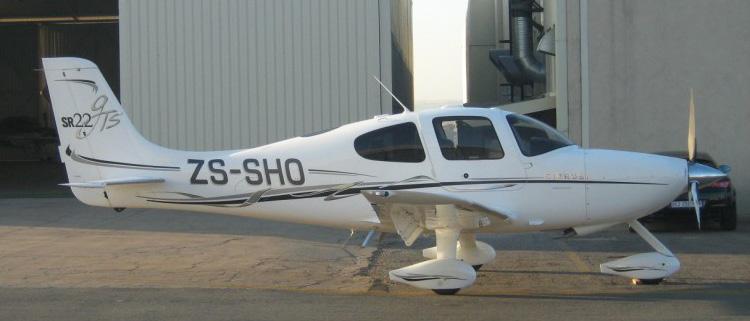
55 October 2023



M & N Acoustic Services (Pty) Ltd REGISTER REVIEW AUGUST 2023 Contact: Marianka Naude Tel: 012 689 2008 I Cell: 076 920 3070 Email: admin@mnacoustics.co.za We perform SANAS certifications on all your: Acoustics ( eg. CEL 350 ) Vibration ( eg. Rion VA -11) Human Vibration ( eg. Quest Hav Pro) Electrical DC/LF Equipment – inhouse or on site (eg. Fluke Multimeters, Insulation Testers) SANAS Accredited Laboratory REG MANUFACTURER TYPE NAME SERIAL NUMBER PREVIOUS IDENTITY / EXPORT COUNTRY New Registrations ZSZS-FGJ BOEING 737-800 37542 OE-IMP, UR-PSU, EI-EFS ZS-ISH CESSNA AIRCRAFT COMPANY 207 20700706 V5-ISH, N91594 ZS-KMJ TEXTRON AVIATION INC 208B 208B5749 N9008D ZS-KMK TEXTRON AVIATION INC 208B 208B5750 N9003D ZS-KMM TEXTRON AVIATION INC 208B 208B5752 N9003Z ZS-YZE EMBRAER ERJ 190-100 IGW 19000150 PR-ZBA, N290ZB New Registrations ZUZU-IYY SAVANNAH AIRCRAFT AFRICA SAVANNAH S 22-06-54-0873 ZU-IYZ SAVANNAH AIRCRAFT AFRICA SAVANNAH S 22-10-54-0906 ZU-ODY VANS AIRCRAFT RV-10 41046 ZU-PPB SLING AIRCRAFT (PTY) LTD SLING 4 TSI 458S New Registrations ZT-R ZT-RYE AIRBUS HELICOPTERS EC 255 LP 2872 F-WWOA, 9M-AIO, N225RT, HL9656, F-HSPL Aircraft deleted ZSZS-APN PIPER AIRCRAFT CORPORATION PA-32-260 32793 BURKINA FASO ZS-KFS CESSNA AIRCRAFT COMPANY C680 680-0564 UNITED STATES OF AMERICA ZS-NYM PILATUS AIRCRAFT LTD PC-12 147 GERMANY ZS-SHO CIRRUS DESIGN CORPORATION SR22 1721 UNITED STATES OF AMERICA ZS-SVP CESSNA AIRCRAFT COMPANY 208B 208B0573 ZAMBIA ZS-SYO BRITISH AEROSPACE PLC AVRO 146-RJ85 E2394 ZAMBIA ZS-TSW PILATUS AIRCRAFT LTD PC-12/47E 1168 GERMANY ZS-XCL ATR-GIE AVIONS ATR72-202 313 HUNGARY New Registrations ZT-R ZT-REJ BELL HELICOPTER 206B III 4180 ZIMBABWE

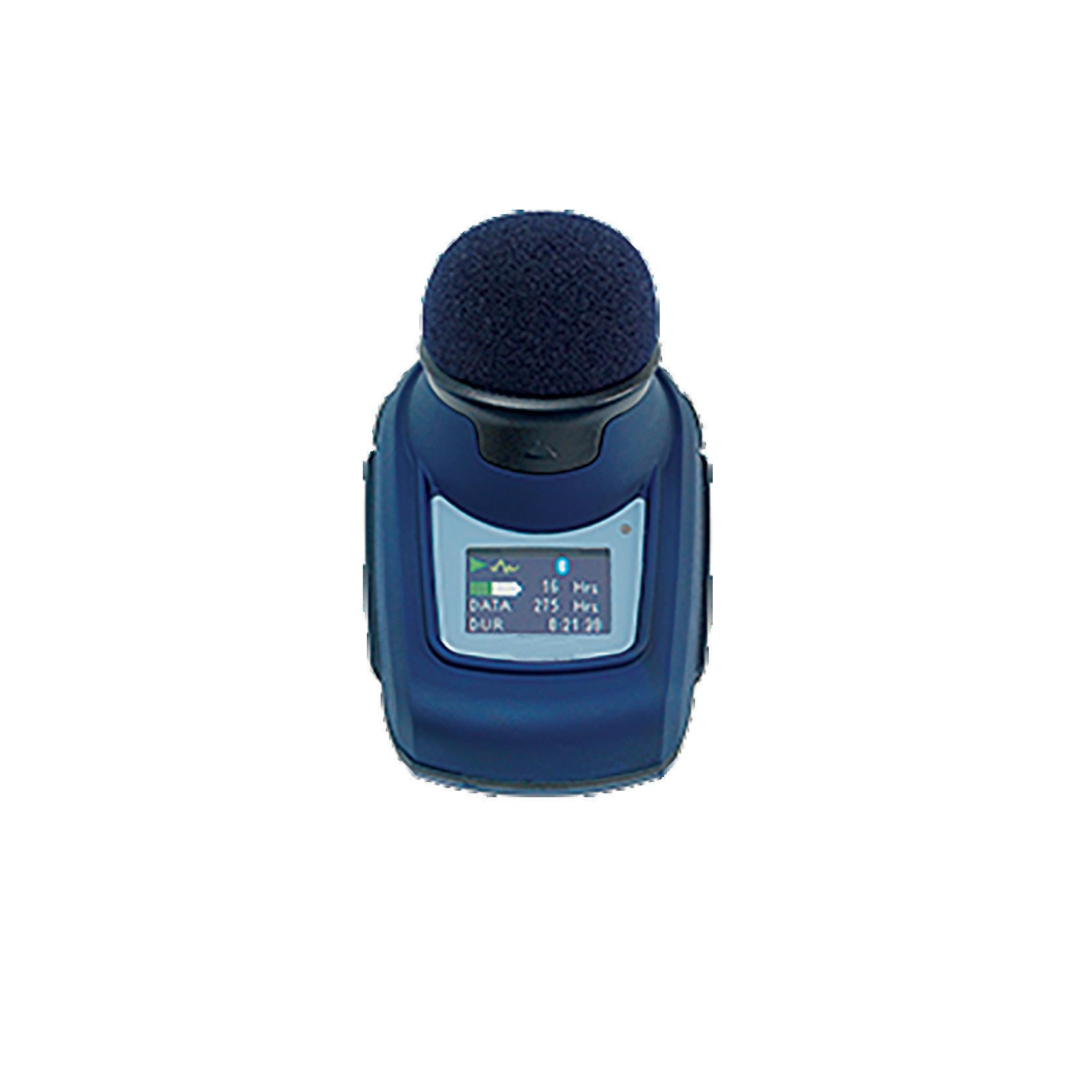


M & N Acoustic Services (Pty) Ltd QUOTATIONS ON REQUEST We perform SANAS certifications on all your: Acoustics ( eg. CEL 350 ) Vibration ( eg. Rion VA -11) Human Vibration ( eg. Quest Hav Pro) Electrical DC/LF Equipment – inhouse or on site (eg. Fluke Multimeters, Insulation Testers) Contact: Marianka Naude Tel: 012 689 2008 I Cell: 076 920 3070 Email: admin@mnacoustics.co.za SANAS Accredited Laboratory 1302 & 148
AOPA BRIEFING
Chris Martinus, President, Aircraft Owners and Pilots Association – South Africa

CEOS REACHING FOR THE SKY
58 October 2023
LEADERS
Our brains are getting smaller, despite the fact that we live in a civilisation that is the most advanced that has ever existed.
CEO Mike Hartman's solo photo.
THIS ALARMING DISCOVERY was released in a study last year by palaeontologists at Dartmouth College in the USA. What was most surprising is that this reduction in cranial capacity has only occurred in the last 3000 years.
Some conclusions were that, since the brain needs a considerable amount of nutrients and energy to grow and maintain, if we don’t use it, it tends to shrink in size over generations. This is particularly true when we look at other creatures in the animal kingdom. For example, most parasites like lampreys live in a very comfortable environment where all their needs are provided for by their hosts. Lampreys don’t have to think very much, so they accordingly have tiny little brains.
Although the size of the brain is not the sole determinant of intelligence, there are other indications that the humans of more than three millennia ago were pretty smart guys. Early humans had to have intelligence and abilities we just don’t need today. The average early human had to be able to hunt, find food, build a home, protect his dwelling and family from predators, plan ahead for the winter months when resources were scarce, make fire, invent his own tools, tend to his own wounds, settle disputes himself and deal with countless other challenges that modern humans no longer need to care about.
The fact is, in our modern “civilised” era we have all become specialists. We focus on our very narrow fields of endeavour and leave our other needs to be dealt with by other specialists. Instead of hunting and foraging for our next meal, we visit the local supermarket, or even just order our food online.
We rent or borrow to buy a home, which is built
by contractors and specialist sub-contractors. If we are threatened by predators, we call the police or the security company. If our house burns down, that’s the insurance company’s problem. If the car breaks down, we have no clue how to fix it. Indeed, few people even own a toolbox, let alone can fabricate the necessary tools. We have maintenance plans and extended warranties where other specialists will deal with that.
If we need to remember things or do calculations, computers do that for us. If we want to chat with others, no need to trek for days through the wilds to engage with our friends and associates. We pull that smartphone out of our pockets and see and speak to each other within a couple of seconds. If we hurt ourselves or get into a dispute, there are doctors and lawyers to sort those problems out.
It’s little wonder we are growing smaller brains. Other than for the narrow purposes of our specialised careers, we don’t need most of that lump of mush sitting in its bony container above our shoulders.
Most of the world’s working population work for others, for businesses and corporations. Particularly in the cushy environment of larger corporations where medical care, pension plans, transport, a comfortable work environment, paid leave and the golden handcuffs of assisted loans provide for all imaginable human needs.
But what about the few who use their ingenuity to struggle up the corporate ladder from cubicle to boardroom?
The transition from the ordered corporate environment to the real world of cut-and-thrust, dog-eat-dog engagement within the wilderness of our modern “civilization” is a daunting one for the budding CEO. The need to swiftly assess
59 October 2023
CEOs who fly make significantly better CEOs.
and manage risk, assess the environment outside the office building - as well as having to make rapid and accurate decisions regarding potentially life-threatening scenarios, becomes paramount.
Human babies are born with an excess of neurons in their brains, about 100 billion of them. As the baby grows, neural pathways are formed by the process of learning, and the unused remainder eventually fade away as we age. This is why you can’t, “teach an old dog new tricks”.
This transition for young executives is one that has challenged corporations for a long time. Further academic education, as well as projects such as so-called wilderness leadership schools and the like have proven to be of dubious value. Walking a few trails, engaging with nature and sitting around the campfire with colleagues while drinking beer and singing Kumbaya may well introduce some novelty and team-building, but does little to galvanise those unused neurons into useful function – before they eventually atrophy and die.
It’s Time To Go Fly
It is not an entirely new concept, but there have been numerous studies and analyses that, statistically, CEOs who fly themselves make significantly better, more effective and successful CEOs. These studies point to historic business greats like Howard Hughes and Oracle CEO Larry Ellison as examples of highly successful CEO pilots. Elon Musk bought himself an L-39 jet and learned to fly it when he founded SpaceX.
It comes as no surprise that, when casually perusing a list of members of AOPA South Africa, that the majority are captains of industry, professionals and successful entrepreneurs. So, why does learning to fly and obtaining a pilot licence appear to make for such successful business leaders? This aspect is something that the copious research and literature does not really address.
The answer is this: It introduces the business leader to a very novel and broad range of

60 October 2023
CEO - Andrew Borresen goes solo.
disciplines, knowledge, skills and concepts that fires up those hitherto unused neurons into pathways that are of immense use to the potential CEO who needs to face very novel and diverse challenges.
Not only is there the new knowledge and concepts that a student pilot must master, but also the simultaneous implementation of those mental systems – in a very different and frightening environment compared to just wandering on the surface of the Earth.
A new pilot has to learn a diverse range of novel concepts and write at least eight exams on those subjects alone. These range from engines and airframes, air law, meteorology, navigation and other subjects that, academically, seem to be unconnected with each other.
However, the practical experience of actually grasping the unfamiliar controls of an aircraft and competently guiding it through an even more unfamiliar third dimension pulls all that essential knowledge together. The mental parallels between flying an aircraft and controlling a corporate empire are remarkably similar. An error made by a pilot could well be his last. Similarly, a single error made by a CEO could have devastating and irrevocable consequences.
While learning to pilot an aircraft, the reality of certain death is never more than a few moments away, so just like for the CEO, decisions need to be made quickly, correctly and decisively. Decisions also rely on swift judgement based on a broad base of knowledge, information and skills, all of which are in themselves different disciplines.
Perhaps the most important similarity between flying and running a business is the ability to
accurately assess risk in the face of many changing variables. All enterprises face a plethora of risks, simply to stay afloat. And any opportunities must be grasped before they slip away. In the cockpit, a pilot must similarly be proficient in assessing risk in order to stay in the air. Changing weather conditions, navigational uncertainties, potential mechanical failures, aerodynamic considerations and knowing the limitations of both the aircraft and himself are factors continually swirling around in the pilot’s mind.
For example, a pilot may find him or herself in rapidly deteriorating unexpected weather conditions. The instinctive tendency is to press on with the mission, hoping desperately that conditions will miraculously improve. Hoping that beyond that ugly line of clouds filled with lightning, hailstones and wingshredding winds, the sky will be clear again.
Similarly, a CEO facing unexpected deteriorating economic conditions, filled with pandemics, wars and political instability will instinctively hide those unpaid invoices in the back of the cupboard and ignore the strident demands from creditors, all the while desperately hoping that the adverse conditions will soon pass and times will be good again.
Both of the above examples are all too often fatal.
This raises a corollary to the essential ability of properly assessing risk – and that is the ability to make effective contingency plans for unexpected events – and to act decisively on them when they occur, without dithering, hoping, praying or succumbing to the delusional magical thinking that those adverse conditions will simply solve themselves.
61 October 2023
decisions need to be made quickly, correctly and decisively
The pilot is trained to always leave several back doors open in case of something going wrong. Pilots learn to turn back from bad weather or divert to an alternate destination, to make precautionary landings if those options become unavailable.
The training environment for pilots is filled with realities that evoke primal fears of imminent death, notwithstanding that while under the watchful eye of a competent instructor, it is really quite safe. But the fear and trepidation inherent in learning to fly serves a very useful purpose: it burns those mental techniques and disciplines firmly into the connections between those hitherto unused neurons in the pilot’s brain.
Additionally, those newly-formed brain areas are kept alive and functioning efficiently through annual flight reviews, where an instructor will

put the pilot through those exercises and focus on any weaknesses that may otherwise have been forgotten. This is unlike the non-pilot CEO, who may well have learned some of these tricks and techniques long ago at university or from other training courses. But through the years these skills likely will have faded away and be forgotten when adversity suddenly strikes. The need to keep those neurons alive and functional is very real.
So, the brains of pilot CEOs are bigger than those that CEOs who are mere groundpounders – simply because they are using those extra neurons that would otherwise have died away – and their brains stay bigger because those neurons are regularly kept fit and exercised.
62 October 2023
Steve v d Merwe gets the stamp of approval.
Local Company Takes Up The Challenge
I was thoroughly reminded of these precepts when I attended a gathering and luncheon at the South African offices of EPI-USE, a multinational software implementation company with many offices around the world.
EPI-USE has embarked on a project of putting seven of their up-and-coming executives through a private pilot training course at Lanseria Flight Centre. The seven are currently well on their way to achieving their PPLs, and are thoroughly enjoying the learning experience.
The project, which is based on the precept that pilot CEOs make for much better CEOs, is overseen by the SA EPI-USE CEO, Jonathan Tager, himself a fellow Mooney owner and pilot.

It was also a pleasant surprise that the event was attended by Tom Haines, the well-known
editor of AOPA Pilot Magazine in the USA, as well as presenter of the popular AOPA Live video series. Tom, who retired from AOPA USA last year, thoroughly supported the programme and has been a great friend and mentor to AOPA South Africa since I first met him when he attended the IAOPA World Assembly in Stellenbosch way back in 2012. Since then, I have met again and again with him in Beijing, Chicago and Queenstown, New Zealand, as well as benefiting from his generous assistance electronically.
EPI-USE’s formally pioneering this concept in South Africa is refreshingly welcome news for the flight training industry in SA, which has been experiencing some challenges over the last few years. I will be addressing some of those challenges next month. j
63 October 2023
Tom Haines in the centre and Chris Martinus on the right.
FLIGHT SAFETY THROUGH MAINTENANCE

Aero Engineering and Powerplant FUEL TABLE
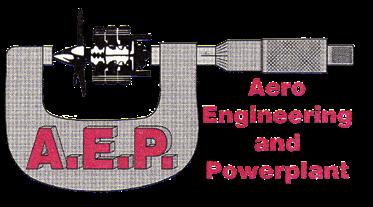

Fuel Prices as at 29/08/2023
Prices include VAT but exclude any service fees
Fuel Prices as at 28/09/2023
Prices include VAT but exclude any service fees
64 October 2023 Airfield Avgas Jet A1 Airfield Avgas Jet A1 Baragwanath R32,50 Baragwanath R37,00 Beaufort West R34,70 R 26,70 Beaufort West R35,80 R 26,70 Bloemfontein R33,53 R20,86 Bloemfontein R37,09 R21,82 Brakpan R35,00 Brakpan R35,40 Brits R30,45 Brits R31,10 Cape Town R34,04 R21,39 Cape Town R28,18 R22,43 Cape Winelands No Contact Cape Winelands No Contact Eagles Creek R34,00 Eagles Creek R34,00 East London R32,41 R21,37 East London R32,41 R17,07 Ermelo R31,51 R25,18 Ermelo R32,66 R24,73 Gariep Dam R35,50 R23,00 Gariep Dam R35,50 R23,00 George 33.08 R20,69 George R33,08 R22,13 Grand Central R33,98 R21,78 Grand Central R34,79 R25,36 Heidelberg R34,50 Heidelberg R33,60 R23,80 Hoedspruit R33,04 R23,44 Hoedspruit R31,37 R20,66 Kimberley R33,40 R15,65 Kimberley R37,16 R24,46 Kitty Hawk R37,70 Kitty Hawk R36,60 Klerksdorp R32,86 R24,22 Klerksdorp R35,50 R23,81 Kroonstad R34,04 Kroonstad R33,81 Kruger Intl Nelspruit R33,95 R25,15 Kruger Intl Nelspruit R33,84 R25,53 Krugersdorp R32,50 Krugersdorp R33,00 Lanseria R34,04 R23,00 Lanseria R35,54 R24,90 Margate R34,04 R23,06 Margate R34,04 R23,06 Middelburg R37,95 R23,00 Middelburg R37,96 R25,99 Morningstar R34,56 Morningstar R33,50 Mosselbay R37,50 R20,50 Mosselbay R37,50 R20,50 Nelspruit R32,32 R28,44 Nelspruit R35,25 R27,83 Oudtshoorn R35,49 R23,70 Oudtshoorn R35,19 R23,10 Parys POA POA Parys POA POA Pietermaritzburg R37,70 R24,32 Pietermaritzburg R34,20 R26,60 Pietersburg Civil R31,80 R23,70 Pietersburg Civil R33,70 R25,70 Plettenberg Bay R34,60 R25,00 Plettenberg Bay R25,00 Port Alfred R33,50 Port Alfred R33,50 Port Elizabeth R35,19 R24,84 Port Elizabeth R36,46 R25,65 Potchefstroom POA POA Potchefstroom POA POA Rand R34,10 R23,98 Rand R34,73 R24,50 Robertson R31,20 Robertson R32,00 Rustenberg R31,30 R23,65 Rustenberg R31,30 R23,65 Secunda R33,00 R25,88 Secunda R33,00 R25,88 Skeerpoort *** Customer to collect POA POA Skeerpoort *** Customer to collect POA POA Springbok POA POA Springbok POA POA Springs R33,70 Springs R34,36 Stellenbosch R33,20 Stellenbosch R38,70 Swellendam R33,30 R23,50 Swellendam R34,90 R21,50 Tempe R34,04 R25,33 Tempe R33,81 R25,56 Thabazimbe POA POA Thabazimbe POA POA Upington R34,00 R24,00 Upington R34,00 R25,00 Virginia R35,19 R23,12 Virginia R36,11 R24,84 Vryburg POA POA Vryburg POA POA Warmbaths R34,00 Warmbaths R34,00 Welkom R34,04 R25,33 Welkom R33,81 R25,56 Wings Park EL R32,50 R21,90 Wings Park EL R32,50 R21,90 Witbank R32,00 R25,33 Witbank R33,00 Wonderboom POA POA Wonderboom POA POA Worcester R34,31 Worcester R34,31
Airfield Avgas Jet A1 Airfield Avgas Jet A1 Baragwanath R32,50 Baragwanath R37,00 Beaufort West R34,70 R 26,70 Beaufort West R35,80 R 26,70 Bloemfontein R33,53 R20,86 Bloemfontein R37,09 R21,82 Brakpan R35,00 Brakpan R35,40 Brits R30,45 Brits R31,10 Cape Town R34,04 R21,39 Cape Town R28,18 R22,43 Cape Winelands No Contact Cape Winelands No Contact Eagles Creek R34,00 Eagles Creek R34,00 East London R32,41 R21,37 East London R32,41 R17,07 Ermelo R31,51 R25,18 Ermelo R32,66 R24,73 Gariep Dam R35,50 R23,00 Gariep Dam R35,50 R23,00 George 33.08 R20,69 George R33,08 R22,13 Grand Central R33,98 R21,78 Grand Central R34,79 R25,36 Heidelberg R34,50 Heidelberg R33,60 R23,80 Hoedspruit R33,04 R23,44 Hoedspruit R31,37 R20,66 Kimberley R33,40 R15,65 Kimberley R37,16 R24,46 Kitty Hawk R37,70 Kitty Hawk R36,60 Klerksdorp R32,86 R24,22 Klerksdorp R35,50 R23,81 Kroonstad R34,04 Kroonstad R33,81 Kruger Intl Nelspruit R33,95 R25,15 Kruger Intl Nelspruit R33,84 R25,53 Krugersdorp R32,50 Krugersdorp R33,00 Lanseria R34,04 R23,00 Lanseria R35,54 R24,90 Margate R34,04 R23,06 Margate R34,04 R23,06 Middelburg R37,95 R23,00 Middelburg R37,96 R25,99 Morningstar R34,56 Morningstar R33,50 Mosselbay R37,50 R20,50 Mosselbay R37,50 R20,50 Nelspruit R32,32 R28,44 Nelspruit R35,25 R27,83 Oudtshoorn R35,49 R23,70 Oudtshoorn R35,19 R23,10 Parys POA POA Parys POA POA Pietermaritzburg R37,70 R24,32 Pietermaritzburg R34,20 R26,60 Pietersburg Civil R31,80 R23,70 Pietersburg Civil R33,70 R25,70 Plettenberg Bay R34,60 R25,00 Plettenberg Bay R25,00 Port Alfred R33,50 Port Alfred R33,50 Port Elizabeth R35,19 R24,84 Port Elizabeth R36,46 R25,65 Potchefstroom POA POA Potchefstroom POA POA Rand R34,10 R23,98 Rand R34,73 R24,50 Robertson R31,20 Robertson R32,00 Rustenberg R31,30 R23,65 Rustenberg R31,30 R23,65 Secunda R33,00 R25,88 Secunda R33,00 R25,88 Skeerpoort
to
POA POA Skeerpoort
POA POA Springbok POA POA Springbok POA POA Springs R33,70 Springs R34,36 Stellenbosch R33,20 Stellenbosch R38,70 Swellendam R33,30 R23,50 Swellendam R34,90 R21,50 Tempe R34,04 R25,33 Tempe R33,81 R25,56 Thabazimbe POA POA Thabazimbe POA POA Upington R34,00 R24,00 Upington R34,00 R25,00 Virginia R35,19 R23,12 Virginia R36,11 R24,84 Vryburg POA POA Vryburg POA POA Warmbaths R34,00 Warmbaths R34,00 Welkom R34,04 R25,33 Welkom R33,81 R25,56 Wings Park EL R32,50 R21,90 Wings Park EL R32,50 R21,90 Witbank R32,00 R25,33 Witbank R33,00 Wonderboom POA POA Wonderboom POA POA Worcester R34,31 Worcester R34,31 Fuel Prices as at 29/08/2023 Prices include VAT but exclude any service fees Fuel Prices as at 28/09/2023 Prices include VAT but exclude any service fees aeroeng@iafrica.com (012) 543 0948/51 AMO No: 227 Hangar no 4, Won derboom Airport, Pretoria
*** Customer
collect
*** Customer to collect
Where romance meets nature


65 October 2023 FlightCom Magazine 35 Located in South Africa’s Safari hub of Hoedspruit, Safari Moon is a boutique base from which to discover the wonders of South Africa’s Lowveld region. Explore a range of nearby attractions from the famed Kruger National park to the scenic Panorama Route, or simply chose to relax and unwind in nature, making the most of your private piece of Wildlife Estate wilderness. CONTACT: bookings@safarimoon.co.za 083 449 5868
CHILDREN’S FLIGHT 2023:
DISADVANTAGED CHILDREN, and making their lives better, even if it’s only for a day, is what it’s all about. A day they will hopefully always remember. Felix Gosher has been the driving force behind the Children’s Flight since the first edition all those years ago and
has never lost the core values of the event: *Fly*Feed*Love*Inspire*.
The 2023 edition was again hosted by the Magalies Gliding Club at Orient airfield south of the quaint town of Magaliesberg.

66 October 2023
EVENTS
The Childrens Flight has reached a level that no one could have imagined at its inception in 2016. Sponsors are now competing to be part of this amazing event.
*FLY*FEED*LOVE*INSPIRE*
Text & Images: Garth Calitz, Tim Homan and Trevor Cohen
The family who makes it happen - Belinda, Felix and little Dante Gosher. Image Trevor Cohen.
The day started early with a tethered balloon flight by Bill Harrop’s Balloon Safaris for some lucky children. Once the balloon was back on the ground the children made their way to the main event alongside Runway 36 left.

A SAAF Casa 212 arrived, carrying Maj. Gen Lancelot Mathebula, SAAF Chief Director Force Preparation. He was there on behalf of the Chief of the Airforce, Lt. Gen Wiseman Mbambo. The SAAF had pledged a SAAB Gripen and a BAE Hawk display, depending on serviceability and operational commitments. Unfortunately only the flag liveried Hawk was available.
The day was officially opened with a skydiver drop from an Antonov AN2 accompanied by the national anthem and reciting the Lord’s Prayer, followed by a Harvard display by the Puma Energy Flying Lions.

With the formalities done, it was time for the wide-eyed youngsters to get their first taste of flight; some in helicopters and some in fixedwing aircraft. The flights continued throughout the day with children returning with a massive smile and many pilots with a very visible tear in their eye. Offering the gift of flight to extremely underprivileged children tugs the heartstrings of even the most hardened aviator.
The children were not only treated to flights, but food and drinks, with many of the larger restaurant chains and fast food outlets supplying all the food the visitors could consume.

After lunch the events stepped up a gear for the airshow segment. The first on the cards was the thunder of the SAAF Hawk, followed by a Gyro display by Andre van Zyl. Next was a four-ship RV Raptor display by Nigel Hopkins, Ryan Beaton, Trevor Warner and Dion Raath.
Not to be outdone by the fixed wings, Menno Parsons took to the air in his Bell UH-1H Huey. The children loved seeing an aircraft they
67 October 2023
Children are led out to the more than 100 aircraft. Image Tim Homan.
The huge heart flown by Jason Beamish and Nigel Hopkins.
There was endless entertainment. Image Trevor Cohen.


68 October 2023
Felix Gosher with Maj. General Lancelot Mathebula.
Loading a Caravan.


69 October 2023
Mike Puzy with 3 children in his RV-10.
A busy Alouette II.


70 October 2023
The SAAF provided the flag coloured Hawk Mk120.
Wide eyed children. Image Tim Homan.


71 October 2023
The SAAF CASA 212 gets airborne.
A Skydiver flies the (threadbare) flag.
had earlier flown in, dancing in the perfect blue sky. Then the air was once again filled with the sound of a jet engine, as Mike Weingartz flew a graceful display in the Aero L-39 Albatros.
After their initial display, Nigel and Trevor had headed directly to The Coves to change aircraft. They returned a while later in the Goodyear Eagles Pitts Specials in which they were joined by Jason Beamish and Johan von Solms. Andrew BlackwoodMurray then followed in his Nashua-sponsored Extra 300LX.

Johan “Juba” Joubert was next up in the Aerospatiale Gazelle. Juba effortlessly threw the helicopter around the sky and many of the kids were seen telling their friends they had flown the same way earlier in the day.

Jason Beamish and Nigel Hopkins returned once again, this time in their Extra 330s. For some reason Nigel and Jason had swapped aircraft for the display. Their display started with a massive heart drawn in the sky with smoke,
which brought a mighty cheer from the children. The display was concluded with their signature double knife-edge pass.
The airshow segment of the day proved to be a massive hit with the children, who were mesmerised by the manoeuvres. As the day drew to a close all 500 children were loaded the onto buses and back to their respective children’s homes, hopefully with a feeling that they are loved, fed and inspired to reach new heights.
trying to decide which talks to attend j

Felix Gosher, his wife Belinda and the huge Children’s Flight Team deserve a massive accolade for once again organising a brilliant event. A common question is, “Where does Felix get his energy from?” My guess is that he has much love to give.
To all the pilots, helpers, volunteers and sponsors that are the backbone of these events, this year was a bumper one with over 100 aircraft to fly the children. We congratulate you all and look forward to next year.
BUMPPPFFF:
72 October 2023
The perfect symmetry of a swallow in flight.
For the electronics freaks, this is the inertial navigation system fitted to Concorde. For redundancy, three of these were fitted to each aircraft.
A great display by the Red Arrows



73 October 2023 CALL US NOW FOR ALL OF YOUR AVIATION NEEDS! AIRCRAFT MAINTAINENANCE AND REFURBISHMENT QUALITY IS OUR PASSION Skysource International SA, Hangar 203, Lanseria International Airport South Africa SOUTH AFRICA Aircraft Maintenance based at Lanseria International Airport South Africa. FAA USA Worldwide Aviation Resources Aircraft Sales, Purchasing, Maintenance and Consulting. AMO 1427 info@skysourcesa.com +27 10 900 4300 • +27 72 036 3433 WE SPECIALIZE IN: Beechcraft 90 Series Beechcraft 200 Series Beechcraft 350 Series Beechcraft 1900D Series Cessna Caravan C208 Series Aircraft With Full Aircraft Maintenance and Refurbishment, Paint, Upholstery, Defect rectification, Pre-purchase Inspection Capabilities. Decades of experience! Sheet Metal + Avionics Maintenance + Installation SA Flyer 2023|09 www.skysourcesa.com PTY
Text and Images Trevor
Cohen
VIRGINIA AIRSHOW 2023
A WELCOME RETURN TO AN OLD FAVOURITE
WHEN THE CAA IMPLEMENTED the new airshow regulations it was thought that Virginia could never host another show. However, where there is a will there is a way, and the installation of substantial safety barriers to prevent wayward aircraft careering into the crowd satisfied the safety requirements and the

show was given the green light.
The day started with and intense pilot briefing as there were many different frequencies – and anyone above 1000 feet AGL was going to need radar vectoring due to the proximity to King Shaka. The irony is that for a short time
74 October 2023
EVENTS
It has been a decade since Durban aviation enthusiasts were treated to an airshow at Virginia.
The big thing for Virginia was keeping the crowd line far back from the air show display line. Image Trevor Cohen.
during the morning, the radar system went down and the show was put on hold for a short period.
As the display line was over the beach, access by the public to the beach had been stopped from early in the morning. The organizers also had to have the NSRI and navy divers on fast boats in case of an incident out to sea.
the radar system went down
The Airshow was officially opened with a skydiving display performed by Durban Parachute Club, dropped by Johan “Juba” Joubert from an Aerospatiale Gazelle.
The Marksmen Aerobatic team were first up, flown by Mark Hensman, Johnie Smith and Eugene du Preez in an MX-2 and 2 Extras. Their display had to be modified as they do a crowd pass right after take-off, and the runway is too close to the crowd line. The display ends with a knife edge pass and a high-speed inverted pass from the opposite direction.

Dave Mandel, who is based in Plettenberg Bay, displayed with his Aero L-39 Albatros. His graceful display was interrupted due to the radar glitch, but he still beautifully showed the capabilities of this eastern-bloc Jet.

A three-ship de Havilland Chipmunk formation was next up flown by Rodney Chinn, Grant Timms and Ryan Briggs.
Juba Joubert then returned for a display in the agile Aerospatiale Gazelle. Scully Levin

75 October 2023
The Beech-18 was polished for the Airshow. Image Tim Homan.
Andrew Blackwood Murray makes it look easy.
The vintage Chipmunks.

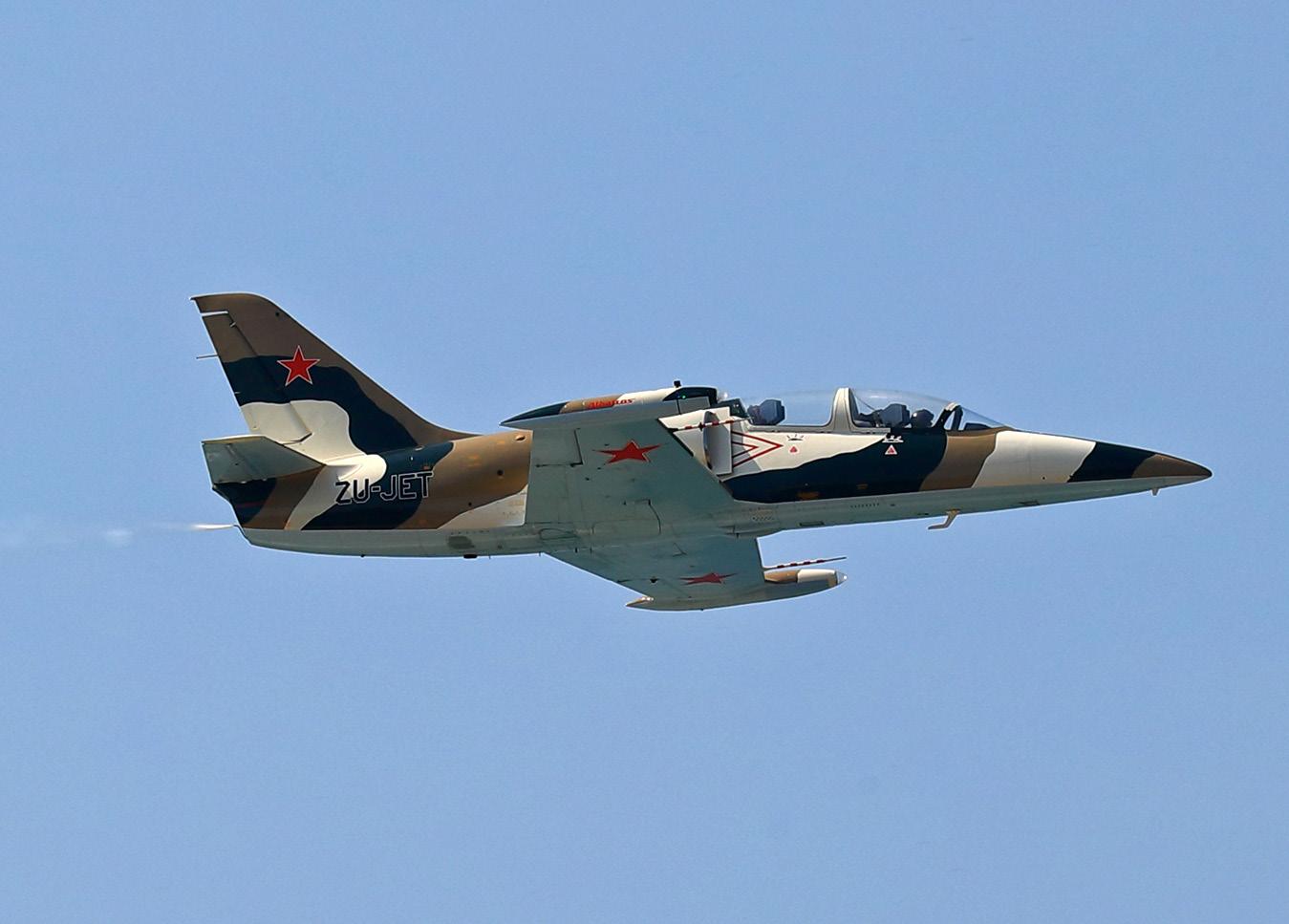
76 October 2023
Scully Levin gives a lesson to another instructor in a Cirrus.
Dave Mandel brought his L-39 from Plettenberg Bay.


77 October 2023
The Airlink Embraer E195 is a big crowd puller.
Brian Emmenis and Capital sounds at the centre of things. Image Tim Homan.


78 October 2023
Juba Joubert in action in the Gazelle.
Patrick Davidson brought his Gamebird from Port Elizabeth.
Despite tight budgets the SAAF displayed a BK-117.


79 October 2023
Safety requirements included air-sea rescue and divers. Image - Tim Homan.
put a young flight instructor through his paces in a Cirrus showing the general public what this beautiful aircraft is capable of.
Trevor Warner and Ryan Beaton performed a new look show with two RV-7s, doing the opposite of what they did last year where they finished with the single aircraft following the leader in a tail chase.

The SAAF, all the way from PE, represented by Major Jared Oliver and Flight Sergeant Coert Steynberg, showed everyone how they operate with cargo slings and how the BK 117 performs. They also displayed how they use the on-board winch to lower and lift people.
senior display pilots are nearing the end
In a novel display, Roger Deare flew his Extra 300 along the runway at different altitudes. The crowd were informed of the altitude on every pass. A group of contestants then had to guess the altitude of a final pass, the closest won a hamper from the sponsor.
By this time there were close to the maximum of 8500 people in attendance if there was more place available I have no doubt that it would have been filled.
Patrick Davidson, also from PE, raised the temperature with his fast and energetic display in his Gamebird GB-1 sponsored by Red
Brian Emmenis from Capital Sounds worked the crowd as “Black Betty”, Airlink’s latest Embraer 195 was running in, flown by Captains Jaco Henning and Dean Nicholas. Jaco brought her in from the south west low level a few hundred feet above the tower. As he reached the runway centreline
80 October 2023
Bull. Patrick showed the crowd why he is an aerobatic champion and Red Bull Pylon racing pilot.
The Marksmen team from Cape Town.
the aircraft banked steeply left and gave the crowd a top view. As she was descending to land on the short runway, just before touching down he did a go-around. She then did a spiral climb over the runway to the sounds of opera music played by Capital Sounds and the applause of the crowd.
Andrew Blackwood-Murray in his Extra 300 took to the air to do his aerobatic dance in the sky. Andrew has a graceful way of displaying very difficult manoeuvres that makes them look almost effortless.

Ex-SAA pilot Flippe Vermeulen took to the air in his Beach 18 twin radial to show the Durban crowd what a passenger aircraft of this size can do.
The Puma Energy Flying Lions ended the morning programme with a smooth and energetic display. The afternoon show was pretty much a repeat of the morning programme.
Staging an airshow has become an almost impossible task, firstly the current economic situation is in itself prohibitive, for both the organisers and the display teams. The amount of work that has to be done just to get CAA approval for an airshow is immense. Without the dedication of the Airshow South Africa team this would prevent airshows taking place.
Post Covid, the aviation landscape has changed drastically, both at home and abroad. Many of the regular airshow display pilots had to find greener pastures outside our borders leaving a large void in our airshow line-up. The remaining pilots are “hotbedding” between aircraft to keep the spectators entertained.
In the past there, sadly, wasn’t very much effort made to bring young aviators into the airshow fold and this is starting to be felt as some of the senior display pilots are nearing the end of their careers and there are no replacements for them. j
81 October 2023
The RV Raptors in characteristically tight formation. Image Tim Homan.
FUNKE AVIONICS
FUNKE AVIONICS HAS A STRONG and loyal following in South Africa.
Formerly named Filser Electronics, it was well known for its compact VHF-COM the ATR500, fitted to many gyrocopters and fixed wing Light Sport Aircraft.
A lot has changed since then, and with a (funky) new name and shareholders, Funke took over the old Walter Dittel FSG range, introduced a wide range of compact VHF-COM and Mode-S transponders and developed state of the art communication and navigation sub-systems for such companies as Airbus, Lufthansa, Thales
Funke's industry standard FSG90 VHF Transceiver.
worldwide for military and air traffic control applications

82 October 2023
AVIONICS
Alenia Space, Eurocontrol and the European Space Agency.
PJ Aviation been supplying and supporting Filser/ Funke products on and off for almost 30 years, and has recently been appointed by Funke Avionics as their South African representatives for sales and technical support.

with a (funky) new name and shareholders
Funke’s general aviation range is all EASA approved and comprises VHF-COM in both 57mm and 160mm stack formats.
The new ATR833S is a follow on from the well-known ATR500, now with all the modern attributes such as dual watch and VOX intercom, at an unbeatable low price. Funke’s transponders are all Mode A/C/S Class 1 250w types, ready for full ADS-B compliance, also in 57 and 160mm stack mount format.
The now famous FSG90 was the last VHF transceiver developed by Walter Dittel GmBH. Mostly used in ground stations, it has been the only radio available that was certified for use in European airports, and specified worldwide for military and air traffic control applications.
83 October 2023
j
PART 2
KALAHARI BUNDU BASH
In part 1 of this photo essay well known
Cape
gyro
pilot and environmentalist Jean Tresfon described the flight from Cape Town's Morningstar airfield to the remote Koppieskraal Pan in the Northern Cape.
THE 2023 KALAHARI BUNDU BASH Flying Adventure is a fly-in of aviators and their aircraft on a salt pan in the middle of nowhere in the incredible Kalahari desert region of South Africa.

The venue, Koppieskraal Pan, is a privately owned 13 km long mud and salt pan located 63 km southwest of Twee Rivieren, the gateway to the Kgalagadi Transfrontier Park, and adjacent
to the better known Hakskeen Pan, the venue for the Bloodhound land speed record attempt.
The smooth flat surface of the pans makes for a perfect landing strip in any wind direction, so pretty much any aircraft can join the gathering.
Organised by the Mocke family in Upington, the Bundu Bash has been running every couple of
84 October 2023
CAPE TO THE KALAHARI
Text and Pics - Jean Tresfon
Stunning light over the pan just before sunset and of course my trusty steed, an Autogyro MTO Sport gyrocopter.
years since 1987 and then, for many reasons, stopped a decade ago after the 2013 event.
This year the next generation of the family, siblings Eben and Gavin Mocke and Yolande Mocke-Combrinck, decided to revive the event and pulled off a remarkable gathering of 79 different aircraft and 127 pilots and crew.
Attendees bring their own tents and sleeping gear, and generally sleep next to their aircraft, but that is where the camping ends and the glamping starts...

There’s a massive marquee tent setup with a full restaurant and bar inside, complete with white linen tablecloths and beautiful table decorations. Coffee and tea are available all day and a sumptuous breakfast, lunch and dinner are all included. The quality of the food was simply outstanding! And of course there are piping hot showers, flushing toilets and all the other amenities required, even charging stations for electronics and an ambulance and paramedics, thankfully not required.
Over 40,000 litres of water and 12,000 litres of fuel have to be trucked in for the event, together with everything else.
The entire setup is dismantled and taken back to Upington afterwards, leaving the pan exactly as it was before the event. The level of organisation and preparation required is mind-boggling, but the Mocke family were up for the challenge and this year’s edition was just incredible.
So what’s the whole point? Apart from just a love of aviation, the Mockes enjoy showcasing and sharing their magnificent part of the world with aviators from all over the country. Three days spent flying over the beautiful red dunes of the Kalahari, spotting herds of the iconic gemsbok, springbok, bat-eared foxes and a huge variety of other game and birds goes by far too quickly.
The camaraderie and “gees” are a major part of the event. Pilots being pilots, there is nonstop talk about flying and aeroplanes. Almost everyone offers others a chance to fly their aircraft and I usually leave the event having
85 October 2023
Arriving overhead Koppieskraal Pan with quite a few aircraft having already arrived.
Enjoying the nothingness from the middle of Hakskeen Pan.
flown a variety of planes and gyrocopters, and of course also having given the same opportunity to many others. This is such a diverse gathering of pilots, with a vast experience base. The opportunity to learn and grow as a pilot is a major drawcard.

After three unforgettable days of flying and socialising on the pan, the event draws to a close and it’s time to fly home again.
The faster aircraft get home in just a few hours, while for others it is a full two days of flying just to get back.

86 October 2023
Sunrise over the marquee tent and time for coffee and a rusk.
The Kalahari is a strange place. At first glance it seems to be a dry, barren and inhospitable environment, yet its keeps you coming back

for more. For weeks after getting back to Cape Town, I keep finding my thoughts drawn back to those beautiful red dunes and fiery sunsets.

87 October 2023
Hungry pilots walking to the marquee tent for a breakfast.
Catering
for 127 hungry people is no simple task, but the catering crew made it look easy!

88 October 2023
Opening the tent in the morning and the first thing I see is my gyro...! What's not to love!
Breakfast done and time to go fly..
In the middle of nowhere, after landing on Hakskeen Pan with 20km of nothing in every direction!
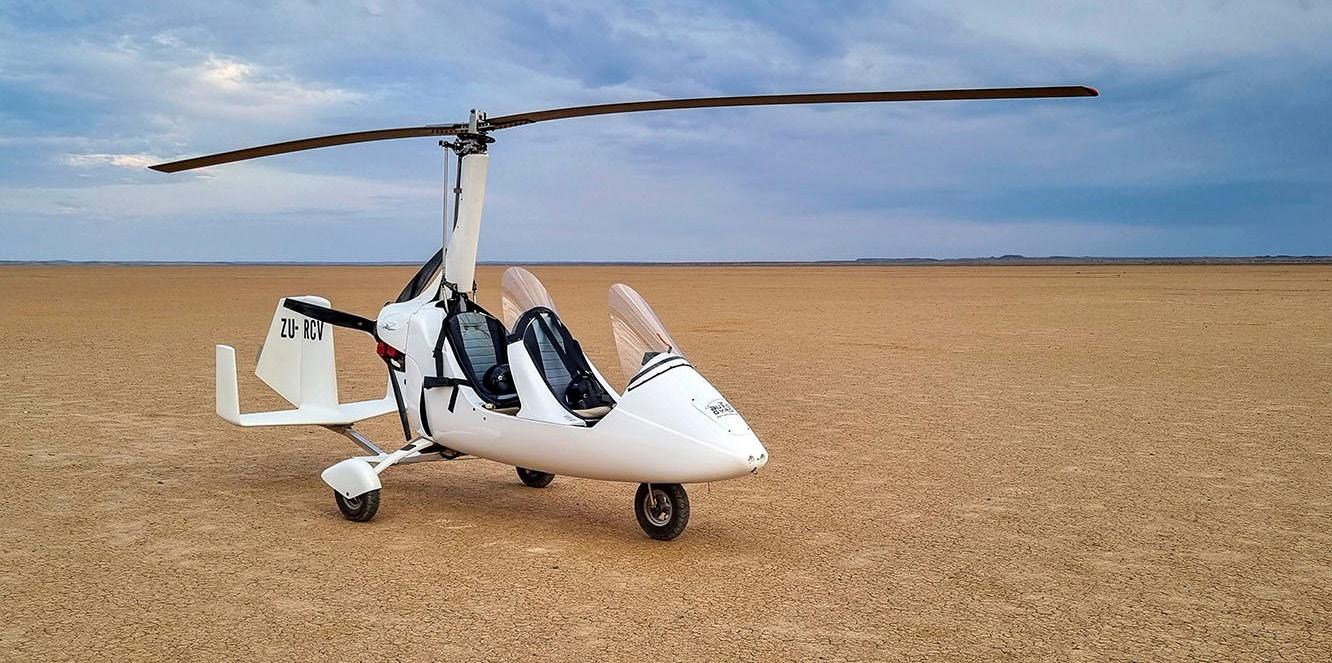


89 October 2023
The Morningstar gyrocopter crew's camp.
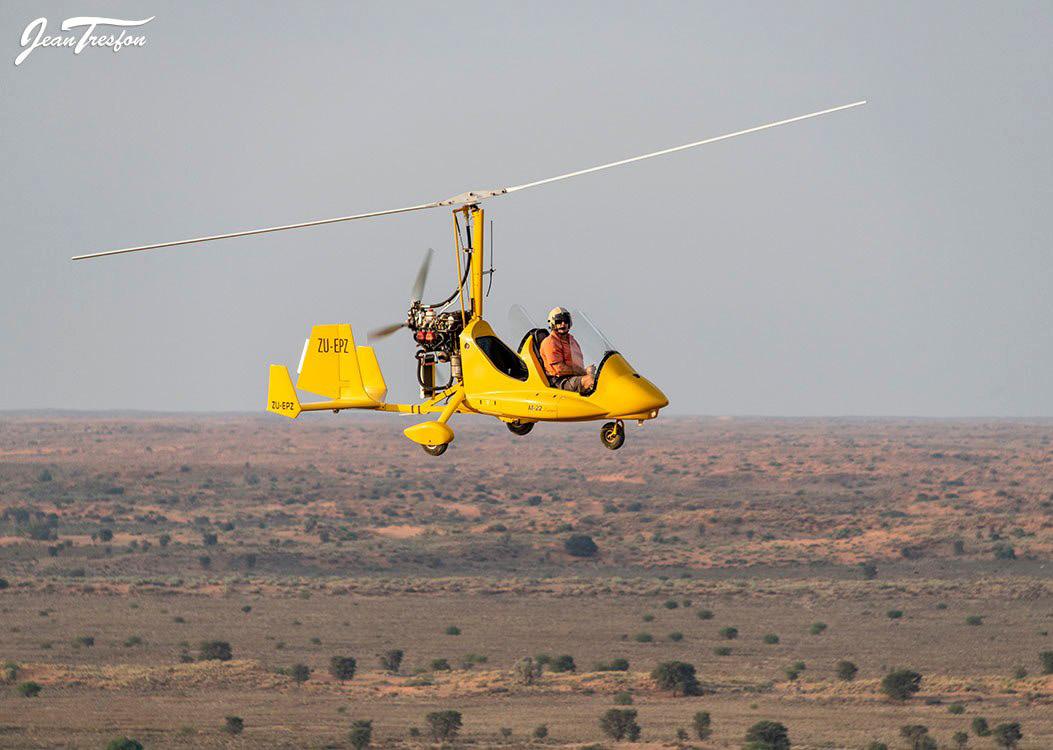

90 October 2023
Dave flying his stunning Magni M22 Voyager gyrocopter at sunset.
A herd of gemsbok on the dunes.



91 October 2023
Flying back to Koppieskraal at sunset after an evening sortie, lovely shot by Karl!
Breakfast done and time to go fly... This stunning Bosbok was one of the more unique aircraft to attend the 2023 event.
Sunrise at our camp on Koppieskraal Pan.


92 October 2023
the nothingness from the middle of
Enjoying
Hakskeen Pan.
Trevor and Mark with the C206 'Hilux' on Hakskeen Pan.
A massive thank you to everyone who played a part in making this year’s event such a memorable occasion, from the organisers and their large team of helpers, to the people that flew in from far and wide and were the

reason for the event itself, and of course to my wingmen on the journey to and from Cape Town, it was truly a pleasure flying with you guys!

93 October 2023
Koppieskraal Pan in sight, our destination and base for three days of exploring the Kalahari from the air.
j
The camp is spread out along the edge of Koppieskraal Pan. From one end to the other there was a 1km stretch of planes!
POOLEYS AIR PILOT’S –
SOUTHERN AFRICA SERIES
Manual #1 Flying Training
THE FIRST BOOK IN THE SERIES is simply called ‘Flight Training’ and if there is just one essential PPL textbook you can afford to buy at a time, this is it.
Flight Training is the book that teaches you how to get a Private Pilot’s Licence (PPL). It is structured so that it follows the SACAA’s flight training syllabus from Exercise 1 (Aircraft Familiarisation) to Exercise 19 (Instrument Flying).
For readers looking for an overview of the PPL Exercise structure – here is a detailed breakdown of the curriculum as required by the SACAA and covered chapter by chapter in this book:
Exercise 1: Aircraft Familiarisation
Exercise 2: Before and After Flight
Exercise 3: Air Experience
Exercise 4: Effects of Controls
Exercise 5: Taxiing
Exercise 6: Straight and level
Exercise 7: Climbing
Exercise 8: Descending
Exercise 9: Turning
Exercise 10: Stalling and Slow flight
Exercise 11: Spinning
Exercise 12: Standard Take-off and Climb
Exercise 13: Circuits, Approach and landing
Exercise 14: First Solo
Exercise 15: Advanced Turning
Exercise 16: Forced Landing without power
Exercise 17:
Precautionary Landing
Exercise 18: Pilot Navigation.
Exercise 19: is Instrument Flying, which is not part of the basic PPL syllabus.
As South Africa’s doyen of flying instructors, Jim Davis, likes to point out, cockpits make bad classrooms. Therefore, before each flight your instructor should brief you on the principles of flight relevant to the practical flight exercises you are about to do. This is where these textbooks are invaluable.
You prepare for each lesson by reading up on the lessons the night before. And that’s where this book comes in. In each chapter the lesson is thoroughly explained, with Pooleys standard of clarity and excellent diagrams to aid the explanations.
94 October 2023
BOOK REVIEW
Pooleys Air Manuals have set a new standard in essential texts for the Private Pilot Exams – and they are now publishing the series for Southern Africa.
the best investment a budding pilot can make
Guy Leitch
Using this book to prepare for the lesson is the best investment a budding pilot can make. It will make understanding what may seem to be complex concepts much easier and will thus improve your ability to learn from the flight lesson.
If this book saves you just one hour’s flight training while you struggle to get to grips with an exercise, it will have paid for itself many times over. And most importantly – it may remove those discouraging moments when it all just seems too much, and you are tempted to chuck it in.
At the end of each chapter there’s a selection of well-constructed questions to test your knowledge – with the answers supplied over the page. And at the back of the book is the Skills Test Form that your flight test examiner will use. This is an invaluable insight into what the examiner looks for and how s/he is likely to grade your performance.
This book covers everything needed to understand about how to fly a plane, so it’s also ideal for those who are just interested in understanding fixed wing flying, and especially for those starting out with computer flight simulators.
Quite simply, this is an excellent reference book that is required study material to get the most out of every flying lesson. It should be a reference on every pilot’s bookshelf. The bottom line is – if you are learning to fly – this is the reference that you need.
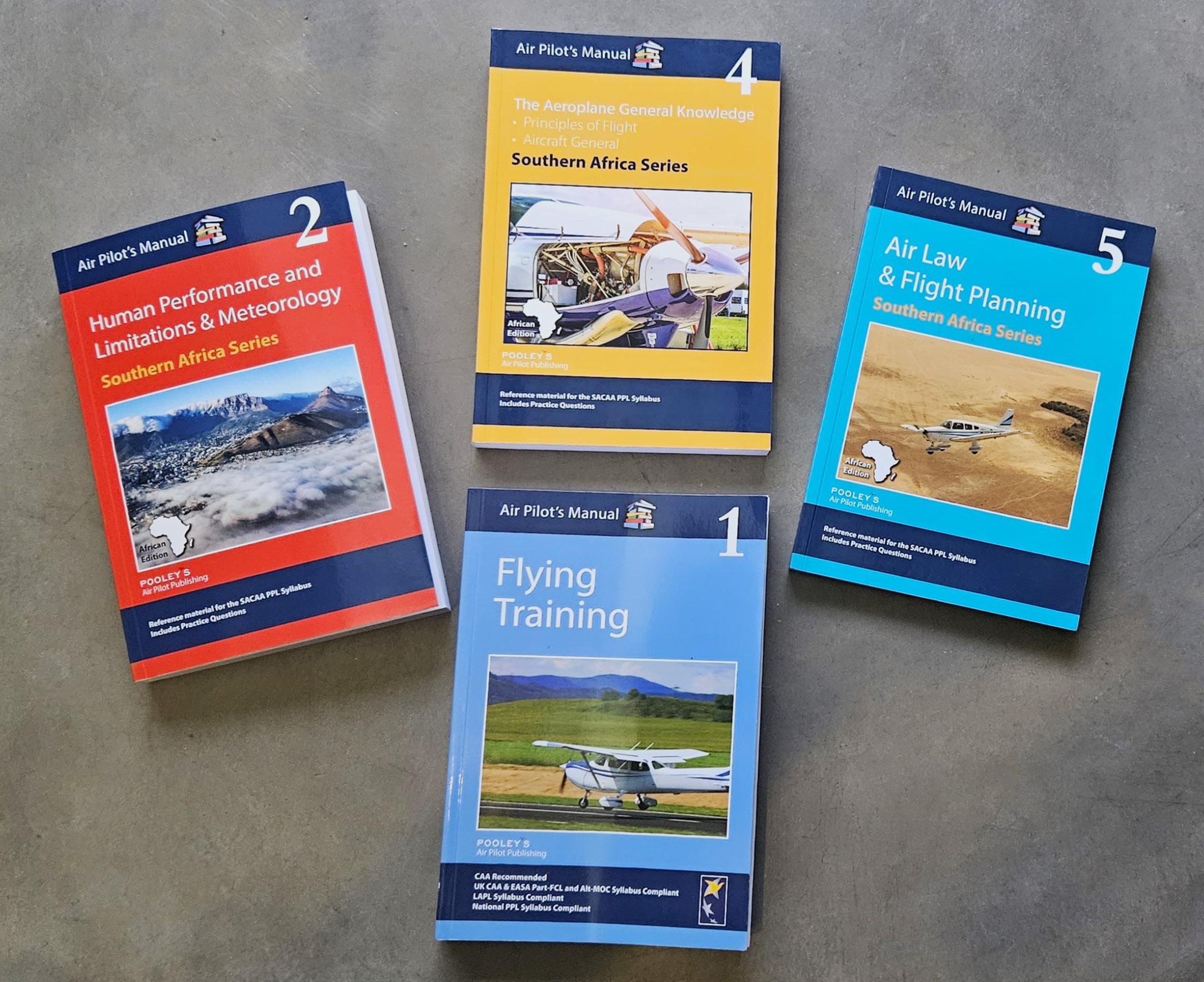
The books may be obtained from all good pilot supply stores – or order online from: https:// www.pooleys.com/shop/category/ppl-trainingmaterial-starter-kits/ppl-exam-preparation-books/
j
95 October 2023
Some of the Pooleys Southern African series.
POOLEYS AIR PILOT’S MANUALS
POOLEYS IS A WORLD-RENOWNED reference for both the student pilot and instructor. The publications aim to standardise the quality of flying training, teaching and learning equipment for flight schools and their instructors.
Users have the comfort of knowing that all the aviation training publications Pooleys produce have been closely checked by the leading flight schools and instructors. Their textbooks are constantly updated, edited and revised.
The key volumes published for Southern Africa so far are:
Volume 1: Flying Training
Volume 2: Human Performance and Meteorology
Volume 3: Navigation
Volume 4: The Aeroplane: Principles of Flight and Aircraft General
Volume 5: Air Law and Flight Planning.
Pooleys does not only produce books, they also have a strong online digital product range. Students can download a free PPL e-Exam
Learning Objectives Guide which crossreferences the Learning Objectives from the exam feedback to the relevant chapters in the Air Pilot’s Manuals. Visit https://www.pooleys. com/shop/category/books-ebooks-manualsresources/air-pilots-manuals-for-southern-africa/

96 October 2023
Pooleys Southern African series book on Navigation.
In 2022 the world-class Pooleys Air Pilot Manual series launched the first of their Southern African Series. They have now expanded the African series to include four more titles.
BOOK REVIEW j







97 October 2023 73 July 2023 www.pooleys.com T: +44 (0)20 8953 4870 email: trade@pooleys.com – Established 1957 –Celebrating 66 Years Service to Aviation Based on the hugely successful UK and EASA series of Air Pilots Manuals that have helped over 250,000 pilots complete their PPL, they have been created specifically for the Southern African market. Available now from: Pooleys launches a new series of PPL Training Manuals for Southern Africa www.pilotsnplanes.co.za
Text and Images Garth Calitz
GRAND RAND AIRSHOW 2023
Rand Airport in Germiston became a hive of activity on Sunday 3 September when it hosted the 2023 Grand Rand Airshow.

THE ORGANISERS WERE BLESSED with wonderful weather, albeit a bit windy. Sadly, the attendance numbers were not quite what the show has become accustomed to.
The airshow started at 10:00 with a solo display by Grant Timms in a tiny single seater Sonex
OneX Taildragger. Once safely back on the ground Grant quickly switched to a De Haviland Tiger Moth. Grant was joined by old hand Rodney Chinn for a graceful display in these veteran schoolmasters of the sky.
Menno Parsons then clattered in with the “Tiger
98 October 2023
EVENTS
A highlight for many was the unique Embraer 195 of Airlink.
Girls” in his Bell UH-1D Iroquois (Huey). The Tiger Girls were offloaded and their places were taken by a troop of skydivers led by Graham Field. This marked the official opening of the Airshow.
The Puma Energy Flying Lions Harvards got airborne while the Huey climbed for altitude. The sound of the radial engines still pulls the emotional heartstrings of anyone who spent time in the South African Airforce.
Andre Coetzee was next up with the new “Kids Flight” Helicopter. Henley Air has responded to the need by Neo-natal and Paediatric medical workers by designating this heli to exclusively transport babies in need.
the P-51 swooping flypasts.

Tristan Eeles is stepping into his dad Barrie’s shoes in pairing with Elton Bondi. The two fly the same aerobatics sequence from opposite sides of the display line. Tristan, Elton and Barrie will be heading to Las Vegas to compete in the Advanced World Aerobatics Championship.
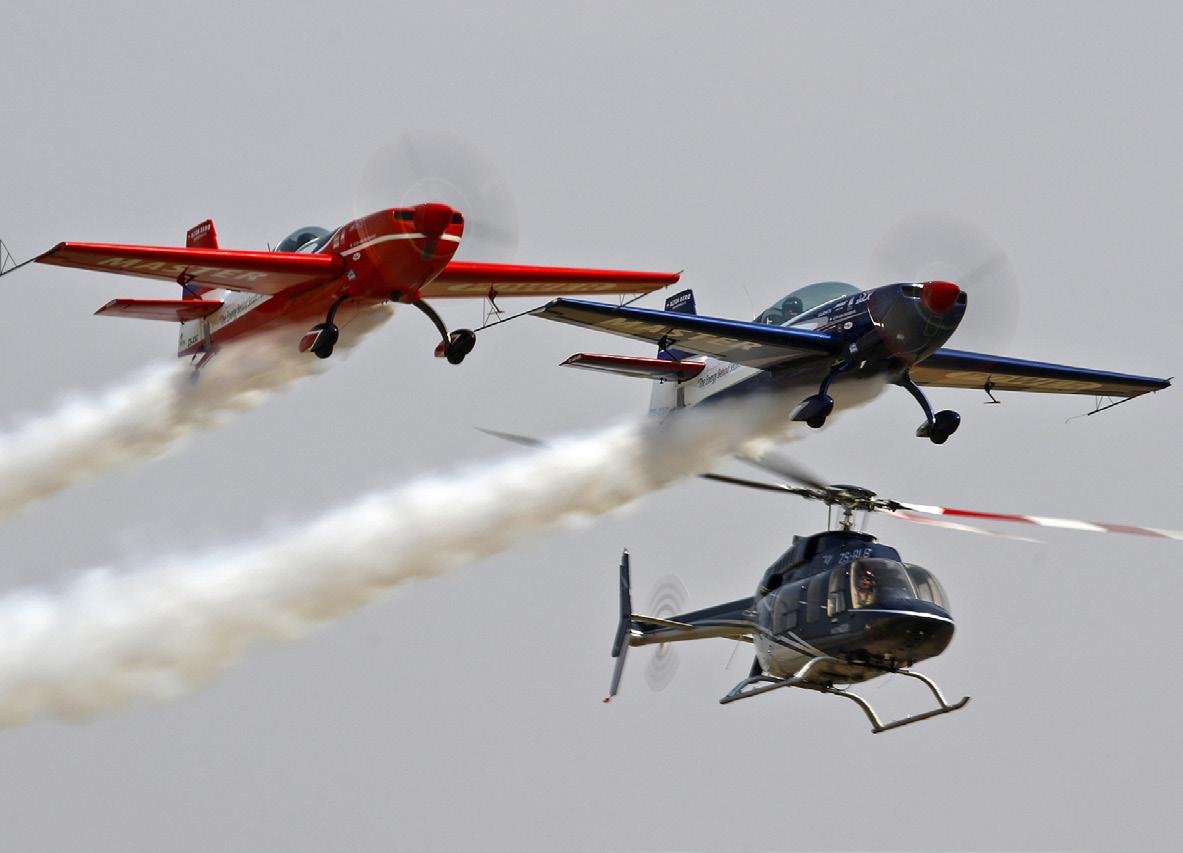
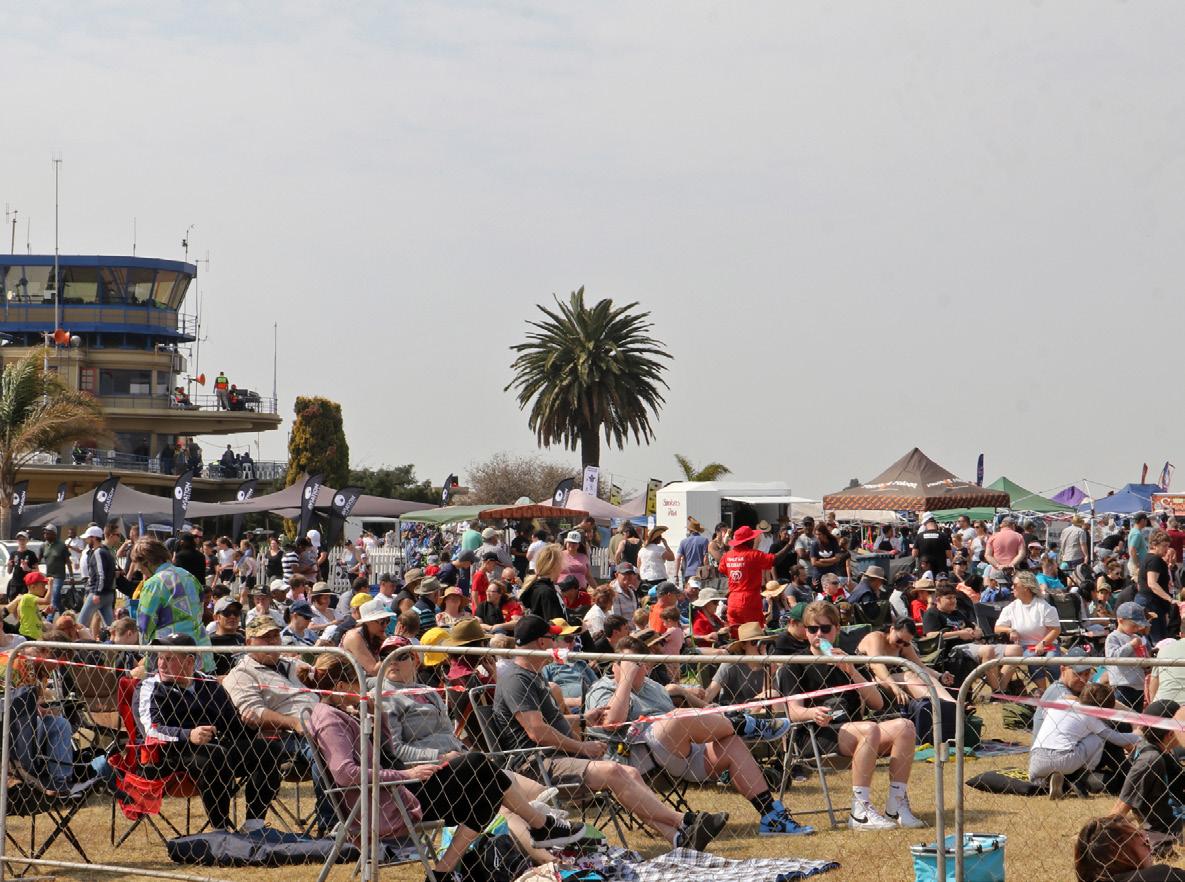
They were followed by the Goodyear Eagles with a precision display of formation and solo aerobatics. The team is led by Nigel Hopkins accompanied by Trevor Warner, Jason Beamish and Johan von Solms.
Mustang Sally then made her first appearance flying a series of high-speed passes. The smile on Menno Parsons’ face when he landed and taxied past the crowd proved just how much he enjoys flying his WWII fighter. Staying with the Master Power Aviation stable, it was time for Mike Weingartz to provide jet action in the Aero L-39 Albatros.
99 October 2023
The airshow is held on a Sunday - and the large crowd enjoyed the great weather.
The classic Beech 18 mini-airlinerfeatured in this issue.
Unusual formation of Extras with a Bell 407.


100 October 2023
Oscar Goudriaan in his jet powered JS3 glider.
The unique neo-natal Bell 222.

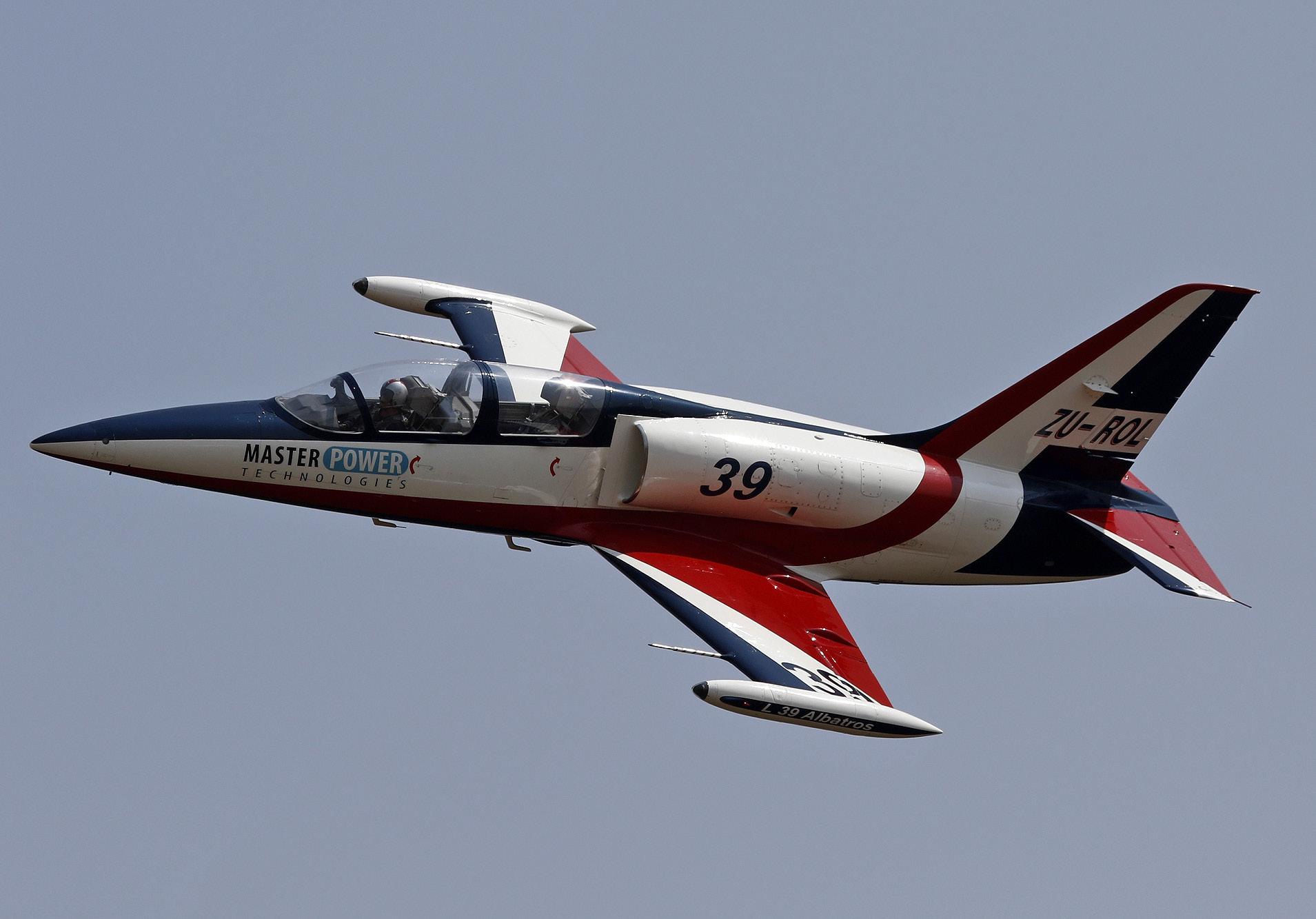
101 October 2023
Juba Joubert amazed in the Aloette 2.
Impala display pilot Mike Weingartz in Menno Parsons' L-39.
The show pace slowed down when Scully Levin flew a Cirrus SR-22 but then Andre van Zyl had the crowd gasping with his Magni Gyro display when he switched on a smoke system before spiralling down.

Oscar Goudriaan, in his beautiful Jonker JS3 Rapture jet glider was aero-towed by Riaan Denner in a Sling 2. Oscar flew a smooth aerobatic display accompanied by Gheorghe Zamfir, a fresh choice of music, thanks to Brian Emmenis of Capital Sounds. Once Oscar had bledoff some altitude he ignited the small but effective turbine which pops up behind the canopy.
The sound of the twin radials
Captain Flippie Vermeulen took to the air in his beautifully restored Beech 18. The sound of the two radials is to be savoured. Then Nigel Hopkins, Ryan Beaton, Trevor Warner and Johan von Solms picked up the pace with a superb display of formation aerobatics in Vans RVs.
The RVs were followed by a four-ship display of two Harvards and two Extra 300s. In his Nashua sponsored Extra 300, Andrew Blackwood-Murray then showed what it takes to make the national advanced aerobatic team.

After all the hi-impact aeros the pace slowed again with a three-ship formation of de Haviland Chipmunks flown by Rodney Chinn, Grant Timms and, in his first airshow display, Ryan Briggs. The vintage trainers battled with the strong wind but nonetheless delivered a great display.
The sound of rotor wings then filled the air with Menno Parsons and Buzz Bezuidenhout flying the Bell 407 and Huey respectively. After the display Menno hastily made his way to the threshold of runway 35 to accompany the two Extras 330s of Nigel Hopkins and Jason Beamish. Nigel joined Menno for a bit of hovering while Jason flew around them. Nigel then broke off and performed a freestyle aerobatics display incorporating many gyroscopic manoeuvres.
Nigel had to land promptly as the Airlink Embraer E195 ran in, with its unique black livery. Captain Jaco Henning did an outstanding job manoeuvring the airliner in the relatively small Rand airspace. Airlink is now the largest operator of Embraer aircraft in the world.
102 October 2023
The tiny Sonex opened the show.
Menno Parsons' P51 Mustang Sally is a Rand Airshow stalwart.
The Hired Gun Coffee Pitts Special team kept the crowd on their feet with another faultless display by Scully, Arnie, Sean and Ellis. Then world-renowned helicopter pilot, Johan “Juba” Joubert took to the air in an Alouette II.

Jason and Nigel took off for a final display and were joined by the P-51 for a series of swooping flypasts. The final display was by the Puma Energy Flying Lions, accompanied by il Silenzio’s trumpet solo which was a fitting end to another excellent Rand Airshow. j
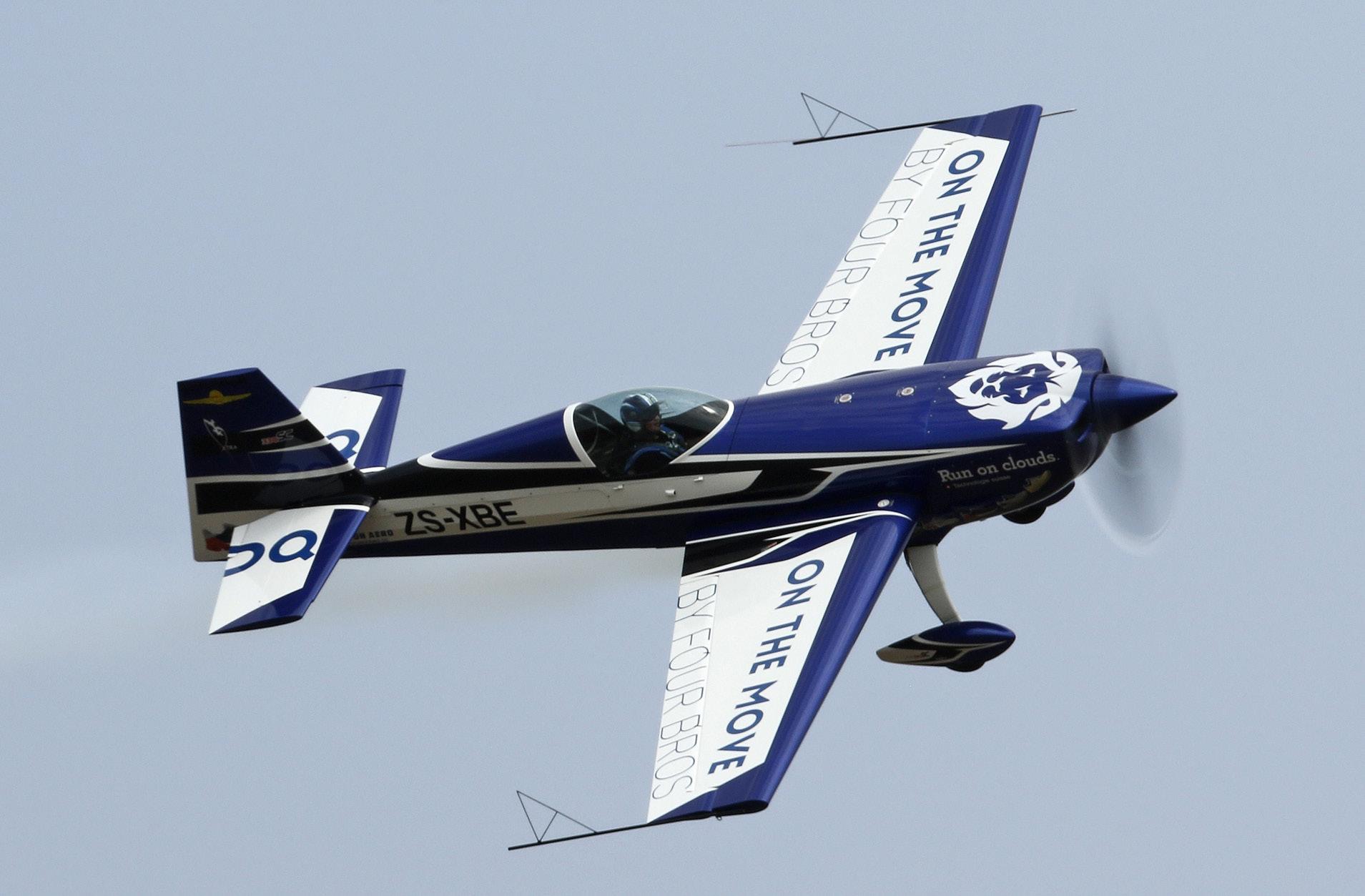
103 October 2023
Juba Joubert amazed in the Aloette 2.
Tristan Eeles has stepped into his father Barrie's big airshow shoes.



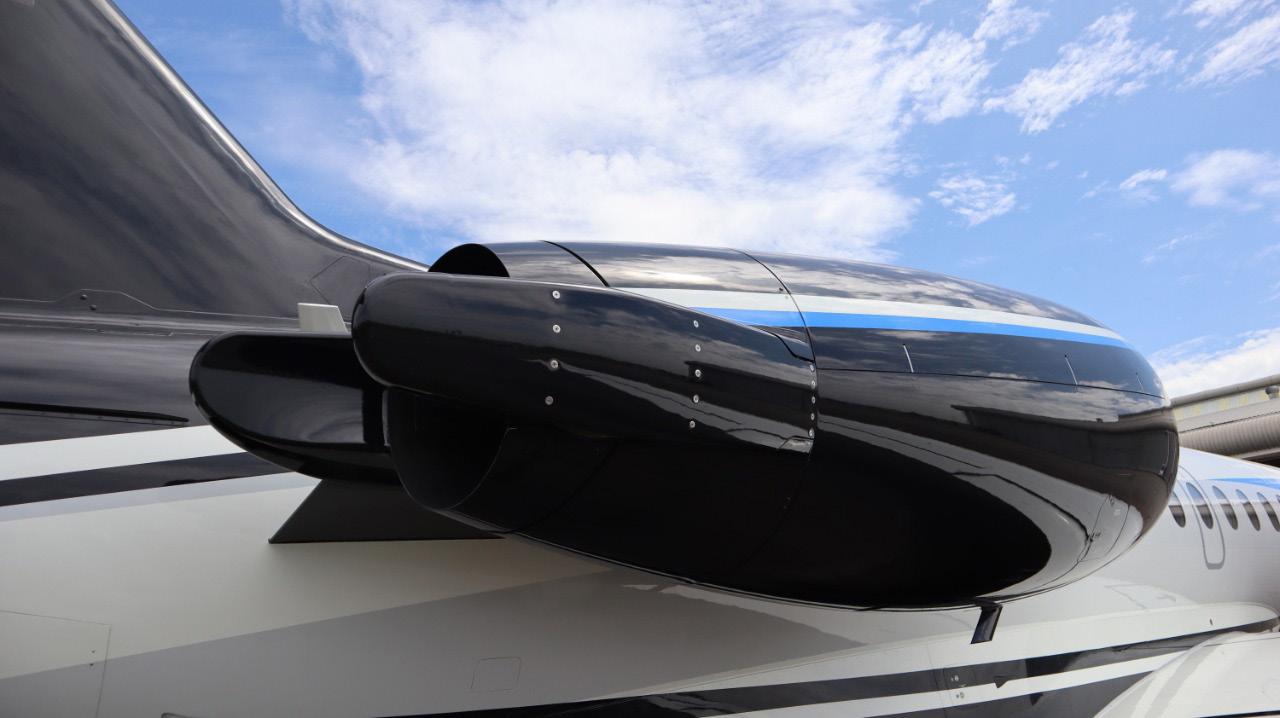







104 October 2023 Tel: +27 (0)10 900 4149 | Mobile: +27 (0)82 547 8379 Info@earefurbishment.com | Francois@earefurbishment.com Hangar 24 (Interior Shop) and Hangar 31 (Paint Shop). Lanseria International Airport, South Africa, Gate 5 North Side. EVENTS CALENDAR SAC NORTH WEST REGIONALS 1 & 2 October Klerksdorp Annie Boon (chunge@mweb.co.za) 082 902 8614 WEST COAST SALDANHA BAY AIRSHOW 1 October Saldanha Bay Clive Coetzee clivecoetzee@sun.ac.za 084 614 1675 SAC ADVANCED WORLD CHAMPIONSHIPS 11 - 23 October USA Annie Boon (chunge@mweb.co.za) 082 902 8614 SAPFA LANDING CHAMPIONSHIPS 29 October Brits & Stellenbosch Rob Jonkers (rob@aerosud.co.za) 082 804 7032
WONDERBOOM AIRPORT – AVIATION
COMPANIES GUIDE

WONDERBOOM AIRPORT 2023
– A NATURAL AIR CONNECTIVITY HUB
Air connectivity is essential for a town, and indeed an entire country’s economic growth. There is strong evidence available from around the world that if a town is not served by an efficient and well-run air transportation system, it will slowly die as investments move elsewhere.

106 October 2023
INTRODUCTION
Wonderboom terminal entrance.
SOUTH AFRICA HAS EXCELLENT examples of how regional cities and towns have experienced an economic boom simply by making themselves an accessible destination for trade and tourism by air.
The fast growing regional centres of George and Hoedspruit are a case in point. Experience from ACSA with regional airports in Kimberly, George, Port Elizabeth, Bloemfontein, and East London attest to the fact that these airports make a significant contribution to the South African economy in the form of job creation, local investment in infrastructure development, and tax revenue, all of which are pivotal to the growth of our gross domestic product (GDP).
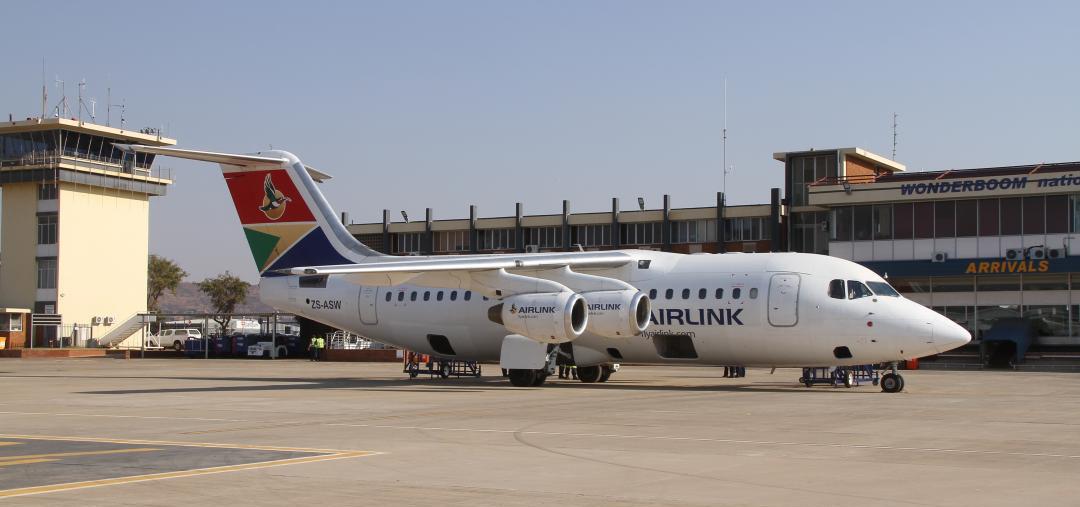
Since local and foreign airlines have begun flying into secondary cities, investment and tourists are flowing in – and boom times have arrived – all thanks to the focused strategic air connectivity initiatives by the Dube Trade Port in Durban and Wesgro in Cape Town. Johannesburg is being increasingly by-passed as a key hub for South Africa as Cape Town and Durban are attracting direct long-haul flights.
Wonderboom National Airport is one such slumbering regional airport. It is the general aviation airport which, in terms of traffic movements, is the busiest in the country and perhaps in the rest of the African continent. ATNS recorded traffic movements reached a peak of 24,000. This record is unprecedented and surprisingly, was achieved against the backdrop of the downgrade of the airport’s license status and the COVID pandemic which ravaged the entire aviation industry, bringing many commercial airports around the world to a standstill.
It therefore does not warrant any expert reasoning to realise the strategic nature of Wonderboom National Airport to the economy of the City of Tshwane Metropolitan Council. The reality however is that the full potential of Wonderboom Airport is not fully realised.
As the owner and operator of Wonderboom Airport, the Tshwane City Council claims it appreciates the strategic importance of the airport and is therefore now pulling out all the stops to restore and enhance Wonderboom National Airport to its rightful place as the key regional airport for the Capital City’s conurbation.
107 October 2023
Wonderboom has had a number of attempts to offer scheduled services.
the busiest airport in the African continent
THE ACSA PARTNERSHIP
The airport is located close to a variety of resources and amenities: bulk freight and transport infrastructure is already in place, meaning that the region has high potential for business growth.
However, it has not been without its challenges. It was widely reported that poor management and the airports inability to appoint a manager were among factors that attributed to the airport’s non-compliance with regulations. The partnership with ACSA is slowly bearing fruit. In August 2023 Wonderboom Airport has once again been given the green light to handle scheduled commercial flights.
In March 2021 a partnership with ACSA was signed which has enabled ACSA to assist the City Council in its renewed effort to make Wonderboom National Airport compliant with
all the civil aviation standards applicable to a Category 7 SACAA licensed commercial airport. The vision is to upgrade the aeronautical infrastructure and turn the airport into one of the most reputable regional airports with aircraft maintenance activities, flight training, charter and scheduled flight services that connect to the other regional centres, both nationally, and within the SADC.

SCHEDULED FLIGHTS
Following a positive audit by the CAA in August 2023, Wonderboom Airport’s aerodrome license has been upgraded from Category 2 to Category 5. This means that the airport complies with safety standards for the handling of scheduled commercial flights.
Wonderboom was downgraded to Category 2 in October 2019 because of maintenance
108 October 2023
INTRODUCTION
An unusually empty Wonderboom Apron.
problems such as uncut grass obscuring signage, debris on runways, leaking water on taxiways and poor security.
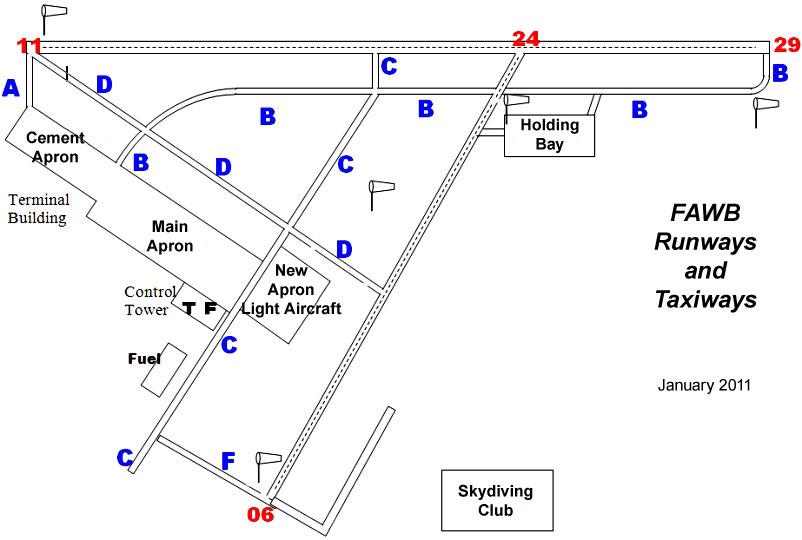
With Category 5 status achieved, Tshwane City Council had been trying to interest airlines to restart scheduled flights into the Airport. Wonderboom previously tried to launch commercial scheduled flights to Cape Town using Airlink airline. However, these were cancelled in May 2018.

a 224% revenue loss during the 2020/21 financial year, partly due to financing the airport through Covid. Brink questioned whether the municipality should continue being the licence holder of the airport with the dire state of the city’s finances.
“If we fail to fix our streetlights, to make sure that public spaces are clean, to fix the potholes, to ensure a reliable supply of water and electricity, can we still afford to operate an airport at a loss?” Brink asked.
FINANCES
Despite the airport’s recent category improvement, the airport’s finances under the Tshwane City Council remain in crisis. Tshwane’s newly elected Democratic Alliance mayor, Councillor Cilliers Brink, questions the City’s ability to continue to own and run the airport.
It does not help that Tshwane has been embroiled in litigation with the private company appointed to manage the airport. Court documents have shown that the City suffered
109 October 2023
The airport provides a dynamic environment for general aviation and in particular flight schools.
j
FAWB Layout.





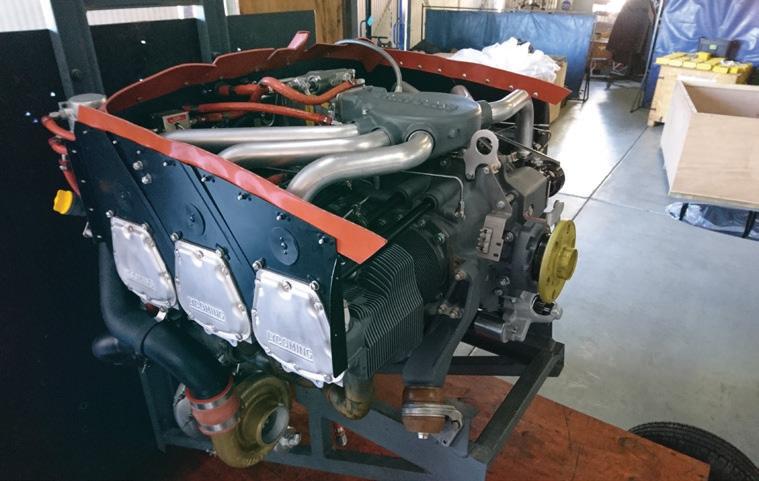
110 October 2023 Overhaul / Shockload / Repair of Continental and Lycoming Aircraft engines Overhaul Engine Components Overhaul and supply of Hartzell / McCauley and Fix pitch Propellers FLIGHT SAFETY THROUGH MAINTENANCE Hangar no 4, Wonderboom Airport, Pretoria PO Box 17699, Pretoria North, 0116 Tel: (012) 543 0948/51, Fax: (012) 543 9447, email: aeroeng@iafrica.com SA Flyer 202 3 | 10 AMO 227
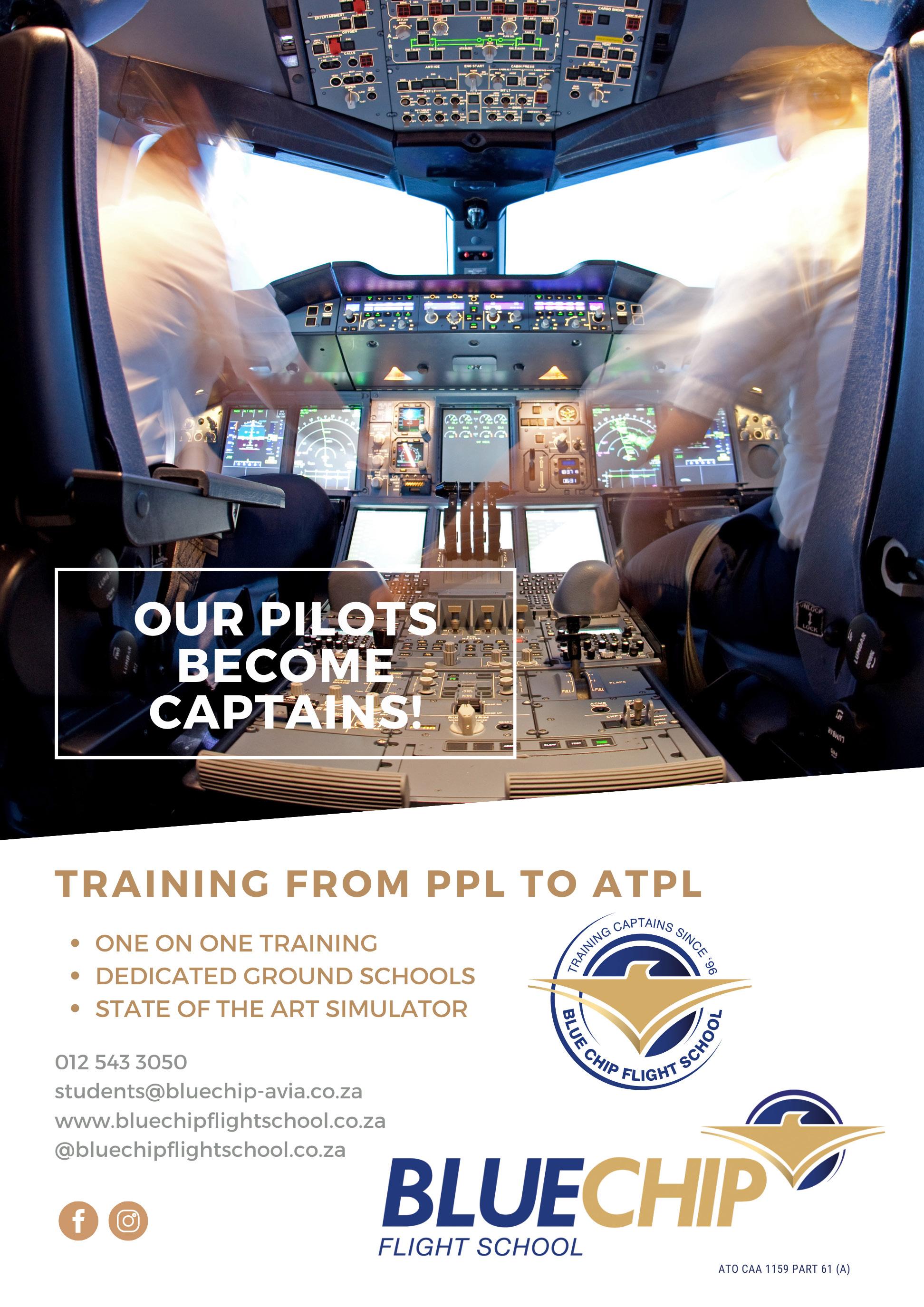
WONDERBOOM’S 86-YEAR HISTORY
Wonderboom National Airport (WNA) has a rich history dating back to World War I, when the first small airstrip was established west of Silverton.
AFTER THE HUGE TECHNOLOGICAL advances in aviation from World War 1, civil aviation began to flourish and remote towns recognised the importance of having their own airfields. These would encourage investment and visitors to the towns.
Pretoria was not about to be left behind, and so Wonderboom Airport had its humble beginnings

on a farm known as Koedoespoort near Silverton. The new airfield became known as the Silverton or Koedoespoort aerodrome.
The airfield soon became famous after Pierre van Ryneveld and Quentin Brand made their first landing on South African soil when they touched down with their two-seater biplane, Voortrekker, en-route to Cape Town on their
112 October 2023
INTRODUCTION
An unusually empty Wonderboom Apron.
London to Cape Town flight. Today that landing spot is a heritage site.
In 1935 the first company to be established at the airport was Placo (Pretoria Light Aircraft Company) owned by Piet and Jan van der Woude. One year later the Pretoria Flying Club was founded.
As the then Pretoria City Council envisaged future expansion, it was decided to acquire 342 hectares of land on the farm, Wonderboom, north of the city.
Placo staff joined the air force, the vintage Bessoneau hangars were strengthened, and six new Bellman hangars, a control tower, water tower, fire station and other buildings were constructed.
first landing on South African soil
The new Wonderboom Airport opened in 1937 but did not attract much development for the first two years, other than Placo and the Pretoria Flying Club.

With the outbreak of World War II the airport became part of the military-industrial complex.
Trainee pilots and the Women’s Auxiliary Air Force members were stationed at the airport and, as a result of the Joint Air Training Scheme between the SAAF and the British Air Mission, a number of other military services – such as navigation, gunnery and an air reconnaissance school – were established at the airfield. Wonderboom became the home of the No 3 Air School, flying Tiger Moth, Hornet Moth and other civilian aircraft types.
Although the air school was disbanded in September 1944, some of the original airport buildings and hangars remain to this day.
113 October 2023
The first tower.
In 1948 control of the airfield was returned to the City Council and Placo and the PFC took over operations. A period of rapid post-war expansion began and, besides being used for air traffic, the airport became a facility for flight training, charter operations, aircraft maintenance, and aircraft and aircraft parts sales.
The grass runways and taxiways were tarred in 1960 and the airfield officially became an airport.
Between 1960 and 1961 a terminal building, new hangars, workshops, a new runway, tarmac lights and other facilities accompanied the newly tarred runway. The idea behind this was for the airport to serve as an Alternate airport capable of handling large aircraft in case the then Jan Smuts International Airport was closed because of weather. However, it was not until 1982 that the first Boeing 737 diverted to Wonderboom.
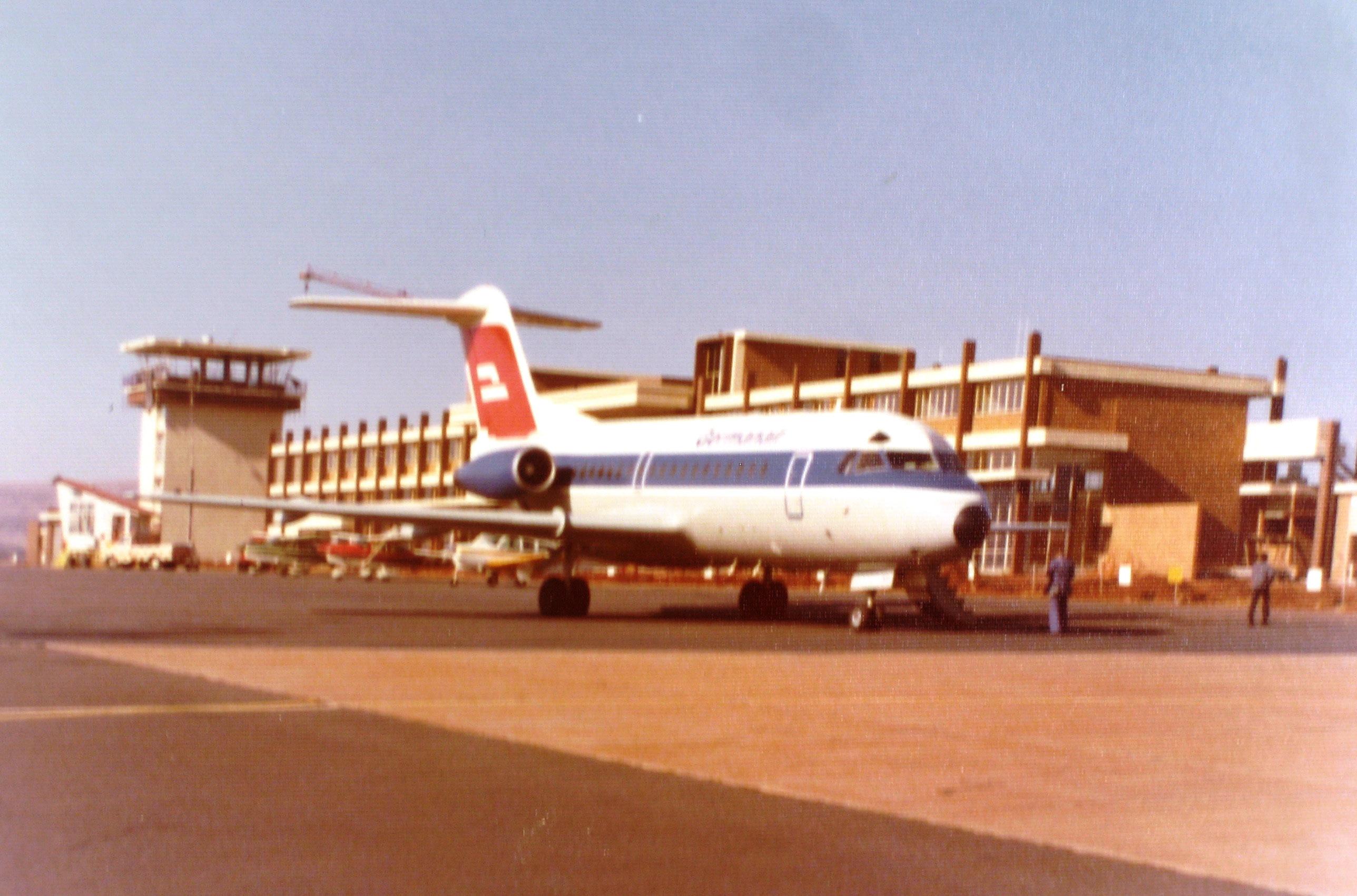
Upgrades to the Airport
Further upgrades came in 1992 and 1993 to increase the runway length to handle larger aircraft. After that a number of upgrades took place that ensured that the airport could compete with others. An application was made in 2012 to grant the airport international status but so far this has still not been forthcoming.
TODAY
Ownership of the airport has changed over the years, eventually ending up with the City of Tshwane, which is now the license holder.
The City Council created a development plan that led to a substantial increase in aircraft movements. In October 2015 the then SA Airlink began a scheduled service between Wonderboom and Cape Town. This did not however prove successful due to the proximity of OR Tambo Airport to Pretoria’s eastern suburbs.
114 October 2023
INTRODUCTION
A Fokker F28 in 1975.
Despite logistical challenges in issues such as fuel supply and grass cutting, the airport has continued to flourish and has become a hub key for flight training, maintenance and charter, as well as a skydiving centre. It is well known for its excellent airshows, particularly under the leadership of Chris Briers, who founded Naturelink. Milestones of the airport
• Over the years the airport has acted as host for a number of unique events:
• The first transatlantic flight in a two-seater aircraft (1955) by two locals.
• First SA parachuting championships (1964).
• South Africa’s first black parachute jumper, Flocks Manceba (1974).
• Tandem parachuting with Miss World, Anneline Kriel (1986).
• First three-man star parachute jump (1968).
• First black South African pilot trained.
• First aircraft diverted from OR Tambo: a Boeing 707.

• First five-star parachute jump record (1970)
• The hosting of three successful AERO-SA Expos for general aviation. j
115 October 2023
Already busy in 1975.
Loutzavia is a leading group in the aviation industry, dedicated to safety and specialising in various aspects of aviation Namely:




Loutzavia Flight Training
Aircraft Sales
Pilot Shop – Wonderboom Airport and Rand Airport
Aircraft Hangarage and Management
Our main area of focus is flight training which is headed by our very own in-house SACAA designated examiner (DFE1) and owner of the Loutzavia group. He has been in aviation and specialising in flight training for 31 Years.
We have one of the largest and diverse fleet of aircraft namely: Cessna 172, Cessna 177RG, Cessna Citation, Piper 160, Piper 161,Piper 181 and Tecnam P2006T We also operate a state of the art Frasca TRU-FLIGHT simulator.
As one of the larger flight schools in South Africa, we are one of the most trusted, respected and established aviation organizations in the country Loutzavia is determined to provide outstanding service to all clients and are dedicated to achieving service with distinction Our passion for flying ensures that the highest quality of attention to detail and safety standards prevail
It is our mission to give you the knowledge to get your wings!
Next OPEN DAY 21 October 2023
-Private Pilots License (PPL) -Commercial Pilots License (CPL) -Airline Transport Pilots License (ATPL) -Multi-Engine Rating -Night Rating -Restricted Radio License -General Radio License Main Terminal, Wonderboom National Airport, Pretoria, South Africa BECOME A PILOT Tel: +27 (0) 12 567 6775 www.loutzavia.com e-mail: info@loutzavia.co.za




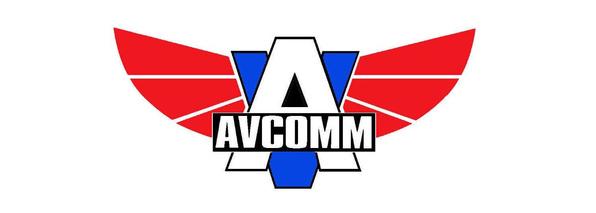




117 October 2023 PILOT SHOP Wonderboom Airport Branch Rand Airport Branch www.pilotsnplanes.co.za TEL: 012 567 6775 EMAIL: pilotshop@pilotsnplanes co za Physical address: Wonderboom Airport, Main Terminal Building, Ground Floor TEL: 011 824 3339 EMAIL: RAND@pilotsnplanes.co.za Physical address: Outside Entrance, Main Terminal Building, Rand Airport


EAGLE AIR PILOT SHOP
At Eagle Air, we have always held a steadfast commitment to excellence in aviation training.

We are thrilled to extend that commitment beyond the cockpit with our Eagle Air Pilot Shop.
Step into a world where aviation enthusiasts and pilot students alike can find everything, they need to soar higher.
For aspiring pilots, we offer a carefully curated selection of essential gear.
But our shop isn't limited to the necessities of flight training.
Flight Fanatics will be delighted to explore our collection of aviationinspired jewellery and a wide range of accessories that pay homage to the world of aviation.
Whether you're searching for a meaningful gift or want to indulge your passion for flying, our shop has something special for you.
In addition, we are proud to also offer personalized sublimation printing services, allowing you to create customized aviation-themed items that are uniquely yours.
We are dedicated to upholding the same standard of excellence that defines our flight school
Come visit us and experience the thrill of aviation shopping like never before.
119 October 2023
BLUE CHIP FLIGHT SCHOOL

BLUE CHIP FLIGHT SCHOOL provides flight training from the Private Pilot’s Licence through to Airline Transport Pilot’s Licence. The school has an accredited in-house examination centre, a superb fleet of aircraft that caters for all training needs. We boast with a state-of-theart simulator, designed and built to meet the SACAA FNPT II requirements, we also have a web based, paperless electronic booking, authorisation sheet and student filing system.
Why do we think Blue Chip Flight School is different from any other flying school?

Blue Chip Flight School has been around for 27 years awarding people wings and the freedom to forge exciting careers in aviation. We strive to recognise and nourish the passion within each student pilot and we consciously develop a disciplined, but harmonious relationship between instructor and student. We have dedicated ourselves in providing the best quality training,
never compromising on safety. We seek to optimise value through efficient operation and by instilling a culture of professionalism and on time performance throughout our organisation.
Since January 2023 in partnership with Stadio Higher Education and Henley Aeronautical Institute of Learning, you can now at Blue Chip Flight School simultaneously complete your flight training and an accredited tertiary qualification, if you have already obtained pilot licences, your flight qualifications can now count towards an academic qualification.
To receive more information about the Aviation Management Programmes, or our flight training visit our website or contact us.
Main Terminal Building, Wonderboom Airport
012 543 3050
marketing@bluechip-avia.co.za
www.bluechipflightschool.co.za

120 October 2023
Companies
j
BUMPPPFFF:
When the tanks unexpectly filled with air this Ural Airlines A320 was successfully landed in a field
An amazing formation of ww2 pistons and the Me262 jet.
Early Spitfire Mk1s had huge fixedpitch wooden propellers.
PIONEERING SUSTAINABLE AEROSPACE FOR SAFE AND UNITED WORLD
Through

airbus.com
an unwavering commitment to decarbonisation, Airbus is pioneering sustainable aerospace for a safe and united world. Discover more about how our technological developments are shaping a brighter future for generations to come.

Skyhorse Aviation grew out of NRG and is based at Wonderboom Airport.

SKYHORSE AVIATION
– A LESSON IN RISK MANAGEMENT
PRETORIA’S WONDERBOOM AIRPORT
is a centre for helicopter excellence and this is exemplified by Skyhorse Aviation. This is a business that provides world-class helicopter services in support of mining and industry across Africa and the Middle East.

SAFETY AND EXPERIENCE
Skyhorse’s dedicated and highly qualified team of helicopter professionals have flown over
35,000 hours with an excellent safety record. The company has over 40 years of collective experience, supplying aircraft to mining houses, drilling and construction projects, geophysical companies and agencies across more than 30 countries throughout Africa, Middle East and Australia.
The company specialises in providing aircraft support using pilots who are highly experienced in African conditions and field operations.
124 October 2023
COMPANIES
One of the quiet centres of competence in the aviation industry is Skyhorse Aviation based at Wonderboom Airport.
Text & Images: Grant Duncan Smith (Subiaco Photography)
The busy but immaculate Skyhorse hangar at Wonderboom.
Confirming this commitment to quality and safety, Skyhorse is a Basic Aviation Risk Standard (BARS) registered aircraft operator. Fleet
The Skyhorse fleet currently consists of ten new generation AS350 (now H125) helicopters, plus two Pilatus PC-6 and one Cessna F406 twin turboprop fixed-wing aircraft. All the aircraft are either owned by Skyhorse or are on permanent lease.
Skyhorse is a customer centric privately owned company, and thus is prepared to adapt operations in a safe and efficient manner, to fulfil clients’ requirements. All aircraft are fitted with state-of-theart satellite tracking systems and Iridium telephones. Appropriate survival kits, emergency locator devices, and comprehensive first aid kits are standard for all operations.
Safety is seen as an integral part of the company’s ethos and thus Skyhorse Aviation adheres to a stringent set of safety standards aimed at reducing risk in all areas of operation.
Maintenance
Helicopter operations are by nature maintenance intensive. All Skyhorse maintenance is handled by New Resolution Geophysics (NRG), a South African maintenance organisation that solely maintains the Skyhorse Aviation fleet.
The Just Safety Culture
Skyhorse has adopted the industry standard ‘just safety culture’, where hazard and occurrence reporting is encouraged and documented to predict future trends. These trends and other factors are used for comprehensive research undertaken to generate risk assessments prior to any project commencement.
The Risk Assessment used is based upon the standard Helicopter Airborne Seismic Risk Assessment provided by the International Airborne Geophysics Association.
A Chat to the CEO
Grant Duncan Smith (GDS) chatted to Ryan Louw, the CEO and Chief Pilot at the base at Wonderboom Airport about their operations and a safety culture.
GDS: Tell us about how Skyhorse began operations.
Ryan Louw (RL): New Resolution Geophysics (NRG) was founded in 2005 specifically to provide high resolution magnetic radiometric gravity and electromagnetic geophysical surveys for the exploration, mining and petroleum industries, as well as regional mapping organisations.

125 October 2023
Ryan Louw is the CEO of Skyhorse - and a very experienced helicopter pilot.
“Today the company operates ten Airbus H125’s from the earlier B models to the latest model B3e model. Historically we have focused on working in Africa, Middle East and Australia. Recently, we have been going back to Greenland on a regular basis for exploration activities. The locations we work in are by their nature are often remote and isolated. The type of helicopter utilised is essential, with helicopter performance, maintenance and reliability being critical for a successful mission and happy client.”
life limits on various components down to the earlier models. Thus for example, it is a big advantage when you replace a tail rotor at 3,500 hours instead of 2,500 hours. So one of the advantages of sticking with the H125, is that the continuous modernisation of the airframe is a big plus for us.
GDS: Why have you chosen the Airbus H125 Squirrel for your helicopter missions?
RL: Thete is a broad range of variants of the Squirrel. The B2 suits magnetic surveys perfectly as the endurance and relatively low fuel burn for that size platform, and reliability in the field makes it perfect for going into remote African flying magnetic survey or radiometric survey. The B3e, with its external load capability, is perfect for the external load work that we do, in particular the electromagnetic surveys that NRG is a world leader in.
Being able to lift 500 kilograms in a helicopter with full tanks and in a dusty environment, is what we rely on. With the B3, there’s not much I think that compares in terms of these capabilities in the hot and high environment.
In terms of reliability and maintaining the aircraft.
The Airbus H125 is extremely reliable and very easy to maintain in the field, which is a requirement for the projects we undertake.
The service life limit on parts is a big factor that allows us to operate as long as we do. The H125 series has been steadily modernised since the 1970s and this has created extended
GDS: Can you tell us about a typical mission where the Airbus H125 was critical for the mission’s success?
RL: The B3 is world renowned for its highaltitude capabilities. We would not have been able to carry out surveys if it were not for the B3 in mountainous projects where we have flown radiometric and magnetic surveys, up to 16,500ft with 400 kilograms of survey equipment attached to the helicopter. That wouldn’t be possible with any other comparable platform to fly out of ground effect, 80 metres above ground level over a mountain at that altitude.
One project that stands out for us is Eastern Greenland where we based our crew and an H125 configured for aerial geophysics on an exploration vessel. We flew about 200 hours of survey flights.
I must add that the Airbus H125 is ideal for what we do because of its reliability and with service scheduling at 150 hours between MPIs. This is perfect for the type of work we do.
When it comes to flying aerial geophysics, we think the Starflex rotor head system makes a big difference for us. Being able to fly as low as we need to and follow the terrain as accurately as we do, probably would not be possible with other types of rotor heads.
126 October 2023
extremely reliable and very easy to maintain j
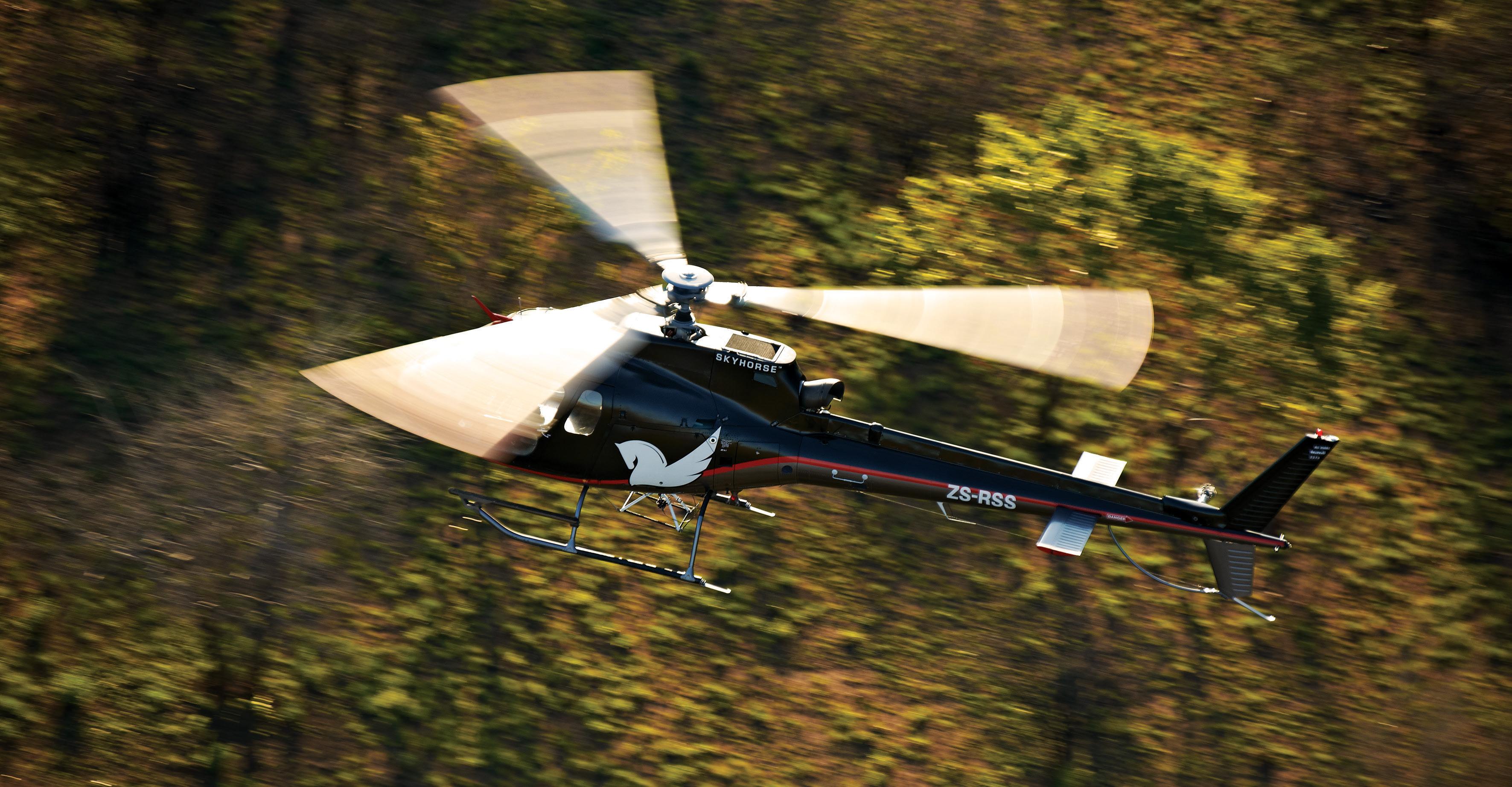


127 October 2023
H2FLY FIRST PILOTED FLIGHT
THE H2FLY TEAM has completed four flights powered by liquid hydrogen as part of its flight test campaign, including one flight that lasted for over three hours.
The flights were completed with H2FLY’s piloted HY4 demonstrator aircraft, fitted with a hydrogen-electric fuel cell propulsion system and cryogenically stored liquid hydrogen that powered the aircraft.
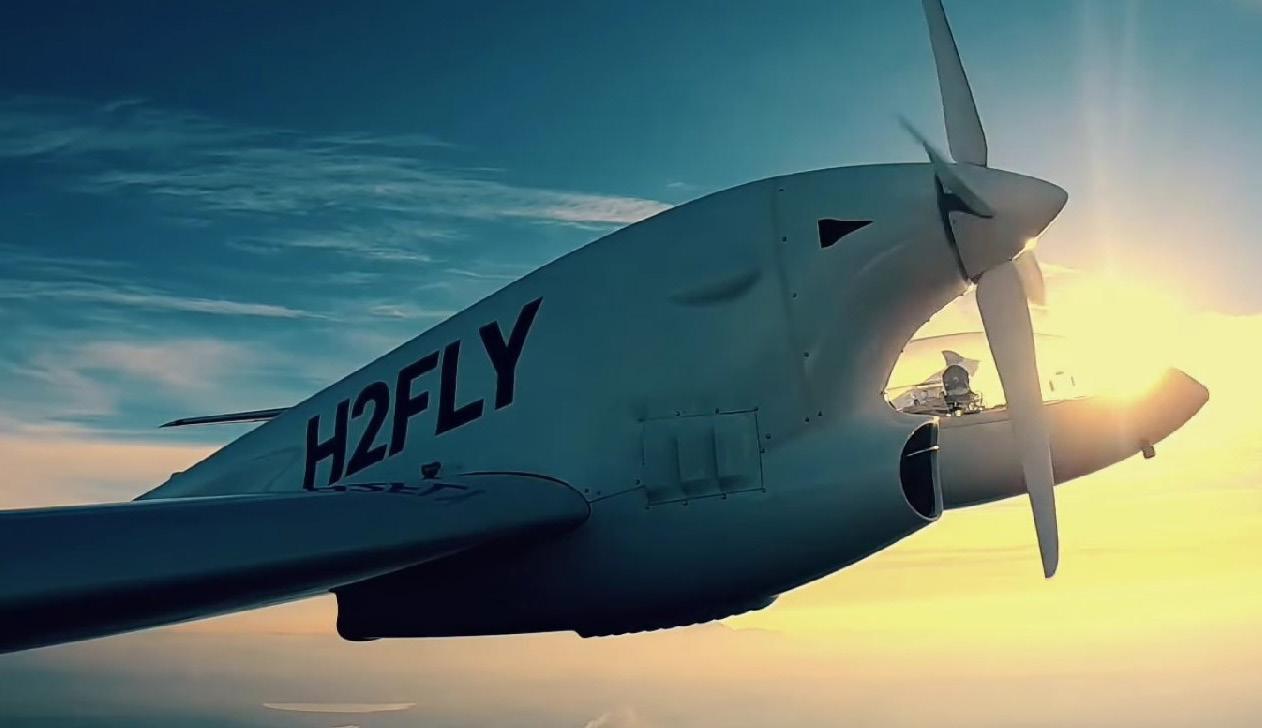
Results of the test flights indicate that using liquid hydrogen in place of gaseous hydrogen will double the maximum range of the HY4 aircraft from 750 km to 1,500 km, marking a critical step towards the delivery of emissionsfree, medium- and long-haul commercial flights.
The successful campaign marks a significant milestone for H2FLY, reflecting the extensive insights from the company’s research efforts. Compared with pressurized gaseous hydrogen storage (GH2), the use of liquified, cryogenic hydrogen (LH2) enables significantly lower tank weights and
volume, therefore leading to increased aircraft range and useful payload.
With the completion of the flight testing in project HEAVEN, H2FLY will focus on the path to commercialization. In June, H2FLY announced the development of its new H2F-175 fuel cell systems which will be capable of providing their full power range in flight altitudes of up to 27,000 ft, marking an important step on the path from lower altitude viability flight demonstrations to real-world commercial aircraft applications.
128 October 2023
NEWS
j
The Pipistrel H2Fly in flight.
H2FLY, the Stuttgart, Germany-based developer of hydrogen-electric powertrain systems for aircraft, has successfully completed the world’s first piloted flight of an electric aircraft powered by liquid hydrogen.
FlightCm

 John Bassi – takes on taildraggers!
John Bassi – takes on taildraggers!
Edition 177 | October 2023
Conservation
Afr ican Commercial Aviation
Light Aircraft in Wildlife
DRC war rescue
Cover: John Bassi Hugh Pryor considers 9-11
OCTOBER 2023
EDITION 177
04 08
Publisher Flyer and Aviation Publications cc
Managing Editor Guy Leitch guy@flightcommag.com
Advertising Sales Wayne Wilson wayne@saflyermag.co.za
Layout & Design Patrick Tillman: Imagenuity cc
ADMIN:
+27 (0)83 607 2335
TRAFFIC:
+27 (0)81 039 0595
ACCOUNTS:
+27 (0)15 793 0708
Bush Pilot - Hugh Pryor
News - Aeroflot instructs pilots to turn brakes off

Pilots - Laura McDermid
14 17 18 23 24 27 28 29 30 32
John Bassi - Taming Taildraggers
AME Directory
Jeffrey Kempson - Dakota Gamblers Weekend
News - The Ural A320 forced landing
Jacqueline Mwende - Mission Flying
News - P&W’s GTF – a U$3 billion recall
Alpi Aviation SA: Flight School Directory


Merchant West Charter Directory
Skysource AMO Listing
Backpage Directory
TABLE OF CONTENTS
© FlightCom 2023. All rights reserved worldwide. No part of this publication may be reproduced, stored in a retrieval system, or transmitted by any means, electronically, mechanically, photocopied, recorded or otherwise without the express permission of the copyright holders.
10
A NOTE FROM THE EDITOR:
BUT THIS IS FAR FROM THE WHOLE picture. IATA has many notable achievements, not just to airline regulation, but to the entire industry.
Notable is the new Billing and Settlement Plan (BSP) (i.e. airline ticket sales) and the Carbon Net Zero by 2050 goal. Both of these initiatives are quietly but significantly improving the airline industry .
But the biggest accomplishment of IATA has been to do the seemingly impossible – to transform the African airline industry from one of the most dangerous in the world to one of the safest. It accomplished this by creating the IATA Operational Safety Audit (IOSA), which is now a condition of membership in IATA.
The proof is evident in the numbers. In Africa, the accident rate is 1.18 for IOSA registered carriers compared to a rate of 9.79 for non-IOSA carriers. Thus IOSA registered airlines in Africa are almost 8 times safer than non-IOSA airlines.
Around the world, more than 100 non-IATA member airlines also see the value of IOSA certification. Since 2005, the all-accident rate for airlines on the IOSA registry is 1.40 per million sectors, compared with 3.49 per million sectors for non-IOSA airlines. In 2022, IOSA registered carriers outperformed those not on the registry by a factor of four (0.70 accidents per million sectors vs. 2.82 accidents per million sectors).
IOSA was launched in September 2003 with Qatar Airways as the first airline to be audited and join the IOSA Registry. IOSA has been a requirement for IATA membership since 2006. It is also a condition of membership in the three global airline alliances, as well as a number of regional airline associations.
IOSA was developed in cooperation with aviation regulatory bodies, including Australia’s Civil Aviation Safety Authority (CASA), the European Union Aviation Safety Agency (EASA), US Federal Aviation Administration (FAA) and Transport Canada. IOSA is now used by regulators in numerous countries to complement their safety regulatory oversight programs, and as the primary means to verify operational safety for many airline codeshare arrangements.
Last year, IATA began evolving IOSA to a risk-based model under which audits are tailored to the operator’s profile and focus on high-risk areas. The new approach also introduces a maturity assessment of the airline’s safety-critical systems and programs.
So inherently safe airlines will be less audited than problem ones. This follows the same principle as the IACO and FAA audits that the SACAA is wedded to as a measure of its success. Everything works better when you have grown-up running complex industries, rather than dazed and confused bureaucrats who have been promoted to one level above their level of competence.
IOSA airlines in Africa are almost 8 times safer
The International Air Transport Association (IATA) is often perceived to be a barking dog lobby group, pushing its member airlines interests against obdurate governments.
SEPTEMBER 11: FOOD FOR THOUGHT
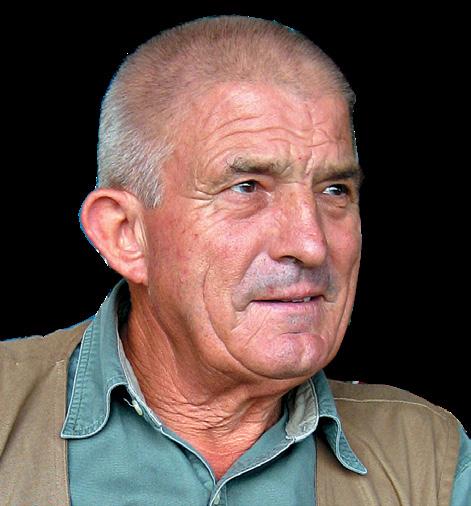
OUR EFFORTS TO RATIONALISE
the concept of minds so completely perverted as to have been able to commit acts of such total abomination caused circuit breakers to pop in all our psyches.
The events were so inhumanly evil that our initial reactions were disbelief, followed closely by denial. “This cannot be happening. Nobody in his right mind would fly an aeroplane full of passengers into the World Trade Centre. I mean, the crew wouldn’t let it happen would they?”
And then the second one went in.
effects never ever seen before on canvas, stage or screen. It stirs all the emotions. There are scenes of terror, hysteria, pathos, tragedy, heroism, mystery and, yes, even humour.
It remains to be seen whether there is any hope of redemption in the future. Meanwhile, the best we can hope to do is to take measures to prevent such horrors re-occurring, and the cockpit is one of the places where we will have to start.
lethal weapons
Even Tom Clancy’s imagination could not have conceived a plot of such enormity. To be frank, nobody would have believed it. The book would not have sold. Clancy devotees world-wide would have turned away from their icon, in the belief that he had run out of ideas and resorted to implausible sensationalism in order to satisfy the cravings of his fans.
The Twin Towers massacre has been described as the greatest work of art ever produced. It contains visual
Untried methods will have to be tested to counter the threat posed by this new breed of hijackers, for whom suicide is an ambition. These measures will have to include the use of potentially life-threatening techniques to prevent the aircraft becoming a weapon in the hands of the hijackers. These may include the use of lethal weapons, anaesthetic gasses, the depressurisation of the hull, even suicide, as was thought to have been used in the Pennsylvania aircraft, N591UA, by those heroic passengers...Which reminds me of something which happened to me some years ago, in Mozambique. It sounds like a complete ‘non sequitur’, but I think you will get the point as you read on.
4 FlightCom: October 2023
BUSH PILOT HUGH PRYOR
September the 11th, 2001. None of us will ever forget the deep dark horror which penetrated all of our souls as we watched, with an intimacy only made possible by television, ordinary people going through an experience which rivalled the worst brutalities of all-out war.
may include the use of

I was involved in an operation with a large international aid organization, to bring relief to the war-ravaged population of Mozambique. Our remit was to carry food, medical supplies and personnel to various outlying centres, most of which had been cut off from the world for half a generation.
Our mode of transport was the legendary De Havilland DHC-6 Twin Otter, a twenty-passenger turbo prop which lands in places which would very often make a 4 by 4 think twice. Our base was the once-beautiful Indian Ocean port of Beira, which had been reduced to penury by mindless communism and its ensuing war.
The organization for which I was working, relied (and still does so to this day,) on its reputation for total neutrality and transparency to guarantee its safety in the theatres in which it operated. Normally speaking, if there’s no war, the Organization is not there, so by definition, if you are flying for that bunch, you will tend to be putting yourself in harm’s way to a certain extent. You will also be putting your passengers and cargo in the same position.
Obviously, there are ways to limit the risks and experience has drawn up its own manuals of operating procedures, each one applicable to each different environment.
A lot depends on trust and intelligence information. If, for example a rebel commander says it is safe to transit over a certain area, you have to trust him, although we had one company aircraft shot down one hundred miles north east of Quelimane in Mozambique, after one such guarantee. All on board survived the crash uninjured, which says a lot for the skill of the pilot, the integrity of Mr. Cessna’s designers and, of course, the bravery of the Mozambiquan helicopter crew who flew the extremely hazardous rescue mission.
You also have to trust your passengers, and this very nearly led to a situation which, although hilarious to look back on, almost caused me not to be writing this story.
Henrietta, known as Harry to her friends, was a bigboned, brash, buxom, blonde lady from the Low
Countries. She was a pharmacist and had been sent out to Mozambique by the Dutch, at the request of our branch of the Organization.
Socially, Harry was the life and soul of the party. Her sheer size and the impressive tone of her laugh made her the focus of attention and she appeared to enjoy being centre-stage. Professionally she had an enviable reputation for getting things done. You didn’t get in Harry’s way if she was on a mission. It wasn’t just her voice that could be intimidating when she was provoked.
One day as I was passing the Medical Administrator’s office, a voice hailed me from its shady interior. “Hugh...Got a minute?”
“Of course Sean. How can I be of assistance?” The Medical Administrator, Dr Sean, was a little whitehaired gem of a man from Tullamore, which is also the home of one of the more distinguished Irish Whiskeys. He had an easy smile and a continuous twinkle in his eye.
“It’s Harry again, Hugh. I found out she intends to send a consignment of Chloroform up to Nampula hospital with you on Thursday. You’re not supposed to carry that stuff, are you?”
“Not with passengers, Sean, no.”
Well Harry is very determined to get the vials delivered, so I suppose we’ll just have to work something out for her.”
Harry was ‘very determined’ with me later that evening as well, to the point that we ran out of polite things to say to each other, once she had established that I was sticking to the book on this one. In fact, she stormed off to bed at seven-thirty, after failing to convince me that I was being stupid about the chloroform. And that was very early indeed for Harry.
Tuesday and Wednesday were busy days for Essa, my co-pilot, from Finland, and myself, involving early morning starts and late evening arrivals. So our social life was curtailed to the point that Harry and I had no
6 FlightCom: October 2023
A lot depends on trust and intelligence
opportunity to patch up our differences. In fact, so busy had we been, that I forgot what had caused them in the first place.
So, on Thursday morning, I was only aware that Harry was treating me with a certain amount of reserve when she approached the aircraft for the long flight up to Nampula.
After getting everybody boarded, briefed and buckled up, we started engines, completed our systems checks and took off for the first leg to Quelimane, which is a small port up the coast from our base in Beira. We had a smooth flight below the broken layer of fair weather cumulo-stratus cloud, passing over large areas of countryside which had been productively cultivated before the civil war had removed honest labourers from the landscape.
At Quelimane’s pretty little red-roofed airport, we topped off the fuel tanks and took on another couple of passengers for the second leg to Nampula. It was Essa’s turn to fly and his competence allowed me to relax and watch in confidence.
By this time, the heat was pushing thermals of hot wet air upward off the sea, feeding the cumulus clouds until they grew into towering bubbling cauliflowers of vapour which forced us up and up amongst their dancing columns. At nine thousand five hundred feet we were above them, but I could see that there were several individual cells in the distance ahead, which thrust themselves above their neighbours, and these were the arrogant ones which would turn violent later as we reached them.
I leaned forward and turned the radar from ‘standby’ to ‘normal’, switching the range to eighty miles. Already some green clumps of radar returns on the screen indicated the presence of rain falling out of the bigger clouds up ahead. What had started the day as friendly, puffy lumps of cotton wool, were now developing into obstacles which we would have to circumnavigate in order to reach our destination.
We would need more altitude too, because even the
more innocent clouds were now following the bad influence of their haughty neighbours. We started to climb. Now the big boys were growing long grey tendrils of rain, falling out of the rolling folds of appropriately named Cumulus Mamatus which protruded like great breasts from the lowest levels of the build-ups. Even the innocents were developing dark grey bases, as if to declare their solidarity with the ring-leaders.
It was going to be a rough trip from here on in, and we still had over an hour to go before reaching the comforts of Nampula, which was still reporting cloudless skies and light winds. I switched on the seat-belt signs and asked the passengers to check that their buckles were properly fastened. I mentioned that we were going to be thrown around a bit and that we might have to climb to higher altitudes to get over the worst of the lumps. I told them that since we were unpressurised there could be some people who would feel uncomfortable as we climbed and they should tell us, so that we could descend quickly into the more breathable, though much more uncomfortable, levels below us.
We were just reaching eleven thousand five hundred feet when we went through a particularly vicious down-draught, as we passed under the overhanging anvil of one of the original bad boys we had spotted earlier on the radar.
As we dropped, an explosion of hail rattled against the windscreen. Nothing serious, you understand, but enough, with the turbulence, to grab the undivided attention of our guests in the back. I turned to look into the cabin and jokingly blamed everything on Essa, who responded in kind by laughing and blaming me. Our little pantomime appeared to have alleviated the situation enough to allow a few nervous grins to flit across the faces of our passengers and then Essa turned and tapped my arm. A serious expression had suddenly driven away any vestige of humour.
“Can you smell something?”
“Yes, I certainly can!” I replied. “Get the cockpit doors
FlightCom: October 2023 7
an explosion of hail rattled against the windscreen
shut! Fast! I should have known Harry would try this! Get your window open and check the cabin air vents are fully open!”
I unlocked and opened the window my side. and we both donned our oxygen masks. What we could smell was the unmistakable aroma of Chloroform.
Needless to say, our colleagues in the back missed the last hour and a quarter of moderate to severe turbulence, lightening, thunder, lashing rain and the odd return bout with the hail. They were all fast asleep. They even missed Essa’s landing at Nampula. Actually, it was such a greaser that they might have missed it even if he had not had the assistance of the Chloroform.
Anyway, when everyone finally came round from the anaesthetic, after we had got back to Mother Earth, I raced round and opened the airstair door to let everybody out and to save Barf Bags. It was discovered that Harry had ‘inadvertently’ packed two boxes of the phials of Chloroform in her hand baggage and, whether due to the turbulence or the altitude, they had popped when we climbed over the saddle between the anvil and its enormous brother.
Harry was totally unrepentant and I think that’s what finally decided the ‘powers that be’ that she would be more use (not to say ‘safe’) back in her own country.
Which leads me back to where we started.
If, during a flight, you suddenly find yourself confronted by a bunch of suicidal maniacs who are trying to break their way into your cockpit with intent, just pray that you’ve got Harry down the back and that she didn’t forget to bring the Chloroform this time! ------oooOoo------
Meanwhile, we have to potter on as best we can. The world can no longer function without aeroplanes. This is a fact of life. But for everyone who saw the Twin Towers disappear from the Manhattan skyline that day,
the aviation industry has lost an awful lot of its hightech glitter.
Obviously the first line of defence is not to let the beasts and their weapons onto the ‘planes in the first place and there is considerable evidence to show that if the American Domestic Flight security had been up to the standard of the security on their International flights, then the 11th of September 2001 might not have been engraved so deeply on the puplic memory.
Security, however can only go so far. A plastic knife sharp enough to cut through a steak is certainly sharp enough to cut through a jugular. A cockpit door built by the designers of Fort Knox can still be opened by blackmail or subterfuge. Even if you fill half the ‘Y’ class seats with sky marshals, one has to ask how many police officers in the United States are killed every year by their own weapons. The answer to that is ‘far too many’.
The problem is that, if you are dealing with a person who considers it a lifetime’s ambition to commit suicide and to take as many of his fellow humans as possible to Paradise with him, only radical solutions of frightening singleness of mind will suffice. Once an aeroplane becomes a weapon in the hands of such a person, the potential for destruction is almost unlimited.
The Twin Towers removed any lingering doubts we might have harboured about that. The truth of the matter is that the beasts must be stopped at all costs, even if, as in the case of the Pennsylvania heroes, it means sacrificing your own life in order to save the lives of thousands of others.
Cockpit philosophy has made a complete one-eighty since the 11th of September. Now, instead of advising total compliance with the demands of the hijackers, the aviation authorities urge aircrews to use any means available to kill them. Not ‘disable’ you’ll notice...Kill.
Food for thought.
8 FlightCom: October 2023
the potential for destruction is almost unlimited
AEROFLOT INSTRUCTS PILOTS TO TURN BRAKES OFF

TO COPE WITH THE ISSUE OF REPLACING
worn-out brakes on Airbus and Boeing aircraft, Aeroflot has instructed its pilots to turn them off, as reported by Moscow Times.
Following Russia’s invasion of Ukraine, sanctions imposed by Western countries have not only closed the airspaces of the United States, United Kingdom and EU for Russian aircraft but have also prevented aviation companies from servicing the country’s aircraft or providing spare parts. As a result, Aeroflot, whose fleet mostly consists of Western-made Airbus and Boeing jets, cannot directly access parts and spares from the original equipment manufacturers (OEMs). According to ch-aviation.com data, the airline’s fleet
comprises 295 aircraft, of which 217 (approximately 74%) are Airbus or Boeing.
To circumvent these restrictions, Aeroflot has reportedly begun sending its aircraft to Iran for maintenance. Iran, having been under heavy sanctions for several decades, is believed to have developed extensive knowledge in repairing aircraft under such circumstances. Previous media reports have indicated a deteriorating safety situation at Aeroflot. For instance, one Russian investigative news publication claimed that the airline had instructed its staff to stop logging malfunctions on flights to prevent aircraft from being grounded, despite the necessity of fixing the issues.
FlightCom: October 2023 9
NEWS
An Aeroflot A320 comes in to land with questionable brakes.
As Western sanctions on Russia bite, Aeroflot is struggling to keeps its airliners supplied with key parts and components.
LAURA MCDERMID
IRIS - HER EARLY YEARS. PART 6 The Nurse’s Congo Ordeal
McDermid continues her stories about Iris McCallum in Rwanda.
IN MY CASE THE YEAR WAS 1994, my ‘Rwanda’ year. A year defined by extreme highs and lows. That year revealed the full spectrum of what human beings are capable of.
The levels of depravity and extreme cruelty that are woven into our DNA came as the biggest shock. On the one hand, the things that one human being could do to another in cold blood never ceased to appal and sadden me. On the other hand, the lengths that some people would go to in order to help a complete stranger in need also never ceased to amaze me.
worst aspects of humanity are irrevocably entwined with the best. And so these contradictions lived in me, side by side.
I was freelancing for Aslam Khan who owned Aircraft Leasing Services (ALS) and he had contracts with UNICEF and the International Committee of the Red Cross (ICRC).
clouds stacking up like giant fists
I had flown into Kigali, the capital of Rwanda, mere days after the senseless killings began in April 1994. On 13 October I flew the President of Ireland and her entourage from Wilson in Nairobi to Kigali.
Don’t misunderstand me; I could never get used to seeing the body of a small child hacked to pieces by a lunatic wielding a panga. But I came to accept that the
I had hoped to get some time off at the end of the year, however, December transpired to be a very busy month
10 FlightCom: October 2023
There are certain years in a person’s life that remain emblazoned on one’s memory forever. In fact, I’d go as far as to say that they are imprinted on one’s soul. Those years define us and shape who we are.
Laura
with me logging a total of 120 hours. I was bouncing between three aircraft, the Twin Otter 5Y-JHZ and the two King Air 200s, 5Y-BJM and BKA, flying between Sudan for UNICEF and Rwanda and Congo for the ICRC.
On 30 December I began the day flying 5Y-BJM, code name Red X 435t, from Wilson to Lokichogio (a town in the Turkana District in northwest Kenya), to drop off a fresh recruit ICRC medical staff and then back to Wilson.
After refuelling, I flew via Kigali to Ngara, a district in Tanzania, where one of the biggest refugee camps had been established to accommodate the masses who had fled Rwanda. I was to collect four Irish nurses who were being driven to Ngara from the Congo where they had been stationed.
During and following the genocide in Rwanda, nearly two million Hutu refugees crossed the Congolese border, mostly settling in refugee camps in the North Kivu and South Kivu provinces.

I’d had very few days leave this year and I could appreciate how exhausted these poor ladies must be. I was to fly them to Wilson where they would catch a flight to Jomo Kenyatta International for a flight to Ireland. I was given strict instructions to be airborne before dark, as the storms over Lake Victoria could be violent, especially at night.
The massive lake which stretches 70,000 square kilometres, is the world’s second-largest freshwater body and the biggest of its kind in Africa, as well as the chief reservoir of the Nile.
The lake, which lies on the equator, has a distinct effect on the weather. It generates a huge amount of Convective Available Potential Energy (CAPE) which is characterized by the development of cumulus and cumulonimbus clouds with attendant severe weather hazards.
I landed on Runway 24 at Ngara and taxied to the spot where I was meant to meet the UN driver. But there was no one there. I glanced at my watch, which showed 16h30, two hours before sunset.
FlightCom: October 2023 11
Ngara Refugee Camp Tanzania.
dedication to making the world a better place
I made a call on my HF radio and was told that my passengers were still on their way, but were held up at the Congolese border. There was nothing to do but wait. I watched the sky in the west transform from a dark blue to a brilliant, fiery orange.
The ubiquitous clouds over the lake were stacking up like giant fists. Jagged tendrils of light flickered and branched out in unpredictable patterns, creating a pyrotechnic spectacle.
Just as my concern was reaching its peak, the distant rumble of a car broke the tension. I let out a deep sigh of relief. The Land Rover rolled to a halt and the four nurses stepped out. Even from a distance, I could see that their bodies were stiff with tension.
As the driver approached me, his face filled with relief. I took his outstretched hand, noticing the stress etched on his face.
‘What happened my friend? I was expecting you several hours ago.’ I asked in Kiswahili.
Aziz recounted the harrowing ordeal that unfolded after their passports were confiscated by a border official who ‘had eyes like a snake’. They were forcibly detained and subjected to hours of interrogation in a windowless prefab room.
The Congolese authorities were suspicious, unable to fathom why four single white women would find themselves in the midst of war-torn Africa.
Aziz, steadfast and resolute, maintained his composure, never straying from his story in his efforts to prove that the women were nurses. However, the man with eyes like a snake continued to harass them. It was only when another official arrived that they were finally granted their freedom.
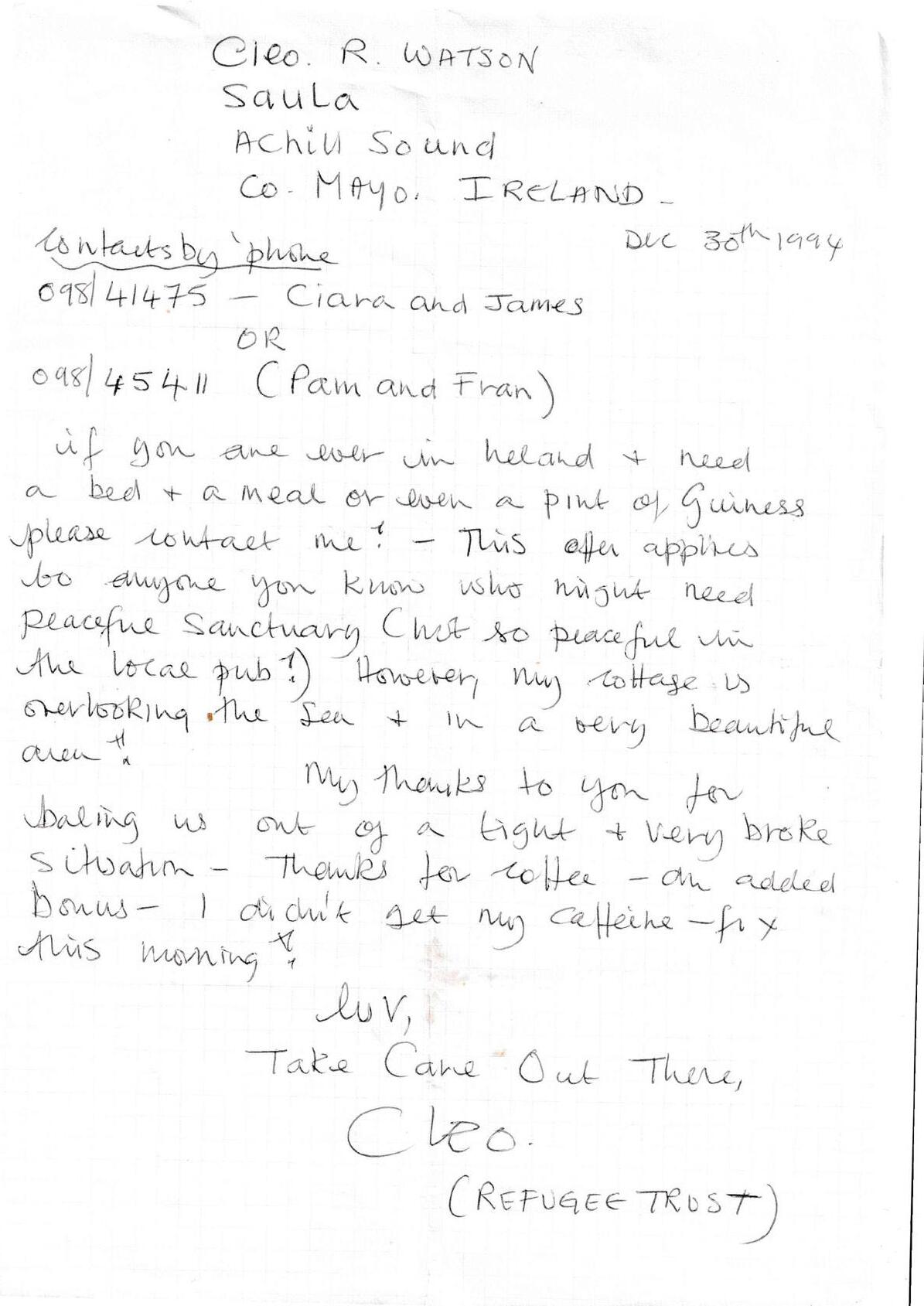
The four nurses introduced themselves as Cleo, Ciara, Pam, and Fran. I estimated them to be in their late twenties or early thirties, although they looked much older as a result of the harrowing ordeal they had endured.
Their faces were caked with dirt and their hair matted from the distressing experience. But beneath the layers of grime I could discern a hint of their once-rosy complexions, where tears had carved rivulets through the filth, serving as a poignant reminder of the horror they endured.
‘Thank you so very much for waiting for us, we realise that you have gone beyond the scope of your job’. Cleo’s eyes sparkled as the tears welled up.
12 FlightCom: October 2023
PILOTS
Letter from Cleo Watson, one of the nurses rescued from Rwanda
tears had carved rivulets through the filth
‘If Aziz hadn’t stood his ground, I’m convinced that we would have been raped’.
I took her hand in mine. ‘I’m really sorry you had such a terrifying experience. Let me fix you some coffee and get you some water to clean your faces’.
Little did I know at the time that it was not to be my first or my last apology for the savagery of this beautiful continent I called home.
The coffee in the thermos was lukewarm but the ladies gulped it down as if it had been nectar from heaven.
We bade farewell to Aziz and soon we were airborne. That evening the weather was kind to us as we crossed the magnificent Lake Victoria. We were surrounded by storms and my passengers were enamoured with the towering clouds as they flashed on and off like light bulbs.
My previous trip in the King Air from Kigali to Nairobi saw me inadvertently fly into a cell of bad weather. We were pelted by hail so profuse that my forward vision was completely obscured. Thank goodness for the autopilot. I ended up executing a 180-degree turn and descending to FL140 before I managed to escape it.
Flying alongside members of relief organizations restored my faith in humanity. I encountered extraordinary individuals, many of whom had forsaken their safe and comfortable lives to embark on a profound journey to a foreign continent, to unfamiliar lands with strange languages.

These courageous souls willingly ventured into war zones, driven by an unwavering commitment to aid people they had never met and might never meet again. They staked everything on their sense of purpose.
I would touch down, leaving these individuals in new, often perilous environments, only to takeoff once more. If fortune smiled upon us, our paths might cross again in six weeks or three months.
What unfolded during that time lay entirely at the mercy of fate. I couldn’t help but feel that these remarkable individuals deserved more recognition and gratitude than they received.
The Irish nurses made it home safely and expressed their gratitude by sending me a bottle of Johnny Black.
I knew I was merely doing my job, but I held immense respect for them, for their unwavering dedication to making the world a better place. If only they knew the profound impact their work had on those they touched, including a humble pilot like me.
FlightCom: October 2023 13
Aircraft Leasing Services (ALS) Wilson Airport.
JOHN BASSI
PART 4
TAMING TAILDRAGGERS
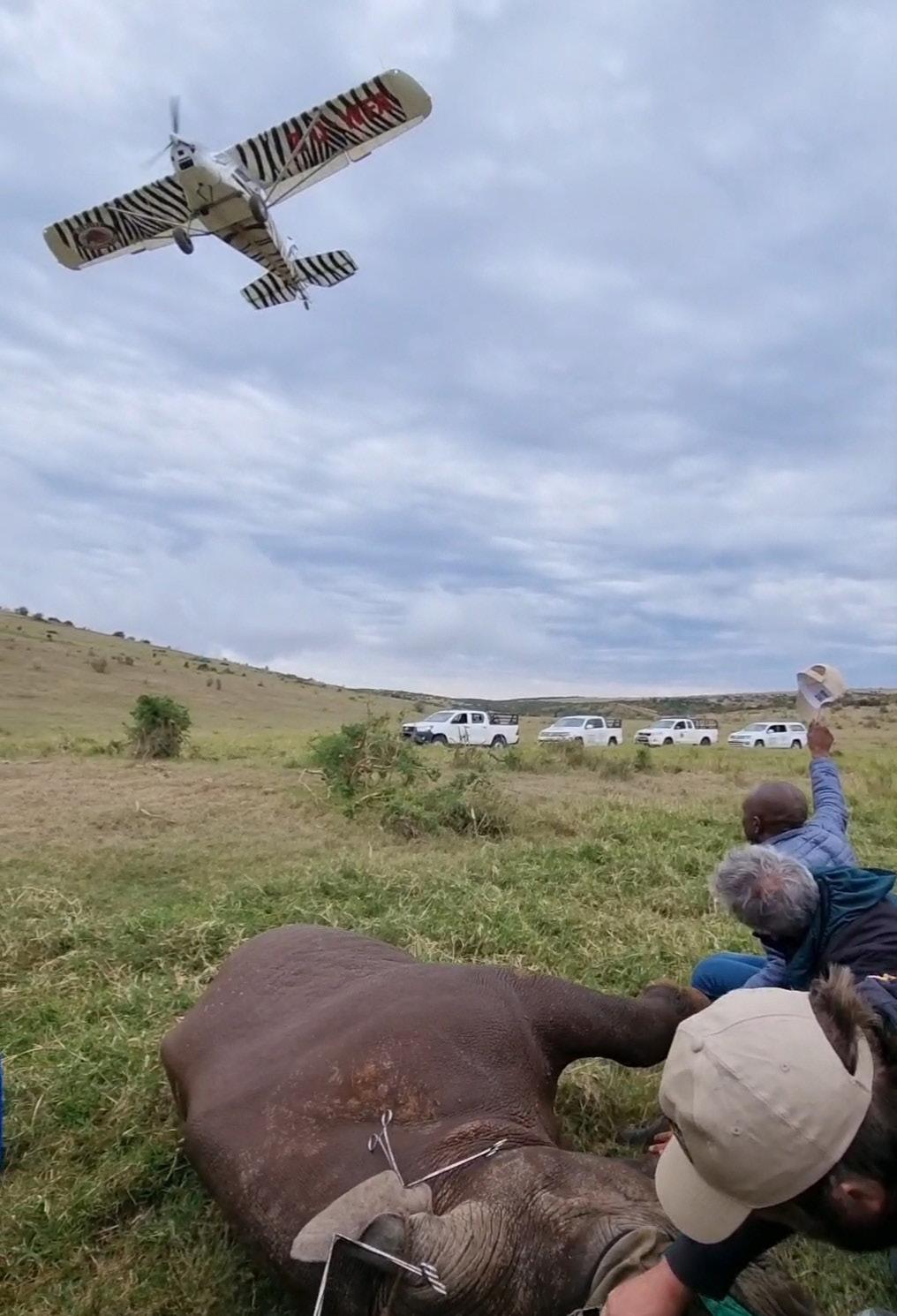
THE CG is an aeroplane’s balance point where the vertical, horizontal and longitudinal axes all meet. In a tricycle-gear plane, with a nosewheel, that CG sits along the longitudinal axis in front of the main landing gear roughly halfway back from the nose. That’s why the nosewheel wants to fall downward after touchdown. Once down, that nosewheel handles most of the steering chores.
On a taildragger, the main landing gear sits much farther forward, with the CG just behind it, making the plane far less forgiving of sloppiness in airspeed, flightpath and flight-control movement, and hence the plane’s manners during ground manoeuvres. Throw in a crosswind, and the efforts needed to keep the plane headed where you want are magnified.
Imagine a weathervane on a pole. Because of the vane’s CG, even the mildest breeze makes the front of the vane, or plane, try to point into the wind. Now imagine taxiing a taildragger pointed straight north with a wind from the west. The weather-vane effect tries to align the plane with the wind, a design trait for a weathervane, but
14 FlightCom: October 2023
So, what’s it like to fly a tail wheel? The challenge begins by understanding that the centre of gravity sets tailwheel and tricycle-gear planes apart.
A bushcat in its favourite habitat.
for a plane, not so much. That translates into the compulsion for the pilot to constantly use the rudder pedals, creating the often cursed “rudder dance.”
The trick is to lead the rudder movement to remain planted on the centre line, ensuring the tail wheel remains between the track of the main gear, a little right rudder, then a little left, and back and forth in hopefully smaller bites, in a dance of a coordinated series of inputs. Tailwheel pilots also learn to treat their brakes gingerly. Stomp on them during any kind of forward movement and the plane could go over on its nose, or even its back. Aircraft with a castering nosewheel that demand active rudder control can give pilots a small taste of taildragging.
respect for the use of the rudder
Because the nose of a taildragger is already pointing skyward on the ground, it’s impossible to see ahead to taxi. The only solution, other than adding a pillow beneath the pilot, is to “S” turn, looking out each side window as the aircraft turns. The trick here is to taxi a tailwheel plane slowly.
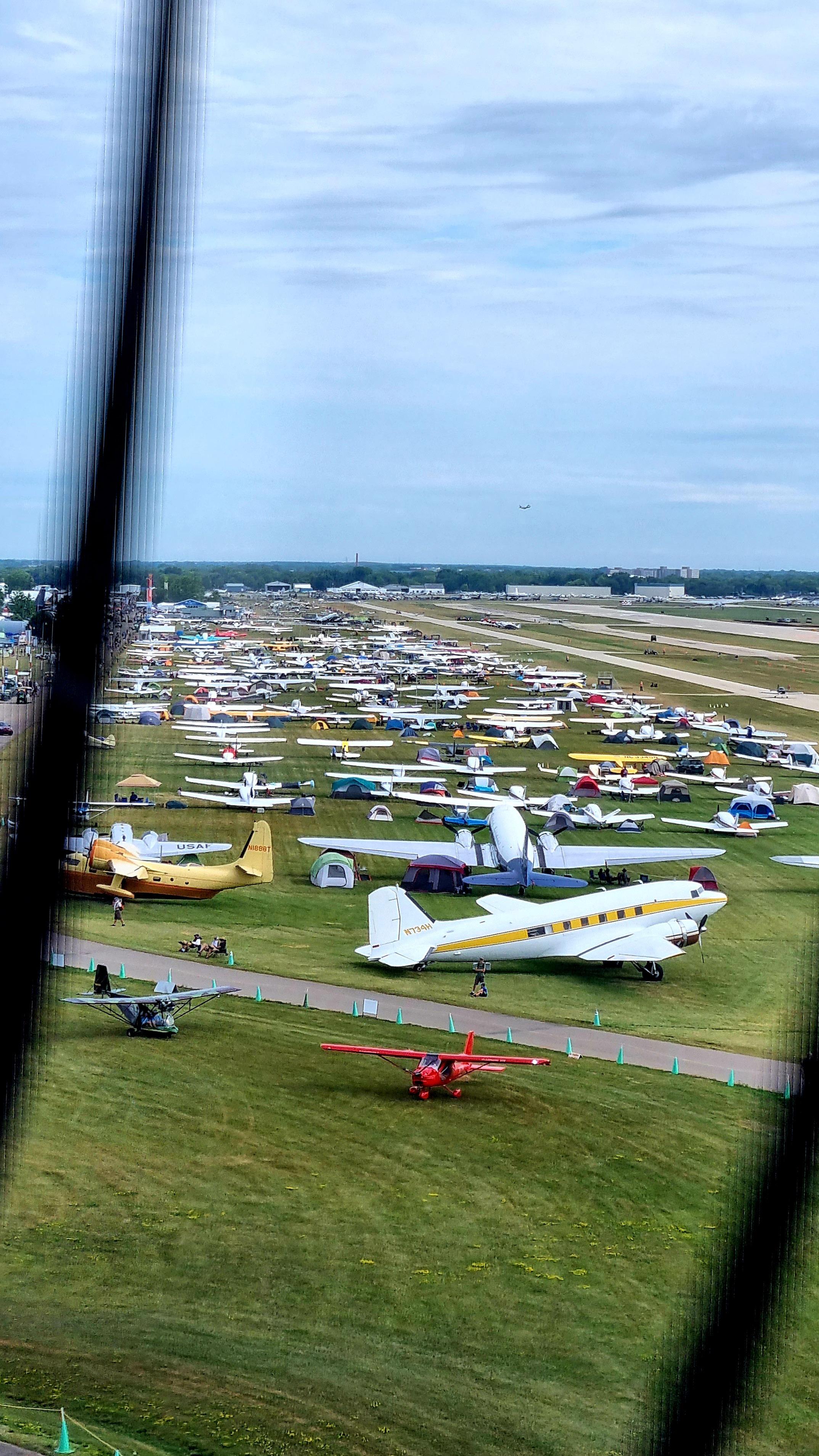
That nose-high attitude also adds a built-in angle of attack, making taildraggers more susceptible to the wind. A few hours of instruction in a moderate wind quickly teaches pilots the importance of remembering where to place the flight controls, both aileron and
rudder, to prevent surprise movements on the ground. The Plane Flying Handbook says, “The best approach is to understand that tailwheel aircraft are not damaged from the use of too much rudder, but rather from rudder inputs held for too long,” hence the need to practice that rudder dance.
FlightCom: October 2023 15
A tiny corner of Oskosh, from the seat of a bushcat. There were 10 000 aircraft on display.
After 400 to 500 landings in the Bushcat, I developed a serious respect for the use of the rudder during crosswind operations.
Once a pilot becomes comfortable taxiing a taildragger while correcting for the wind, landing and takeoff won’t seem all that different, at least when it comes to flight controls.
On takeoff, the pilot should gently and slowly add power and expect the plane to try and turn to the left on the ground, thanks to a more pronounced P-factor with that nose up in the air. A tailwheel pilot is ready with right rudder, but not too much. As the plane gains speed and begins turning right, the pilot must be ready with a little less right rudder and possibly some left. Back and forth it goes while at the same time, with that blast of air across the tail, the elevator quickly becomes effective. The pilot soon nudges just a little forward pressure on the stick (which initially feels so wrong) and raises the tail, a move that instantly increases the pilot’s visibility over the nose and improves the stability. Dance the rudder pedals and at
the correct speed, ease the stick back ever so slightly, and you’re flying. Now this becomes like flying any other plane.
Initially I got myself too bogged down in all the details of what to do or not do in a taildragger, but seriously, flying one of these planes is a whole lot of fun, making tricycle planes boring.

in a flash and a blur
on one wheel
On landing and takeoff, tailwheel pilots quickly learn just the right mixture of aileron, rudder and elevator during a crosswind, as well as touching down or lifting off on the upwind wheel to keep the plane pointed straight down the centreline. For landing, there’s a full stall, or three-point landing, as well as wheeler landings, where you try to keep the tail in the air as long as possible as the aircraft slows. This also feels so wrong initially.
In a three-point, the plane has finished flying by the time the plane touches down simultaneously on all three wheels. In the faster wheeler landing, the pilot has more positive control, touching down on just the
16 FlightCom: October 2023
The Oskosh Bushcat static display. Such a joy to fly the bushcat and see Oskosh from above.
mains first. The trick there is to feel the tail running out of effectiveness and gently lowering it to the ground.
There are rewards for the pilot who devotes the time to understand these tailwheel creatures. There are more precise movements of the flight controls that come from taildraggers, something I had almost forgotten, precise movements on the rudder, the ailerons and, most of all, the elevator. The need for gentle yet firm pitch control came flooding back to me, and just enough forward movement on the stick makes the little Bushcat come to life.
No doubt, flying a taildragger, even when you’re able to practice regularly, can easily become a humbling experience for the complacent pilot. Currency in a tailwheel plane must include full-stop landings.
No introduction to tailwheel planes would be complete without mentioning ground-loops, a notoriously uncontrolled manoeuvre lying in wait for any pilot who fails to remember their tailwheel basics.
I remember my first loop whilst almost coming to a dead stop after a slow taxi. With a slight crosswind the little Cat headed 30 degrees to the right of the centreline and, before either of us could stop it, it had spun round 360 degrees to a stop in a flash and a blur on one wheel.
Maybe all this tailwheel training really translates into a heightened sensitivity to what’s needed to fly a plane safely.
Crosswinds will always worry me, not because I think I can handle anything that comes along, but because of the unknown. I have well learned the importance of knowing when to head for another airport where the wind is more manageable, rather than risk a runway excursion.
Never stop flying a tailwheel plane, from the moment the engine spins over, until you tie it down on the ramp or close the hangar door.
AME Doctors Listing

FlightCom: October 2023 17
Regular Class 2, 3, 4 Senior Class 1, 2, 3, 4 On site Specialist tests Off-site Specialist tests FAA registered EASA registered Other countries SURNAME FIRST NAME LOCATION TEL NO E-MAIL Britz Rudi Wonderboom Airport 083 422 9882 rudiavmed@gmail.com ✗ ✗ ✗ ✗ Church Belinda Valhalla 079 636 9860 churchbs@live.com ✗ ✗ Du Plessis Alexander Athlone Park 031 904 7460 dex.duplessis@intercare.co.za ✗ ✗ ✗ Erasmus Philip Benoni 011 849 6512 pdceras-ass@mweb.co.za ✗ ✗ Govender Deena Umhlanga Rocks 031 566 2066/7 deena@drdg.co.za ✗ ✗ Ingham Kenneth Midrand 011 315 5817 kaingham@hotmail.com ✗ ✗ ✗ ✗ Marais Eugene Mossel Bay 044 693 1470 eugene.marais@medicross.co.za ✗ ✗ Opperman Chris Pretoria Lynnwood 012 368 8800 chris.opperman@intercare.co.za ✗ ✗ ✗ Tenzer Stan Rand Airport & JHB CBD 083 679 0777 stant@global.co.za ✗ ✗ ✗ Toerien Hendrik White River, Nelspruit 013 751 3848 hctoerien@viamediswitch.co.za ✗ ✗ ✗ Van Der Merwe Johann Stellenbosch 021 887 0305 johann.vdmerwe@medicross.co.za ✗ ✗
THE DAKOTA GAMBLERS WEEKEND
One Friday afternoon, two venerable Douglas DC-3 'Dakota' airliners started their engines at Lanseria Airport and taxied out for takeoff.
THIS WAS IN THE PRE ‘Bantustan’ era when legal gambling was prohibited in South Africa. Instead, local gamblers were obliged to journey to one of the neighbouring countries such as Botswana, Swaziland or Lesotho, to enjoy a legal casino weekend with accommodation, ala carte cuisine, and also the possibility of attending strip shows, or a locally banned movie.
Immigration formalities completed, 56 passengers comprising mostly men with a few wives and other sundry ladies boarded two Daks for the weekend jaunt to a foreign land.
I was in the cockpit of the lead Dak, with the second aircraft a few minutes behind us. Once airborne we both turned east for the green hills of Swaziland. Reaching nine thousand feet, each aircraft levelled off and reduced to cruising power.
The Highveld summer afternoon weather was clear, and the unpressurised Dakotas bumped occasionally as they surfed the warm air thermals, cruising at a stately 135 knots.

18 FlightCom: October 2023
JEFFREY KEMPSON
A Britten Norman Islander in the Okavango Delta.
Banned movies were a popular attraction in Swaziland and Lesotho.
Approaching Witbank, snacks and drinks were served. While I was eating an egg sandwich, a short middleaged chap entered the cockpit clutching an open beer can. Cockpit visitors were commonplace in those days, as the only aircraft being hijacked seemed to journey to Cuba, which was well beyond our range capability.
I greeted him cordially, and he looked at the instrument panel and said, “There are a lot of gauges.”
I agreed, “Yes, and we even know what they are all for.” This seemed to please him and he took a swig of his beer. Then he looked at his watch, and asked, “What time will be landing at Maseru?”
I looked at the other pilot, raised my eyebrows and said to the man; “We’re going to Matsapa in Swaziland, not to Maseru. That’s in Lesotho.”
He said, “No, we are going to the Maseru Holiday Inn for two nights. My daughter and her husband have already left by car to meet us there.”
I got onto the radio frequency tuned to the other Dakota, and spoke to the co-pilot; “Please ask our Chief Pilot, and multiple Dakota owner; Captain Fantastic, who took the booking for today’s flight? We have a passenger in the cockpit that is adamant that our destination should be Maseru. Specifically, the Holiday Inn there.”
There was a few moments silence, and the chief pilot, and aircraft owner replied, “I’ll ask my wife. She took the booking.”
This was in pre-GPS days, so we started scrabbling for aviation charts, a protractor, and a low altitude Jespersen radio navigation chart.
The Chief Pilot’s wife was the cabin attendant on the second Dak and she came on the radio and said, “Matsapa, Maseru. What’s the difference? Aren’t they the same place?”

FlightCom: October 2023 19
The more than 90 degree heading change need to alter course from Matsapa to Maseru.
“Matsapa, Maseru. What’s the difference?
“No” I replied. “They’re totally different towns – a great distance apart.”
There was a lengthy silence, then she meekly said “Oh, sorry.” Then Captain Fantastic came on and said. “Won’t you give me a heading, and tell ATC we are going to alter course for Maseru?”
I said, “No, I’m too embarrassed. You do it, your wife took the booking, and it’s just as well we filled right up with fuel. But stand by for a heading. It’s probably going to be over ninety degrees to the right, and we may have to change altitude for semi-circular compliance.”
I heard him call ‘Smuts ATC’ and the dialogue generated caused considerable mirth among the listening airborne fraternity.
I turned to the male passenger and said, “Would you mind leaving the cockpit now, we’re going to be a bit busy sorting this out. We have to look at maps, and work out a new heading and ETA, so won’t have time to chat.
He smirked and replied; “Lucky I came up here to talk to you guys.”
I nodded in agreement, then unfurled a one in a million scale aviation chart that included Lesotho. Shortly thereafter we found a plastic Jeppsen scale ruler which we applied to the low altitude Jepp radio chart, which gave us the new distance and heading. Then spinning my trusty metal aviation prayer wheel computer I came up with an ETA for Maseru.
I relayed these to Capt. Fantastic and his Co-pilot, who then spoke to ATC. Once on the new course, I ate the other half of my egg sandwich.
Then, as we had no working PA system, the other pilot went back into the cabin and told our lady cabin attendant to advise the pax of our new arrival time, some 45 minutes later than expected in Maseru, and to apologise for the incorrect booking, and ply them with more free alcohol.
The gamblers took the news with good cheer, and a little nervous laughter, as our cockpit visitor had already advised them that “we were lost, going the wrong way, but that he had saved us from landing at the wrong airport in the wrong country.”
I was glad this wasn’t a business flight where forthcoming appointments might have been missed, leading to angst and written repercussions.
In late afternoon sunlight we landed at the old Maseru Airport in good weather, with over an hour of daylight remaining. After completing immigration and customs formalities, we boarded the buses supplied by the Holiday Inn and transferred to the almost new hotel.
After breakfast the next morning, we noticed a poster displayed in reception advertising the showing of a banned film “Deep Throat.” It would be screened in one of the conference rooms at 11.00.
Unsurprisingly, with time on our hands, and not having this form of risqué entertainment available to us in Johannesburg, we male crew members elected to attend.
At the due time several of us sat down in the back row of seats. This lightweight row of seats was connected to each other at floor level and had been moved into the room as a single portable unit.
The film started, and we were disappointed to note that the thin closed curtains in the function room were a poor fit. Eager volunteers tugged them this way and that to try and block out the bright, invasive Lesotho morning light, with little success.
Adding to this, the quality of the film was so poor, that portions of it were barely discernible, and the star Ms Lovelace was sometimes almost invisible. This was a considerable disappointment to us.
Anyway, we pilots had had a few too many drinks in the bar the night before, and as the abysmal quality of the film and intrusive sunlight rendered the apparently classic blue movie unwatchable, I lost interest, and
20 FlightCom: October 2023
Ms Lovelace was almost invisible
dozed off. To be awoken a little later to a rhythmic rocking motion of our row of attached seats. I thought it was caused by an earth tremor, but moments later, to shouts of dismay, our entire row of connected seats fell backwards, and I found myself gazing at the bland ceiling.
We gingerly extracted ourselves from the prone row of seats, and one of our number claimed to have glimpsed a deviant male rushing out the door. His animations had doubtless induced our dangerous imbalance, Disappointed, we abandoned the unwatchable movie. Then, as I massaged my sore back, we all headed once again for the bar.
It was a memorable weekend for me in other ways as well. I was having lunch alone as my colleagues had gone off to a market. An attractive brunette lady, also dining solo, sat at an adjacent table and kept looking at me, which triggered the memory of an unusual event.
One long distant night, a young fellow aviator and I had attended a séance at a Parktown house. I had heard and

read a little of these activities where ostensibly psychic individuals sat around a table with a Ouija board. They would induce a trance and invite discarnate spirits to move an upturned glass over a letter board to spell out messages from “the other side.”
This particular séance was Ouija board free, but we all sat around an oval table anyway, in very dim lighting, as the ensemble took turns trying to attract discarnate spirits. Every now and then a participant would affect an unnaturally deep voice and start an incoherent muttering. Hearing this, one of the other mediums would intone the phrase “Welcome friend.” Thereafter the mumbling spirit would start relating a tale in a strange voice, not associated with their usual speech pattern.
Most of the visitors who “came through “claimed to be nobles of high birth. Cleopatra was one. Strangely, another was Sitting Bull, a long dead Red Indian Chief. None of the other visiting spirits seemed to be of a lower order. There were no deceased electricians, scullery maids, or others of that category present.
FlightCom: October 2023 21
Three of the Daks at their Lanseria base.
Anyway, my fellow pilot friend and I soon became bored, and quietly slipped out of the room. While closing the door, a large grey cat started rubbing itself against my legs. With the impetuosity of youth, I picked up the cat, walked quietly back into the room and gently placed the cat onto the table, and said in my deepest voice; “Welcome Pussy.” Then I closed the door.
Moments later the cat set up a loud caterwauling, then people started screaming, and all hell broke loose. We raced for the car, and sped away, never to be invited back.
I thought the lady at the next dining room table had been one of the participants at the séance, so I went over and asked, “Didn’t we meet at a séance in Parktown some time ago? I think you channelled Cleopatra.”
She gave me a withering look and replied; “Certainly not! I believe in God. Do you?”
I replied, “I’m sure you were playing Cleopatra that evening, and in fact you still look like her.”
A look of utter disdain crossed her face. She shrieked “Philistine!” at me and kept repeating that epithet with rising hysteria. I abandoned my desert and walked quickly out the dining room.
That evening, we were back in the dining room, which was packed with gamblers, we crew enjoyed a good meal while a three piece band and a female singer entertained us.
In my pre-professional pilot days I had been a musician, and then a cabaret stand-up comedian. So during a band break I struck up a conversation with the female vocalist. We established a rapport, and talked of the many excellent musicians we knew and some of the exclusive clubs where they had played in a more sophisticated era. I mentioned a friend called Johnny, a world class modern jazz musician.
After the band returned and started playing, the lady vocalist sang a tuneful ballad, and when the polite applause had died down, she looked directly at our
table, picked up the mike, and said; “Jeff, that song was for Johnny. This one’s for you!” Then she sang a Diana Ross number; “Upside down you’re turning me, you’re giving love instinctively….” It’s a really swinging, up-tempo number, and she had a good voice. So I had to dance.
The air hostess from our plane joined me and we excelled ourselves. After the number everyone applauded loudly. Even now, I remember that event being one of those rare, larger than life ‘peak experiences’.
When I sat down at our table, Captain Fantastic remarked “I didn’t know you had it in you.”
I replied, “That’s because you’re such an extrovert, you’re always grabbing centre stage and talking about yourself, so no one else can get a word in edgewise.”
That took the wind out of his sails. The other pilots thought of applauding, but not having been paid for the trip yet, thought better of it.
After a memorable evening I was invited to the lady vocalist’s staff flat. She had a hi-fi and we played music we enjoyed and discussed musicians we knew. It was a refreshing change from the usual banal pilot talk of, flaps and flight levels, tailwinds, and the recanting of fearsome thunderstorms we’d avoided.
The next morning I was happily late for breakfast. During that Sunday morning, Capt. Fantastic attended a Persian carpet auction at the hotel and purchased several of them.
Mid-afternoon we boarded the passengers into the two Dakotas, some of whom looked pretty rueful, doubtless contemplating their unmentioned losses.
Then both aircraft holds were almost filled with Persian carpets. We flew back to Lanseria without incident, nor any turbulence induced passenger illness. Sadly, the aircraft owner and chief pilot’s gambling excesses, together with his Persian Carpet purchases had left him short of funds. So, we freelance pilots didn’t get paid for that flight for a further three weeks.
22 FlightCom: October 2023
I was happily late for breakfast
THE URAL A320 FORCED LANDING
A Ural Airlines Airbus A320-200, flying from Sochi to Omsk in Russia was landed in a field after becoming fuel critical.

URAL FLIGHT U6-1383 with 159 passengers and 6 crew, was on final approach to Omsk’s runway when the crew initiated a go around from about 2,000ft due to a hydraulic failure. The aircraft climbed to 18,000 feet and diverted to Novosibirsk about 320 nm east of Omsk.
The A320 never made it to Novosibirsk. Just 11 km from the airport and with less than 5 minutes of fuel left, the decision was made to perform a forced emergency landing on an open field. Due to the hydraulic failure the landing gear doors remained open for the entire diversion which together with strong head winds increased fuel consumption.
The governor of Omsk stated that the crew reported a hydraulic problem affecting the brakes and were concerned the aircraft would not be able to stop on the runway in Omsk. The crew therefore diverted to Novosibirsk where longer runways (length 3,600 meters/11,800 feet) are available and sufficient to stop the aircraft despite the hydraulics failure. According to computations there should have been sufficient fuel on board to reach the aerodrome and land safely.
The nosewheel is being repaired and the aircraft is expected to be flown out of the field.
FlightCom: October 2023 23
NEWS
The Ural A320 after landing in a field.
FLYING SURGEONS END BURN NIGHTMARE
A little girl, who suffered horrific burns injuries when she was just one and a half, has been given fresh hope after treatment from a team of surgeons flown by Mission Aviation Fellowship (MAF) to remote towns in northern Kenya.

24 FlightCom: October 2023 MISSION FLYING - STORY BY JACQUELINE MWENDE
Under the wing of the MAF Cessna 208 - the CURE, MOHI and MAF Kenya team in Lodwar, Northern Kenya Photo, Acadius Akungwi.
THE LONG TERM DAMAGE caused by the horrific burns suffered by young Neyeso were compounded by her mother’s struggle to raise adequate funds for treatment. Then in a heartbreaking blow, after the family eventually raised the money, it was stolen before they reached the hospital.

Neyso’s breakthrough came when MAF Kenya flew a team of medical specialists for a round trip to three far-flung towns: Bura, Kargi and Lodwar in Northern Kenya for the long-running AIC CURE Medical Safaris.
The team that included orthopaedic surgeons, a trauma technician, a social worker, a data clerk, and a pastor used the MAF flights to avoid 9-10 hours of road travel, reaching their destinations after just two hours in the air.
The medical team assessed children with conditions such as club feet, syndactyly (joined fingers), chronic DDH (developmental dysplasia of the hip), cerebral palsy, contractures, and other medical conditions.
MAF Kenya flew a team of medical specialists
Neyeso’s journey
At only one and a half years old, Neyeso had been playing outside her house, when out of curiosity, she walked into a heap of manure that was smouldering nearby. She could not have known the danger.
Her mother heard screams and hurried outside to find out what was happening, only to find her daughter stuck in the burning manure. She quickly pulled her out of the fire.
fire was especially severe on her toes. Neyeso wailed in pain and could not lift her foot to walk.
Neyeso was rushed to the nearest hospital but due to a lack of money to cover hospital expenses, no assessment was carried out and they had to go back home. For nearly three months after the burns, Neyeso did not receive any treatment and the wounds became more infected, leaving her in unbearable pain.
The situation was also agonising for the parents due to the hard economic times many faced during the COVID-19 pandemic. They decided to seek help from family and friends as well as sell half of their livestock to raise funds for treatment.
With the little funds raised, they visited Marsabit County Referral Hospital but on their way, they lost everything they had to robbers. Upon reaching the hospital, an assessment was done by a physician who confirmed 30% burns on Neyeso but could not
The mother soon realised Neyeso had sustained severe burns on her left foot and hand. The damage from the
FlightCom: October 2023 25
Neyeso walks out of CURE Kijabe Hospital with a cast on her foot.
proceed with offering her treatment due to the severity of the burns and a lack of funds to cover the hospital bills. They all went back home without getting the help they needed.

Before leaving the hospital, the doctor referred them to yet another option; the Meru County Referral Hospital which the physician cited was more equipped to help her. Neyeso’s health kept on deteriorating to the point the mother thought she was going to lose her daughter. She went back home disappointed, but she held on to hope.
Family and friends raised more funds to cover transportation and treatment costs in Meru County and Neyeso and her mother were set to travel. Upon reaching the hospital, the doctors assessed her, and she was admitted, and treatment started immediately. Neyeso stayed at the hospital for four months.
At the end of the four months, Neyeso’s condition had slightly improved but her leg was bent inwards restricting her movement and her hand had been severely damaged that she could not hold anything. The doctors advised Neyeso’s mother to seek more help from specialist hospitals in the city to help correct the condition of her daughter’s hand and leg. She left the hospital and travelled back home.
The miracle had come at the right time
Hope knocks on the door
“When I came back home with my daughter, I felt like all hope was lost. I thought about all the days we had spent in the hospital, the struggles we faced to raise money and still my daughter did not receive the medical care she needed,” Neyeso’s mother said.
A devastated mother with her child in her arms, she had been left feeling hopeless but was still determined to get treatment for Neyeso after seven months of heartache.
“After a few days at home, a neighbour came with the news that MAF was flying in specialists for the AIC CURE International Hospital, which was setting up a clinic at the Missions of Hope International School Napuu in Lodwar, not far from where we lived,” she said.
“I quickly decided to take Neyeso to the clinic and immediately after the doctor assessed her condition, she was scheduled for her first surgery to treat her leg which was severely damaged. I could not thank God enough for this big miracle,” her mother added.
The miracle had come at the right time when the family needed it. Neyeso went for surgery at the CURE Kijabe Hospital, and it was a success.
During the September CURE safari clinic, Neyeso was brought by her parents for a post-surgery observation, and the doctors were happy to see that she had fully recovered her mobility and could walk well.
26 FlightCom: October 2023
Neyeso is held by her father after they were discharged from the hospital. Photo, Amon Tole
P&W’S GTF – A U$3 BILLION RECALL
Airlines will need to remove hundreds of Pratt & Whitney PW1100G geared turbofan (GTF) engines from the wings of Airbus A320neo family jets by the end of 2024 to inspect for defective high-pressure turbine and compressor discs.

P&W PARENT COMPANY RTX revealed the scope of the issue on 11 September, which it says will cost it over $3 billion. It centres on a previously disclosed defect involving a “rare condition in powdered metal used to manufacture certain engine parts”.
P&W discovered the issue in 2020 when an in-service International Aero Engines (IAE) V2500 engine suffered a blade failure. P&W, which is the majority owner of IAE, makes V2500 and PW1100G blades using the same process. Since then, the engine maker and US Federal Aviation Administration had taken piecemeal steps to address the problem in various groups of V2500s and PW1100Gs.
The issue is sure to further disrupt an airline industry already struggling with shortages of engines and maintenance capacity.
RTX says 600-700 PW1100G engines must be removed from A320neos and inspected between now and 2026. That figure is “beyond [P&W’s] shop visit forecast entering 2023”. Of those inspections, the “majority” will be completed this year and early next.
MTU Aero Engines – which owns 18% of the GTF programme – says the problem will result in “an average of 350 aircraft-on-ground in the period 2024 to 2026”. RTX says it will take a $3.5 billion charge against its third-quarter results due to the issue. MTU expects the problem will cost it €1 billion ($1.08 billion) in lost revenue this fiscal year.
But in August, RTX said many more PW1100Gs –
some 1,200 – might have defective components. It also said those engines would need to be removed over the next year. P&W does explain how the 1,200 figure differs from its latest estimate of 600-700 engines.
“We are focused on addressing the challenges arising from the powder metal manufacturing issue,” says RTX chief executive Greg Hayes. “We recognise this is an extremely difficult situation for our customers, and we are proactively taking steps to support and mitigate the operational impact to them.”
The company developed a separate plan to address the defect in a broader group of PW1100Gs. Under that plan, operators will need to inspect the discs in affected engines every 2,800-3,800 flight cycles, and replace components every 5,000-7,000 cycles.
Still unclear, however, is the degree to which other P&W engines might be affected. The manufacturer is now evaluating the scope of the problem, but it believes other powerplants will be “far less impacted based on existing inspections, lower utilisation profiles and/or existing maintenance interviews”.
FlightCom: October 2023 27
NEWS
A P&W GTF engine on an A230.
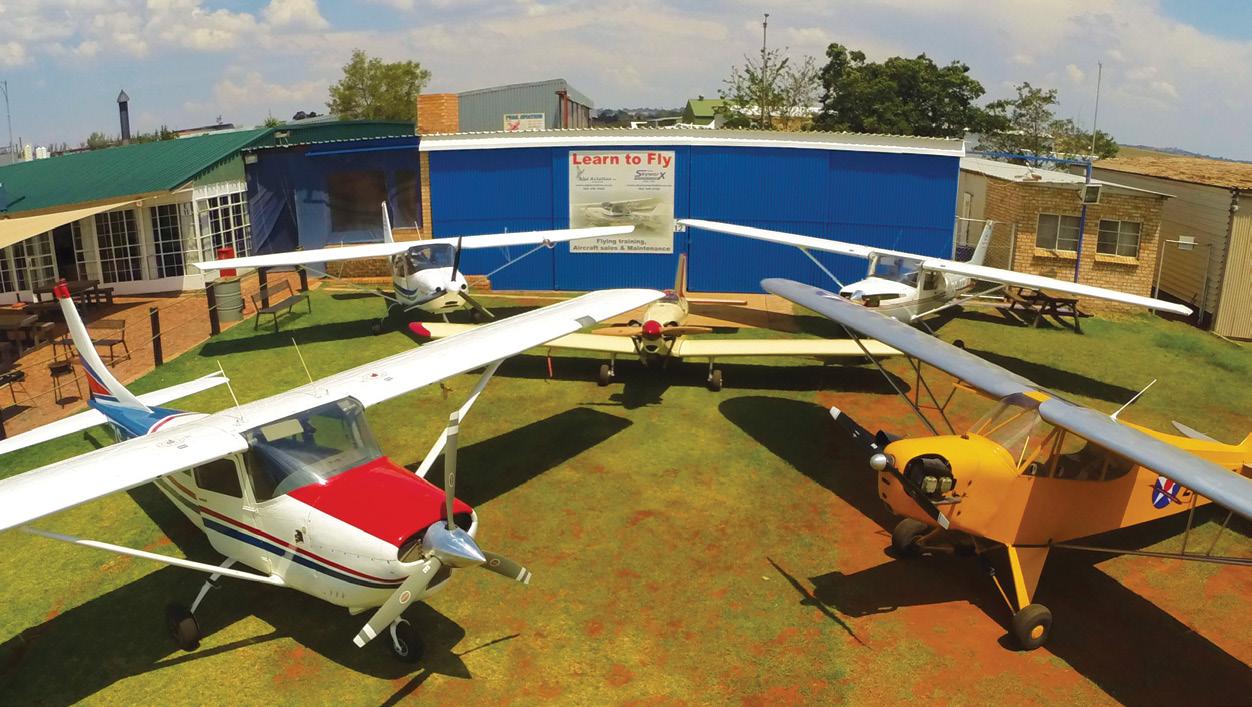



28 FlightCom: October 2023 www.alpiaviation.co.za TurbineGS Training Ab-Initio Training Single Engined Multi Engine Night Rating IF Rating Instructors Rating Simulator Training Conversions CPL Theory CPL Practical Helicopter Training Tail Draggers Pilot Shop Conferences Hire and Fly Charters Aerobatic Training Beginners/Advanced Gyro-Copter Training Microlights & Ferry Flights Accommodadtion Aircraft/Heli Sales Club Facilities Drones NAME OF SCHOOL CODE TEL NO FAX NO BEAUFORT WEST AIFA (044) 272 5547 info@aifa.co.za j j j j j j j j j j j BRAKPAN BENONI FABB Titanium Air (011) 914-5810 083-292-0978 j j j j DURBAN Starlite Aviation Training Academy (031) 571-6600 www.starliteaviation.com j j j j j j j j j j j j j j j j j j j j j j j EAST LONDON Border Aviation Club (043) 736-6181 086-516-8475 j j j j j j j j j j j j j j j GEORGE AIRPORT AIFA (044) 272 5547 info@aifa.co.za j j j j j j j j j j j Savannah Helicopter Training (044) 876-0096 j j j j j j j j j j j GRAND CENTRAL Superior Pilot Services (011) 805-0605 805-0604 j j j j j j j j j j j j j j j j j KRUGERSDORP Alpi Flight Academy (082) 556-3592 086-605-8948 j j j j j j j j j j j j j j j j j LANSERIA AIRPORT / RANDBURG Aeronav Academy (011) 701-3862 701-3873 j j j j j j j j j j j j j j CSA Aviation (011) 701-3835 www.cirrussa.co.za j j j j j j j j j j j j j j Skyhawk Aviation (011) 701-2622 701-2623 j j j j j j j j j j j j j j j j MOSSEL BAY Starlite Aviation Training Academy (044) 692-0006 www.starliteaviation.com j j j j j j j j j j j j j j j j j j j j j j j PANORAMA Johannesburg Flying Academy (064) 756 6356 j j j j j j j j j j j j j PORT ELIZABETH Algoa Flying Club (041) 581-3274 086-461-7067 j j j j j j j j j j j j j j j RAND AIRPORT Johannesburg School of Flying (011) 827 9827 info@jsf.co.za j j j j j j j j j j j j j j j U Fly Training Academy (011) 824-0680 390-1738 j j j j j j j j j j j j j j j VEREENIGING AIRPORT Bird Aviation (016) 556-1007 info@birdaviation.co.za j j j j j j j j j j j j j j j j j WINDHOEK - EROS AIRPORT Desert Air (PTY) LTD +264 61 228101 +264 61 254 345 j j j j j j j j j j j WONDERBOOM AIRPORT / AEROPARK / RHINO PARK - PRETORIA Blue Chip Flight School (012) 543-3050 543-1826 j j j j j j j j j j j j j j j j j j j Loutzavia (012) 567-6775 543-1519 j j j j j j j j j j j j j j j j j j j Legend Sky (083) 860-5225 086-600-7285 j j j j j j j j j j j j j j j j j Powered Flight Training (078) 460-1231 086-666-2077 j j j j j j j j j j j j j j j j j Vortx Aviation Training (072) 480-0359 086-524-0949 j j j j j j j j j j j j j
www.balloon.co.za Do it in style! Learn to Fly with Us
FROM NPL THROUGH TO CPL



CHARTER DIRECTORY < 20 pax > 20 pax Biz-Jets V.I.P Long-Range Freight Helicopter Special Events Safari Charters Contracts Aircraft Sales Surveys Maintenance Aerial Photography Aircraft Leasing Security Based (armed) Line Inspections Lodge Transfers Export Docs & Clearing Hangarage Dangerous Goods NAME OF CHARTER CODE TEL NO FAX NO BRAKPAN FABB Titanium Air (011) 914 5810 083 292 0978 j j j j j CAPE TOWN ExecuJet South Africa (021) 934 5764 934 2087 j j j j j j j j j j j j j j j j Streamline Air Charter (011) 395 1195/8 j j j j j j j j DURBAN KZN Aviation (031) 564 6215 564 6222 j j j j j j j j j j j GRAND CENTRAL Pambele Aviation (011) 805-0652/82 805-0649 Dreams Treasury | Working Capital | Asset Management | Wealth
South Africa
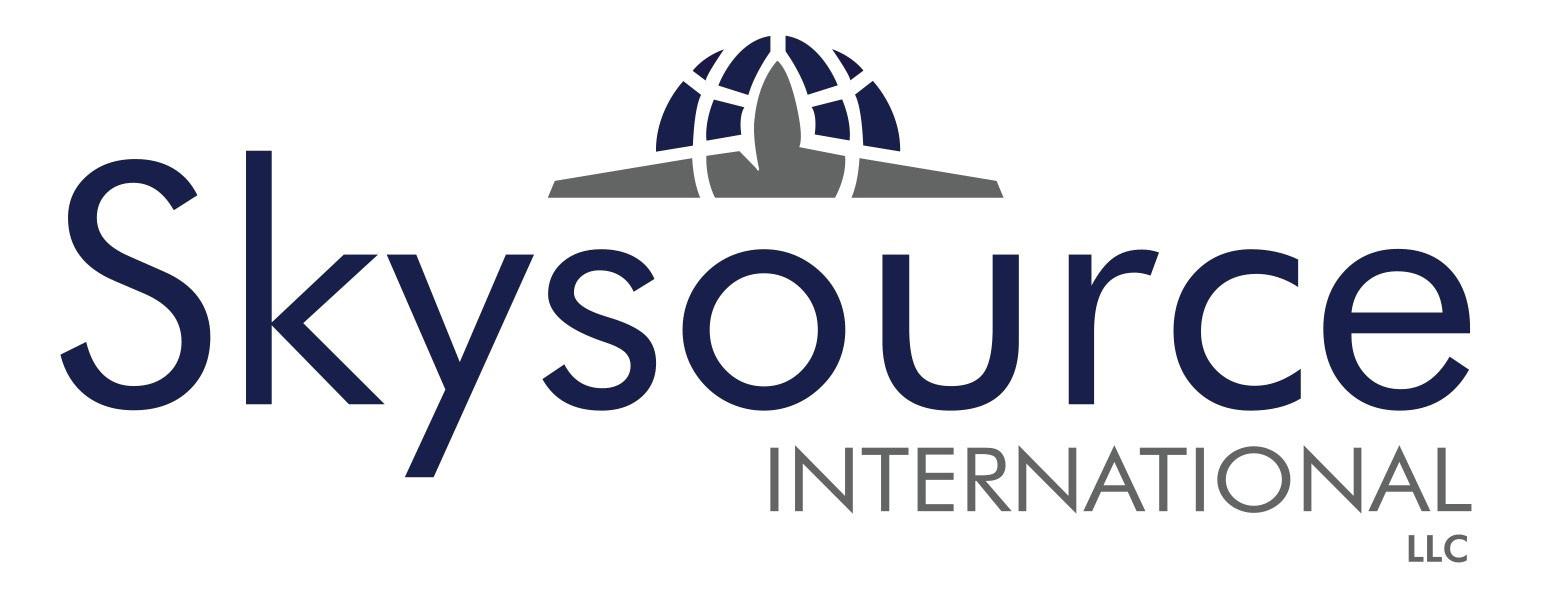
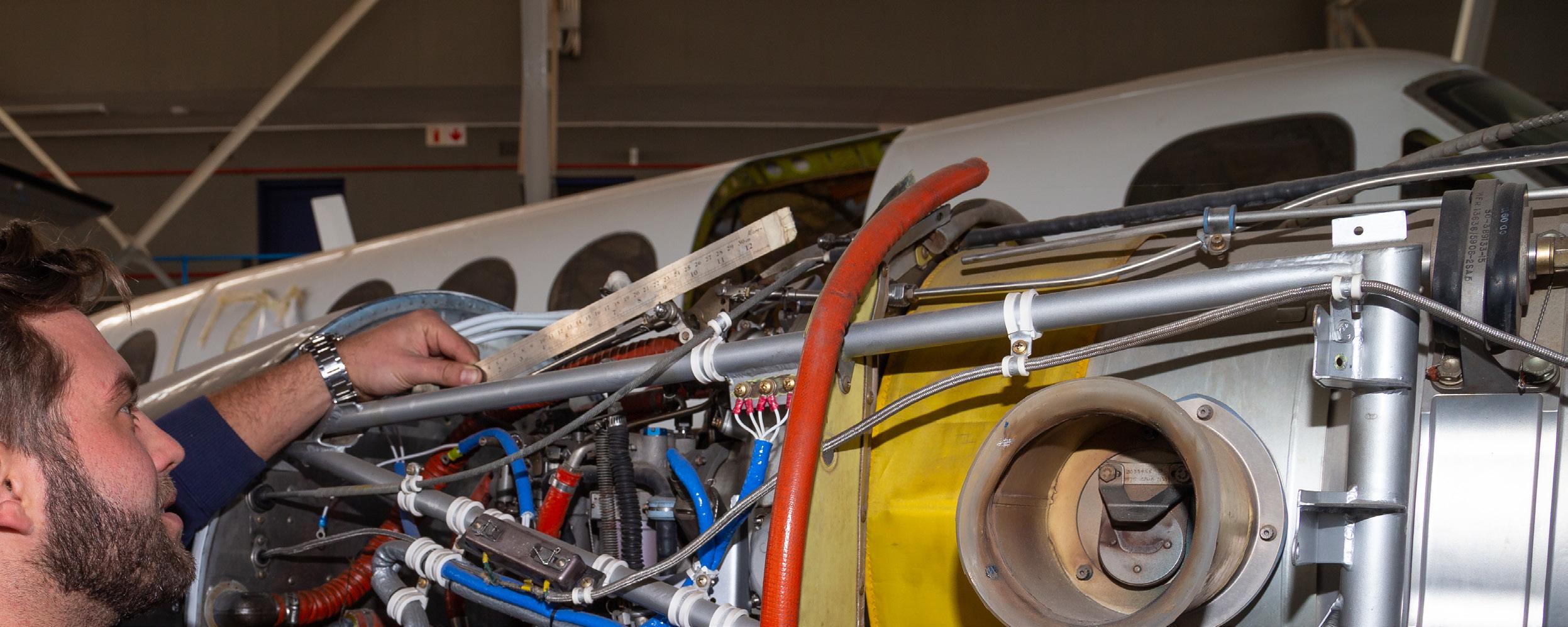
Fixed Wing Helicopter Avionics Piston Engines Turbine Engines Propellers Weight / Balance Paint Interior Sheet Metal Rebuilds Overhauls Electrics NDT Testing Refurbishments Structural Repairs Inspections NTCA Aircraft Seat Belts Instruments NAME OF AMO CODE TEL NO FAX NO CAPE TOWN Erwin Electrical Solutions t/a AES (021) 934 5373 j j j j j j j j j ExecuJet South Africa (021) 934 5764 934 2087 j j j j j j j j j j j j j j j Ultimax Aviation (Pty) Ltd (072) 878 8786 j j j j j j j j j j j j j DURBAN BAC Aviation (035) 797 3610 797 5341 j j j j j j j j j j GRAND CENTRAL AIRPORT Astwood Aircraft Electrical (011) 315 9605 315 0094 j Superior Rotorworx (076) 595 2120 j j j j j j j j j j j j j j j j j KRUGERSDORP Skyworx Aviation (082) 346 0150 086 697 9096 j j j j j j j j j j j LANSERIA AIRPORT Erwin Electrical Solutions t/a AES (021) 934 5373 j j j j j j j j ExecuJet South Africa (011) 516 2300 011 659 1071 j j j j j j j j j j j j j j j Gem Air (082) 905 5760 011 701 2653 j j j j j j Guardian Air Maintenance (011) 701 3011 j j j j Lanseria Aircraft Interiors (011) 659 1962 j j j j j j Plane Maintenance Facility (011) 659 2204 pmf@myconnection.co.za j j j j j j j j j j j j j SkySource International SA (011) 900 4300 j j j j j j j j j j j j j j The Propeller Shop (011) 701 3114 086 543 7988 j Tynay Aviation (082) 088 6663 011 659 1157/8 j j j j j j j j CAPE WINELANDS AIRPORT Diepkloof Aircraft Maintenance (083) 454 6366 j j j j j j j j j j j j NELSPRUIT Aircraft Maintenance International (013) 741 8221 082 787 0415 j j j j j j j j j j j j j Leading Edge Helicopters cc (013) 741 5582 741 8188 j j j j j j NEW TEMPE BLOEMFONTEIN Ferreira Aviation (051) 451 1682 451 1683 j j j j j j j j j j j OR TAMBO INTERNATIONAL AIRPORT Nevergreen Aircraft Industries (010) 003 3747 manager@nevergreen.co.za j j j Star Air Maintenance (011) 395 2201 973 4761 j j j j j j j j j RAND AIRPORT1 Aerospace Electroplating (011) 827 7535 827 9896 j j j j j j j j Aviation Rebuilders CC (011) 827 2491 lyn@aviationrebuilders.com j j j j j Clifton Electronics (011) 383 2024 086 689 5645 j j j Dynamic Propellers (082) 445 4496 086 548 2651 j j Skytrim (011) 827 6638 www.skytrim.co.za j j j j AMO LISTING AMO 1427 www.skysourcesa.com
PTY Skysource International SA, Hangar 203, Lanseria International Airport
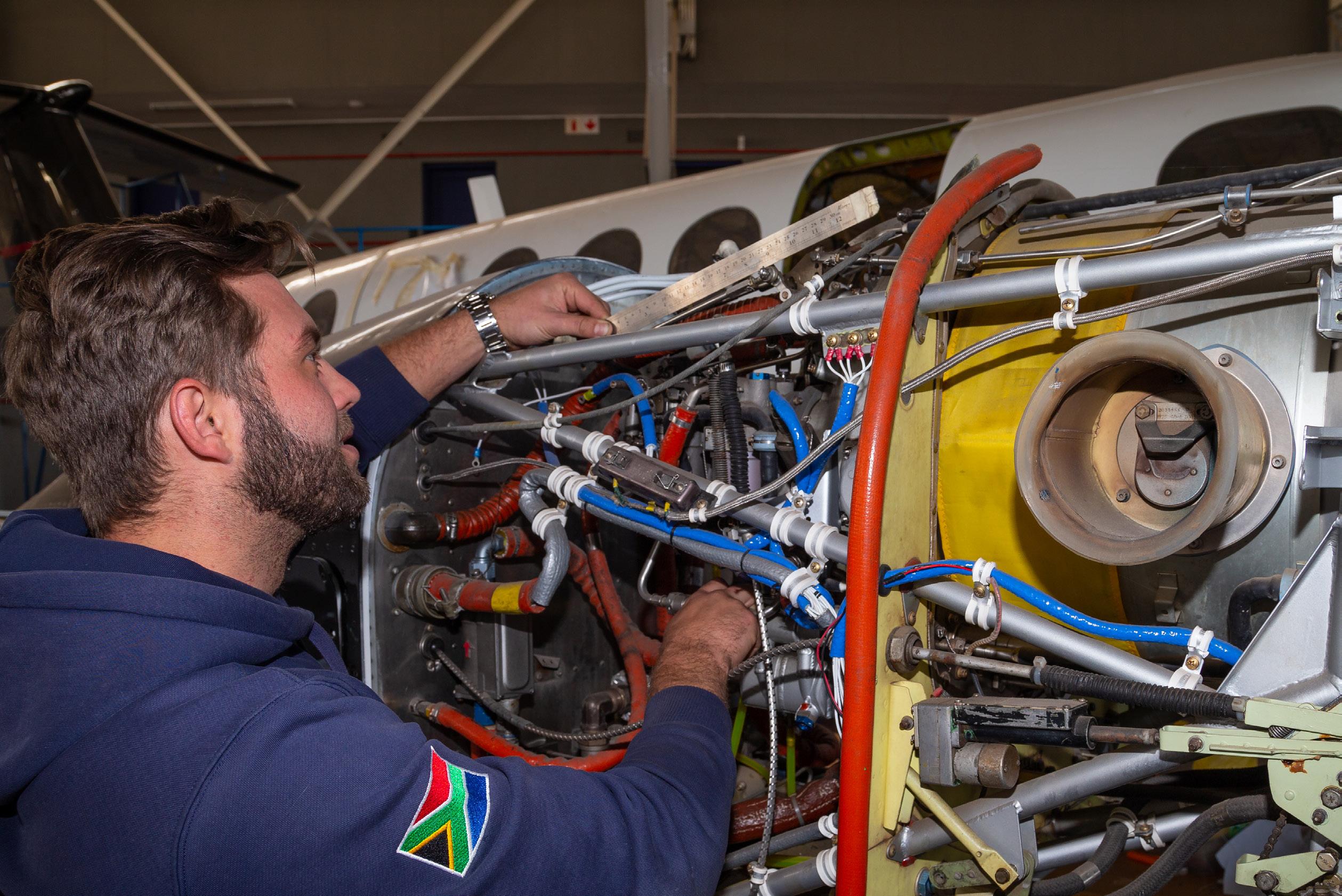

NAME OF AMO CODE TEL NO FAX NO Fixed Wing Helicopter Avionics Piston Engines Turbine Engines Propellers Weight / Balance Paint Interior Sheet Metal Rebuilds Overhauls Electrics NDT Testing Refurbishments Structural Repairs Inspections NTCA Aircraft Seat Belts Instruments Composite Manufacturing RAND AIRPORT CONTINUED Emperor Aviation (082) 497 1701 j j j j j j j j j j j j j j j FLYONICS (Pty) Ltd (082) 686 2374 michael@flyonics.co.za j j j Heli-Afrique cc (011) 827 8632 086 503 1870 j j j j j j j j j j SPRINGS AIRFIELD Legair Maintenance (083) 736 3969 086 508 6010 j j j j j j j j j j j j j j j j j WONDERBOOM AIRPORT - PRETORIA 208 Aviation 083 744 3412 j j j j j j Aerocore (012) 110 4033 082 565 2330 j j j Aircraft Maintenance @ Work Pty Ltd (012) 567 3443 j j j j j j j Aerotric (087) 802 1347 aerotric@aol.com j j j j j Aero Engineering & Powerplant (012) 543 0948 543 9447 j j AviSys Aviation Systems (083) 442 5884 086 618 6996 j j j j j Avtech (082) 749 9256 j j j j j j j APCO Pty Ltd (012) 543 0775 567 3630 j j j Breytech Aviation cc (012) 567 3500 086 643 0122 j j j j j j j j j j j j j j Propeller Centre cc (012) 567 1689 j j NIGERIA - MURTALA MUHAMMED INTERNATIONAL AIRPORT ExecuJet Aviation Nigeria Ltd +2341 295 5110 j j j j j j j j j j j j JOHANNESBURG F Gomes Upholsters (011) 614 2471 614 9806 j j j j j PRETORIA M&N Acoustics Services Pty (Ltd) (012) 689 2007 086 211 469 j j j j j j j j j j j AMO LISTING AIRCRAFT MAINTAINENANCE AND REFURBISHMENT QUALITY IS OUR PASSION CALL US NOW FOR ALL OF YOUR AVIATION NEEDS! info@skysourcesa.com +27 10 900 4300 • +27 72 036 3433 WE SPECIALIZE IN: Pilatus PC-12 Beechcraft 90 Series Beechcraft 200 Series Beechcraft 350 Series Beechcraft 1900D Series Cessna Caravan C208 Series Aircraft info@skysourcesa.com +27 10 900 4300 • +27 72 036 3433
BACKPAGE DIR ECT ORY
208 Aviation
Ben Esterhuizen +27 83 744 3412 ben@208aviation.co.za www.208aviation.com
A1A Flight Examiner (Loutzavia)
Jannie Loutzis 012 567 6775 / 082 416 4069 jannie@loutzavia.co.za www.loutzavia.co.za
AES (Cape Town)
Erwin Erasmus 082 494 3722 erwin@aeroelectrical.co.za www.aeroelectrical.co.za
AES (Johannesburg)
Danie van Wyk 011 701 3200 office@aeroelectrical.co.za www.aeroelectrical.co.za
Aerocolour cc
Alfred Maraun 082 775 9720 aeroeng@iafrica.com
Aero Engineering & PowerPlant
Andre Labuschagne 012 543 0948 aerocolour@telkomsa.net
Aerokits
Jean Crous 072 6716 240 aerokits99@gmail.com
Aeronav Academy
Donald O’Connor 011 701 3862 info@aeronav.co.za www.aeronav.co.za
Aeronautical Aviation
Clinton Carroll 011 659 1033 / 083 459 6279 clinton@aeronautical.co.za www.aeronautical.co.za
Aerospace Electroplating
Oliver Trollope 011 827 7535 petasus@mweb.co.za
Aerotel
Martin den Dunnen 087 6556 737 reservations@aerotel.co.za www.aerotel.co.za
Aerotric
Richard Small 083 488 4535 aerotric@aol.com
Aviation Rebuilders cc Lyn Jones 011 827 2491 / 082 872 4117 lyn@aviationrebuilders.com www.aviationrebuilders.com
AVIC International Flight Academy (AIFA)
Theo Erasmus 082 776 8883 rassie@aifa.co.za
Air 2000 (Pty) Ltd
Anne Gaines-Burrill 011 659 2449 - AH 082 770 2480 Fax 086 460 5501 air2000@global.co.za www.hunterssupport.com
Aircraft Finance Corporation & Leasing
Jaco Pietersen +27 [0]82 672 2262 jaco@airfincorp.co.za
Jason Seymour +27 [0]82 326 0147 jason@airfincorp.co.za www.airfincorp.co.za
Aircraft General Spares Eric or Hayley 084 587 6414 or 067 154 2147 eric@acgs.co.za or hayley@acgs.co.za www.acgs.co.za
Aircraft Maintenance International Pine Pienaar 083 305 0605 gm@aminternational.co.za
Aircraft Maintenance International Wonderboom Thomas Nel 082 444 7996 admin@aminternational.co.za
Air Line Pilots’ Association
Sonia Ferreira 011 394 5310 alpagm@iafrica.com www.alpa.co.za
Airshift Aircraft Sales Eugene du Plessis 082 800 3094 eugene@airshift.co.za www.airshift.co.za
Alclad Sheetmetal Services
Ed Knibbs 083 251 4601 ed@alclad.co.za www.alclad.co.za
Algoa Flying Club Sharon Mugridge 041 581 3274 info@algoafc.co.za www.algoafc.co.za
Alpi Aviation SA
Dale De Klerk 082 556 3592 dale@alpiaviation.co.za www.alpiaviation.co.za
Apco (Ptyd) Ltd
Tony/Henk + 27 12 543 0775 apcosupport@mweb.co.za www.apcosa.co.za
Ardent Aviation Consultants Yolanda Vermeulen 082 784 0510 yolanda@ardentaviation.co.za www.ardentaviation.co.za
Ascend Aviation Marlo Kruyswijk 079 511 0080 marlo@ascendaviation.co.za www.ascendaviation.co.za
Atlas Aviation Lubricants
Steve Cloete 011 917 4220 Fax: 011 917 2100 sales.aviation@atlasoil.co.za www.atlasaviation.co.za
AVDEX (Pty) Ltd
Tania Botes 011 954 15364 info@avdex.co.za www.avdex.co.za
Aviatech Flight Academy
Nico Smith 082 303 1124 viatechfakr@gmail.com www.aviatech.co.za
Aviation Direct Andrea Antel 011 465 2669 info@aviationdirect.co.za www.aviationdirect.co.za
Avtech Riekert Stroh 082 749 9256 avtech1208@gmail.com
BAC Aviation AMO 115 Micky Joss 035 797 3610 monicad@bacmaintenance.co.za
Blackhawk Africa Cisca de Lange 083 514 8532 cisca@blackhawk.aero www.blackhawk.aero
Blue Chip Flight School
Henk Kraaij 012 543 3050 bluechip@bluechip-avia.co.za www.bluechipflightschool.co.za
Bona Bona Game Lodge MJ Ernst 082 075 3541 mj@bonabona.co.za www.bonabona.co.za
Breytech Aviation cc 012 567 3139 Willie Breytenbach admin@breytech.co.za
Celeste Sani Pak & Inflight Products
Steve Harris 011 452 2456 admin@chemline.co.za www.chemline.co.za
Cape Town Flying Club Beverley Combrink 021 934 0257 / 082 821 9013 info@capetownflyingclub.co.za www.@capetownflyingclub.co.za
Century Avionics cc Carin van Zyl 011 701 3244 sales@centuryavionics.co.za www.centuryavionics.co.za
Chemetall Wayne Claassens 011 914 2500 wayne.claassens@basf.com www.chemetall.com
Chem-Line Aviation & Celeste Products
Steve Harris 011 452 2456 sales@chemline.co.za www.chemline.co.za
Clifton Electronics cc CJ Clifton / Irene Clifton 079 568 7205 / 082 926 8482 clive.iclifton@gmail.com
Comair Flight Services (Pty) Ltd Reception +27 11 540 7640/FAX: +27 11 252 9334 info@flycfs.co.za www.flycfs.co.za
Corporate-Aviators/Affordable Jet Sales
Mike Helm 082 442 6239 corporate-aviators@iafrica.com www.corporate-aviators.com
CSA Aviation – Cirrus South Africa
Alex Smith 011 701 3835 alexs@cirrussa.co.za www.cirrussa.co.za
C. W. Price & Co Kelvin L. Price 011 805 4720 cwp@cwprice.co.za www.cwprice.co.za
Dart Aeronautical Pieter Viljoen 011 827 8204 pieterviljoen@dartaero.co.za www.dartaero.co.za
Dart Aircraft Electrical Mathew Joubert 011 827 0371 Dartaircraftelectrical@gmail.com www.dartaero.co.za
Diepkloof Aircraft Maintenance cc Nick Kleinhans 083 454 6366 diepkloofamo@gmail.com
DJA Aviation Insurance 011 463 5550 0800Flying mail@dja-aviation.co.za www.dja-aviation.co.za
Dynamic Propellers Andries Visser 011 824 5057 082 445 4496 andries@dynamicpropeller.co.za www.dynamicpropellers.co.za
Eagle Flight Academy Mr D. J. Lubbe 082 557 6429 training@eagleflight.co.za www.eagleflight.co.za
Execujet Africa 011 516 2300 enquiries@execujet.co.za www.execujet.com
Federal Air Rachel Muir 011 395 9000 shuttle@fedair.com www.fedair.com
Ferry Flights int.inc. Michael (Mick) Schittenhelm 082 442 6239 ferryflights@ferry-flights.com www.ferry-flights.com
F Gomes Upholsters Carla de Lima 083 602 5658 delimaCarla92@gmail.com
Fireblade Aviation 010 595 3920 info@firebladeaviation.com www.firebladeaviation.com
Flight Training College Cornell Morton 044 876 9055 ftc@flighttrainning.co.za www.flighttraining.co.za
Flight Training Services Amanda Pearce 011 805 9015/6 amanda@fts.co.za www.fts.co.za
Fly Jetstream Aviation Henk Kraaij 083 279 7853 charter@flyjetstream.co.za www.flyjetstream.co.za
Flying Unlimited Flight School (Pty) Ltd Riaan Struwig 082 653 7504 / 086 770 8376 riaan@ppg.co.za www.ppg.co.za
Flyonics (Pty) Ltd Michael Karaolis 010 109 9405 michael@flyonics.co.za www.flyonics.co.za
Gemair Andries Venter 011 701 2653 / 082 905 5760 andries@gemair.co.za
GIB Aviation Insurance Brokers Richard Turner 011 483 1212 aviation@gib.co.za www.gib.co.za
Guardian Air 011 701 3011 082 521 2394 ops@guardianair.co.za www.guardianair.co.za
Heli-Afrique cc Tino Conceicao 083 458 2172 tino.conceicao@heli-afrique.co.za
Henley Air Andre Coetzee 011 827 5503 andre@henleyair.co.za www.henleyair.co.za
Hover Dynamics Phillip Cope 074 231 2964 info@hover.co.za www.hover.co.za
Indigo Helicopters Gerhard Kleynhans 082 927 4031 / 086 528 4234 veroeschka@indigohelicopters.co.za www.indigohelicopters.co.za
IndigoSat South Africa - Aircraft Tracking Gareth Willers 08600 22 121 sales@indigosat.co.za www.indigosat.co.za
International Flight Clearances Steve Wright 076 983 1089 (24 Hrs) flightops@flyifc.co.za www.flyifc.co.za
32 FlightCom: October 2023
Investment Aircraft
Quinton Warne 082 806 5193 aviation@lantic.net www.investmentaircraft.com
Jabiru Aircraft
Len Alford 044 876 9991 / 044 876 9993 info@jabiru.co.za www.jabiru.co.za
Jim Davis Books
Jim Davis 072 188 6484 jim@border.co.za www.jimdavis.co.za
Joc Air T/A The Propeller Shop Aiden O’Mahony 011 701 3114 jocprop@iafrica.com
Johannesburg Flying Academy
Alan Stewart 083 702 3680 info@jhbflying.co.za www.jhbflying.co.za
Kishugu Aviation +27 13 741 6400 comms@kishugu.com www.kishugu.com/kishugu-aviation
Khubenker Energy (Pty) Ltd T/A Benveroy
Vernon Bartlett 086 484 4296 vernon@khubenker.co.za www.khubenker.co.za
Kit Planes for Africa
Stefan Coetzee 013 793 7013 info@saplanes.co.za www.saplanes.co.za
Kzn Aviation (Pty) Ltd
Melanie Jordaan 031 564 6215 mel@kznaviation.co.za www.kznaviation.co.za
Lanseria Aircraft Interiors
Francois Denton 011 659 1962 / 076 810 9751 francois@aircraftcompletions.co.za
Lanseria Flight Centre
Ian Dyson Tel: +27 11 312 5166, F: +27 11 312 5166 ian@flylfc.com www.flylfc.com
Lanseria International Airport
Mike Christoph 011 367 0300 mikec@lanseria.co.za www.lanseria.co.za
Leading Edge Aviation cc
Peter Jackson Tel 013 741 3654 Fax 013 741 1303 office@leaviation.co.za www.leadingedgeaviation.co.za
Legend Sky 083 860 5225 / 086 600 7285 info@legendssky.co.za www.legendsky.co.za
Litson & Associates (Pty) Ltd
OGP/BARS Auditing & Advisory Services & Aviation Safety Training
Email: Phone:enquiries@litson.co.za 27 (0) 8517187 www.litson.co.za
Litson & Associates Risk Management Services (Pty) Ltd
eSMS-S™/ eTENDER/ e-REPORT / Aviation Software Systems
Email: Phone:enquiries@litson.co.za 27 (0) 8517187 www.litson.co.za
Loutzavia Aircraft Sales
Henry Miles 082 966 0911 henry@loutzavia.co.za www.loutzavia.co.za
Loutzavia Flight Training
Gerhardt Botha 012 567 6775 ops@loutzavia.co.za www.loutzavia.co.za
Loutzavia-Pilots and Planes
Maria Loutzis 012 567 6775 maria@loutzavia.co.za www.pilotsnplanes.co.za
Loutzavia Rand
Frans Pretorius 011 824 3804 rand@loutzavia.co.za www@loutzavia.co.za
Lowveld Aero Club Pugs Steyn 013 741 3636 Flynow@lac.co.za
Maverick Air Charters
Lourens Human 082 570 2743 ops@maverickair.co.za www.maverickair.co.za
MCC Aviation Pty Ltd
Claude Oberholzer 011 701 2332 info@flymcc.co.za www.flymcc.co.za
Mistral Aviation Services Peter de Beer 083 208 7249 peter@mistral.co.za
MH Aviation Services (Pty) Ltd
Marc Pienaar 011 609 0123 / 082 940 5437 customerrelations@mhaviation.co.za www.mhaviation.co.za
M and N Acoustic Services cc Martin de Beer 012 689 2007/8 calservice@mweb.co.za
Metropolitan Aviation (Pty) Ltd
Gert Mouton 082 458 3736 herenbus@gmail.com
Money Aviation Angus Money 083 263 2934 angus@moneyaviation.co.za www.moneyaviation.co.za
North East Avionics Keith Robertson +27 13 741 2986 keith@northeastavionics.co.za deborah@northeastavionics.co.za www.northeastavionics.co.za
Orsmond Aviation 058 303 5261 info@orsmondaviation.co.za www.orsmondaviation.co.za
Owenair (Pty) Ltd Clive Skinner 082 923 9580 clive.skinner@owenair.co.za www.owenwair.co.za
Par-Avion Exclusive Catering Jakkie Vorster 011 701 2600 accounts@par-avion.co.za www.par-avion.co.za
PFERD-South Africa (Pty) Ltd Hannes Nortman 011 230 4000 hannes.nortman@pferd.co.za www.pferd.com
Plane Maintenance Facility
Johan 083 300 3619 pmf@myconnection.co.za
Powered Flight Charters
Johanita Jacobs Tel 012 007 0244/Fax 0866 66 2077 info@poweredflight.co.za www.poweredflight.co.za
Powered Flight Training Centre
Johanita Jacobs Tel 012 007 0244/Fax 0866 66 2077 info@poweredflight.co.za www.poweredflight.co.za
Precision Aviation Services Marnix Hulleman 012 543 0371 marnix@pasaviation.co.za www.pasaviation.co.za
Propeller Centre Theuns du Toit +27 12 567 1689 / +27 71 362 5152 theuns@propcentre.co.za www.propcentre.com
Rainbow SkyReach (Pty) Ltd
Mike Gill 011 817 2298 Mike@fly-skyreach.com www.fly-skyreach.com
Rand Airport Kevin van Zyl Kevin@horizonrisk.co.za +27 76 801 5639 www.randairport.co.za
Dr Rudi Britz Aviation Medical Clinic
Megan 066 177 7194 rudiavmed@gmail.com Wonderboom Airport
SAA Technical (SOC) Ltd
SAAT Marketing 011 978 9993 satmarketing@flysaa.com www.flysaa.com/technical
SABRE Aircraft
Richard Stubbs 083 655 0355 richardstubbs@mweb.co.za www.aircraftafrica.co.za
Savannah Helicopters De 082Jager 444 1138 / 044 873 3288 dejager@savannahhelicopters.co.za www.savannahhelicopters.co.za
Scenic Air
Christa van Wyk +264 612 492 68 windhoek@scenic-air.com www.scenic-air.com
Sheltam Aviation Durban
Susan Ryan 083 505 4882 susanryan@sheltam.com www.sheltamaviation.com
Sheltam Aviation PE
Brendan Booker 082 497 6565 brendanb@sheltam.com www.sheltamaviation.com
Signature Flight Support Cape Town
Alan Olivier 021 934 0350 cpt@signatureflight.co.za www.signatureaviation.com/locations/CPT
Signco (Pty Ltd)
Archie Kemp Tel 011 452 6857 Fax 086 504 5239 info@signco.zo.za www.signco.co.za
Skytrim Rico Kruger +27 11 827 6638 rico@skytrim.co.za www.skytrim.co.za
SleepOver
Michael Richardson 010 110 9900 michael.richardson@sleepover-za.com www.sleepover-za.com
Sling Aircraft Kim Bell-Cross 011 948 9898 sales@airplanefactory.co.za www.airplanefactory.co.za
Solenta Aviation (Pty Ltd)
Paul Hurst 011 707 4000 info@solenta.com www.solenta.com
Southern Energy Company (Pty) Ltd
Elke Bertram +264 8114 29958 johnnym@sec.com.na www.sec.com.na
Southern Rotorcraft cc Mr Reg Denysschen Tel no: 0219350980 sasales@rotors-r-us.com www.rotors-r-us.com
Starlite Aero Sales
Klara Fouché +27 83 324 8530 / +27 31 571 6600 klaraf@starliteaviation.com www.starliteaviation.com
Starlite Aviation Operations
Trisha Andhee +27 82 660 3018/ +27 31 571 6600 trishaa@starliteaviation.com www.starliteaviation.com
Starlite Aviation Training Academy
Durban: +27 31 571 6600 Mossel Bay: +27 44 692 0006 train@starliteaviation.com www.starliteaviation.com
Status Aviation (Pty) Ltd
Richard Donian 074 587 5978 / 086 673 5266 info@statusaviation.co.za www.statusaviation.co.za
Superior Pilot Services Liana Jansen van 0118050605/2247Rensburg info@superiorair.co.za www.superiorair.co.za
Swift Flite Linda Naidoo Tel 011 701 3298 Fax 011 701 3297 info@swiftflite.com / linda@swiftflite.com www.swiftflite.co.za
The Aviation Shop
Karel Zaayman 010 020 1618 info@aviationshop.co.za www.aviationshop.co.za
The Copter Shop Bill Olmsted 082 454 8555 execheli@iafrica.com www.execheli.wixsite.com/the-copter-shop-sa
The Pilot Shop Helen Bosland 082 556 3729 helen@pilotshop.co.za www.pilotshop.co.za
Titan Helicopter Group 044 878 0453 info@titanhelicopters.com www.titanhelicopters.com
Top Flight Academy Nico Smith 082 303 1124 topflightklerksdorp@gmail.com
Turbo Prop Service Centre 011 701 3210 info@tpscsa.co.za www.tpscsa.co.za
Ultimax Aviation (Pty) Ltd Aristide Loumouamou +27 72 878 8786 aristide@ultimax-aviation.com www.ultimax-aviation.com
United Charter cc Jonathan Wolpe 083 270 8886 jonathan.wolpe@unitedcharter.co.za www.unitedcharter.co.za
United Flight Support Clinton Moodley/Jonathan Wolpe 076 813 7754 / 011 788 0813 ops@unitedflightsupported.com www.unitedflightsupport.com
Velocity Aviation Collin Pearson 011 659 2306 / 011 659 2334 collin@velocityaviation.co.za www.velocityaviation.co.za
Villa San Giovanni Luca Maiorana 012 111 8888 info@vsg.co.za www.vsg.co.za
Vortx Aviation Bredell Roux 072 480 0359 info@vortx.co.za www.vortxaviation.com
Wanafly Adrian Barry 082 493 9101 adrian@wanafly.net www.wanafly.co.za
Windhoek Flight Training Centre Thinus Dreyer 0026 40 811284 180 pilots@flywftc.com www.flywftc.com
Wings n Things Wendy Thatcher 011 701 3209 wendy@wingsnthings.co.za www.wingsnthings.co.za
Witbank Flight School Andre De Villiers 083 604 1718 andredv@lantic.net www.waaflyingclub.co.za
Wonderboom Airport Peet van Rensburg 012 567 1188/9 peet@wonderboomairport.co.za www.wonderboomairport.co.za
Zandspruit Bush & Aero Estate Martin Den Dunnen 082 449 8895 martin@zandspruit.co.za www.zandspruit.co.za
Zebula Golf Estate & SPA Reservations 014 734 7700 reception@zebula.co.za www.zebula.co.za
FlightCom: October 2023 33
















































































































































































































































 John Bassi – takes on taildraggers!
John Bassi – takes on taildraggers!





























